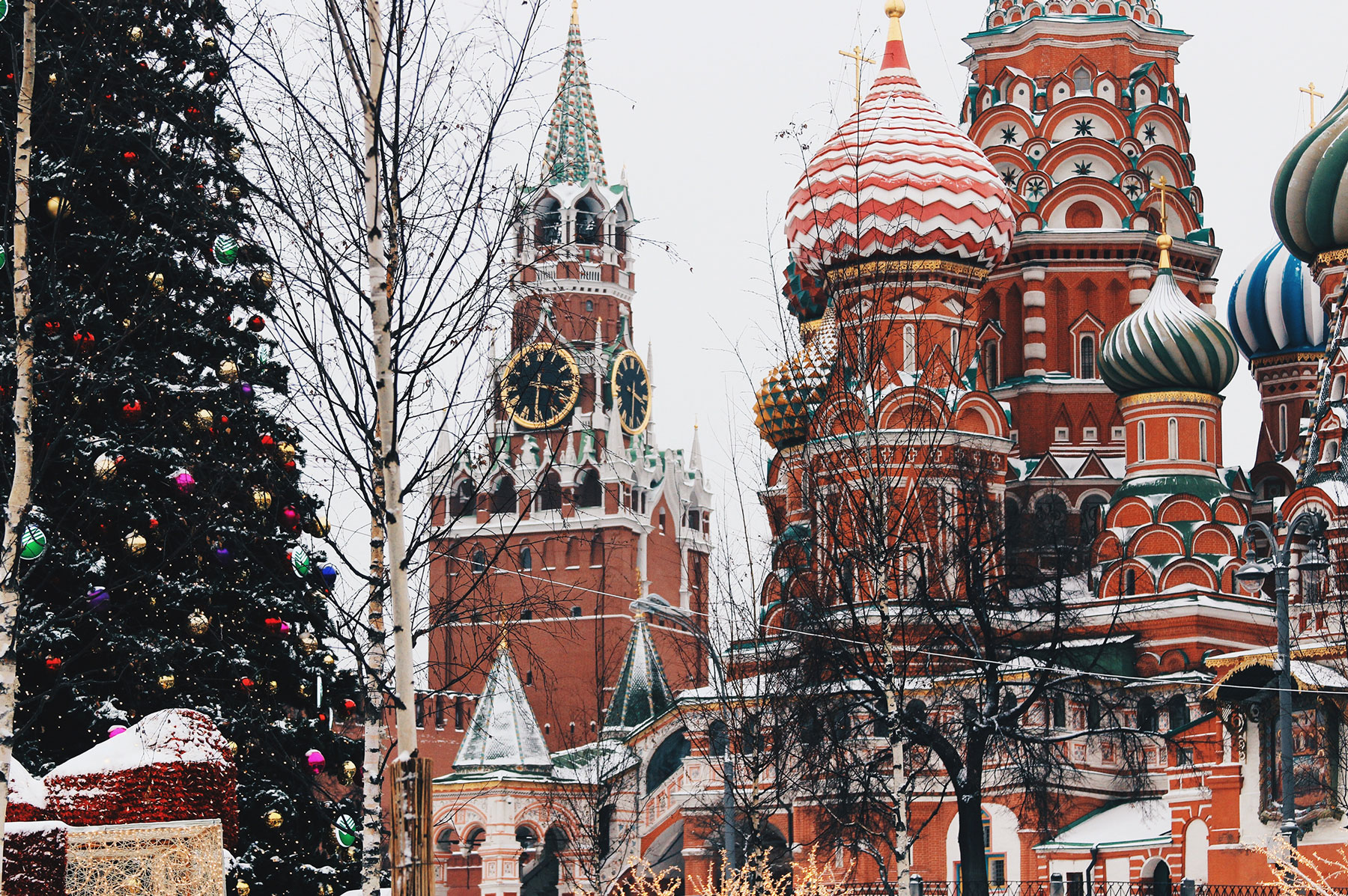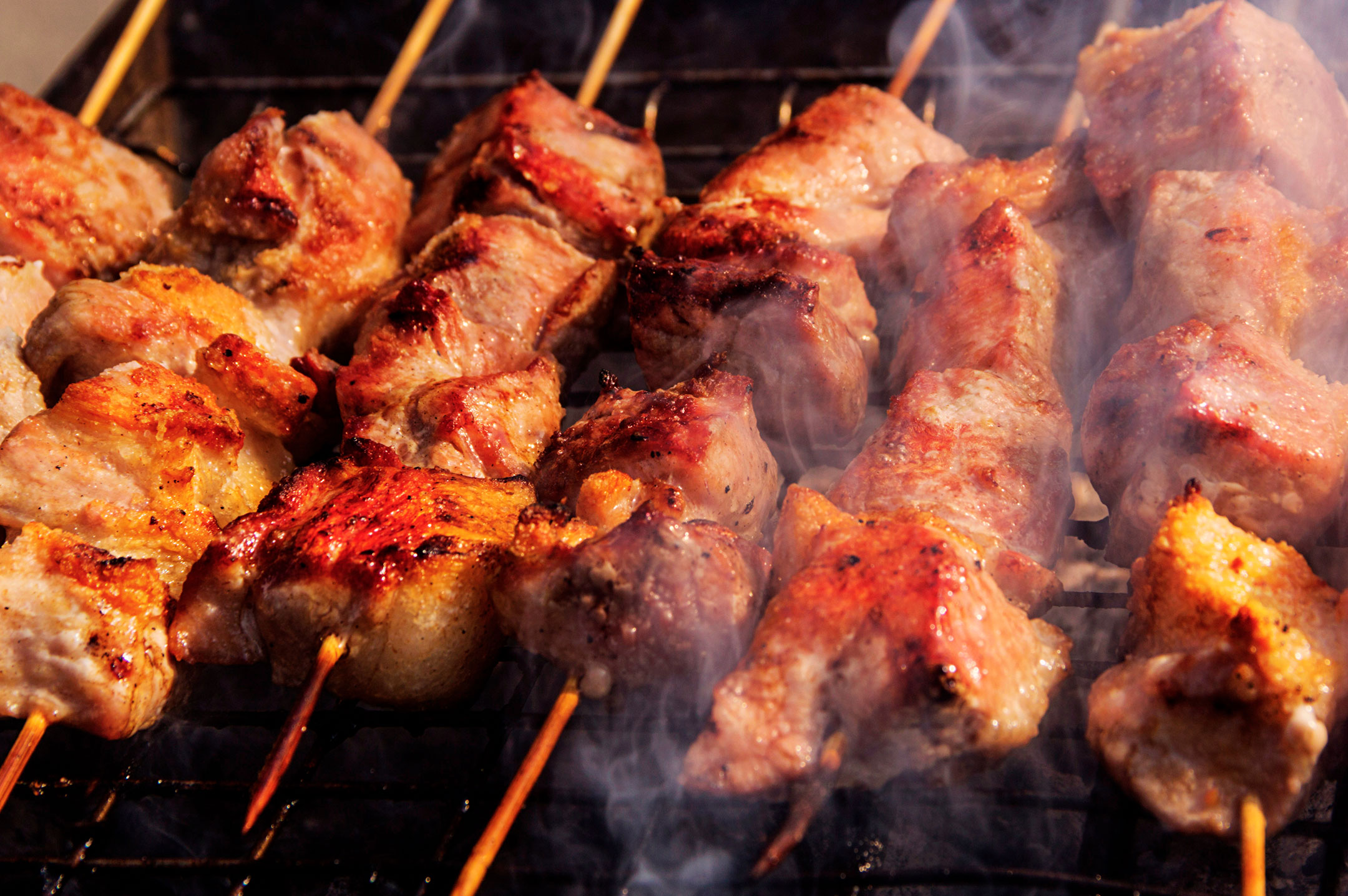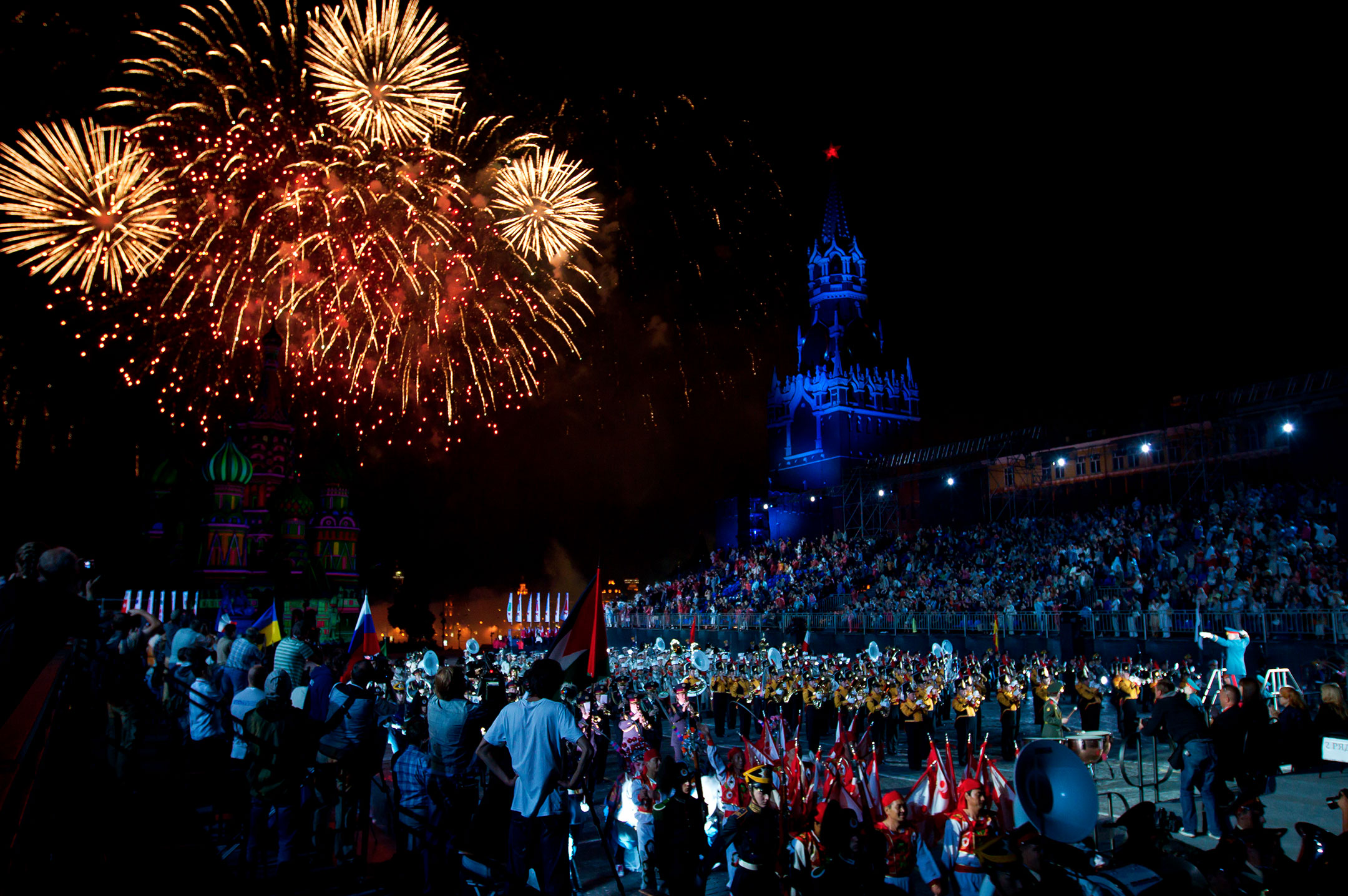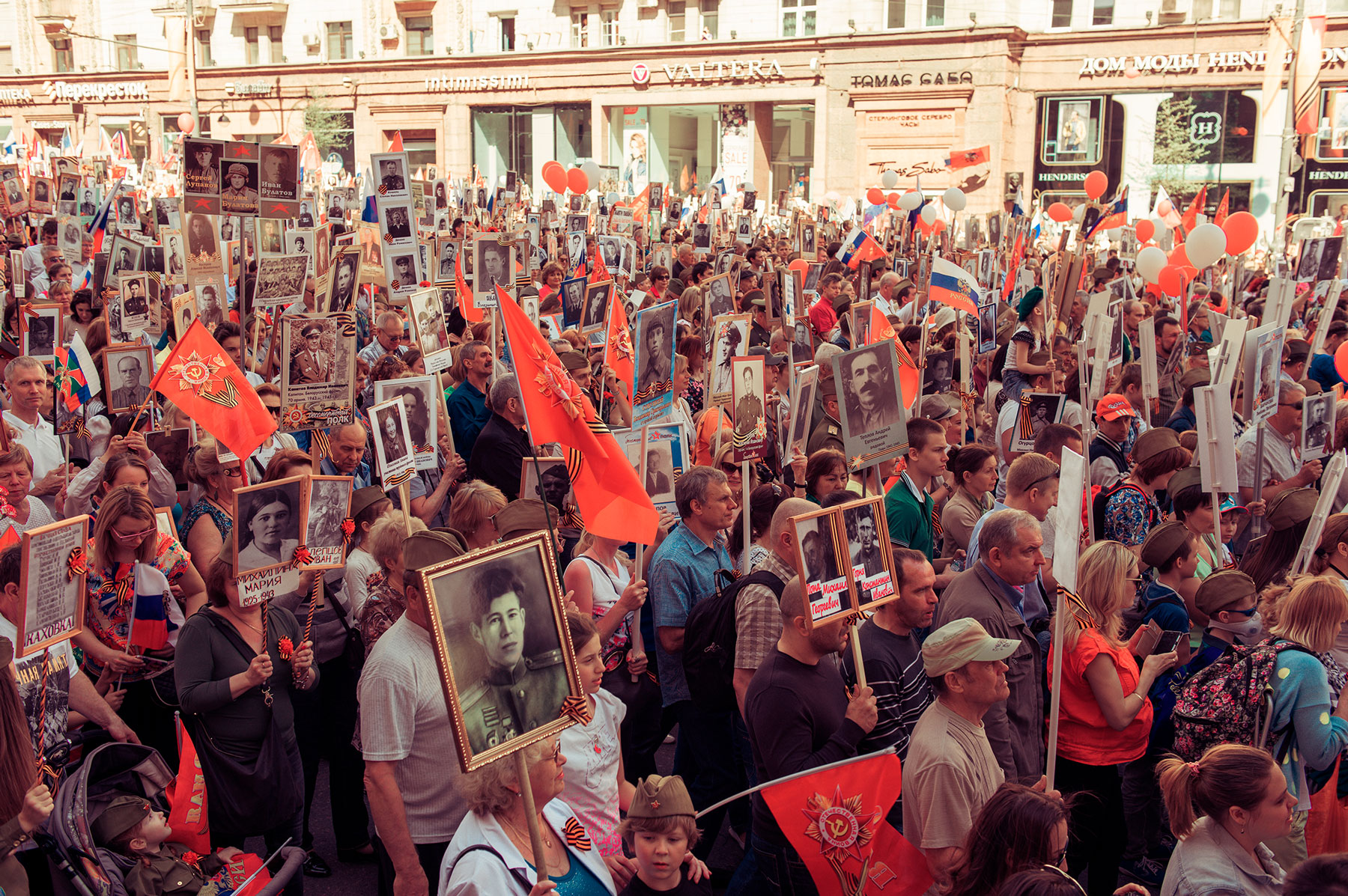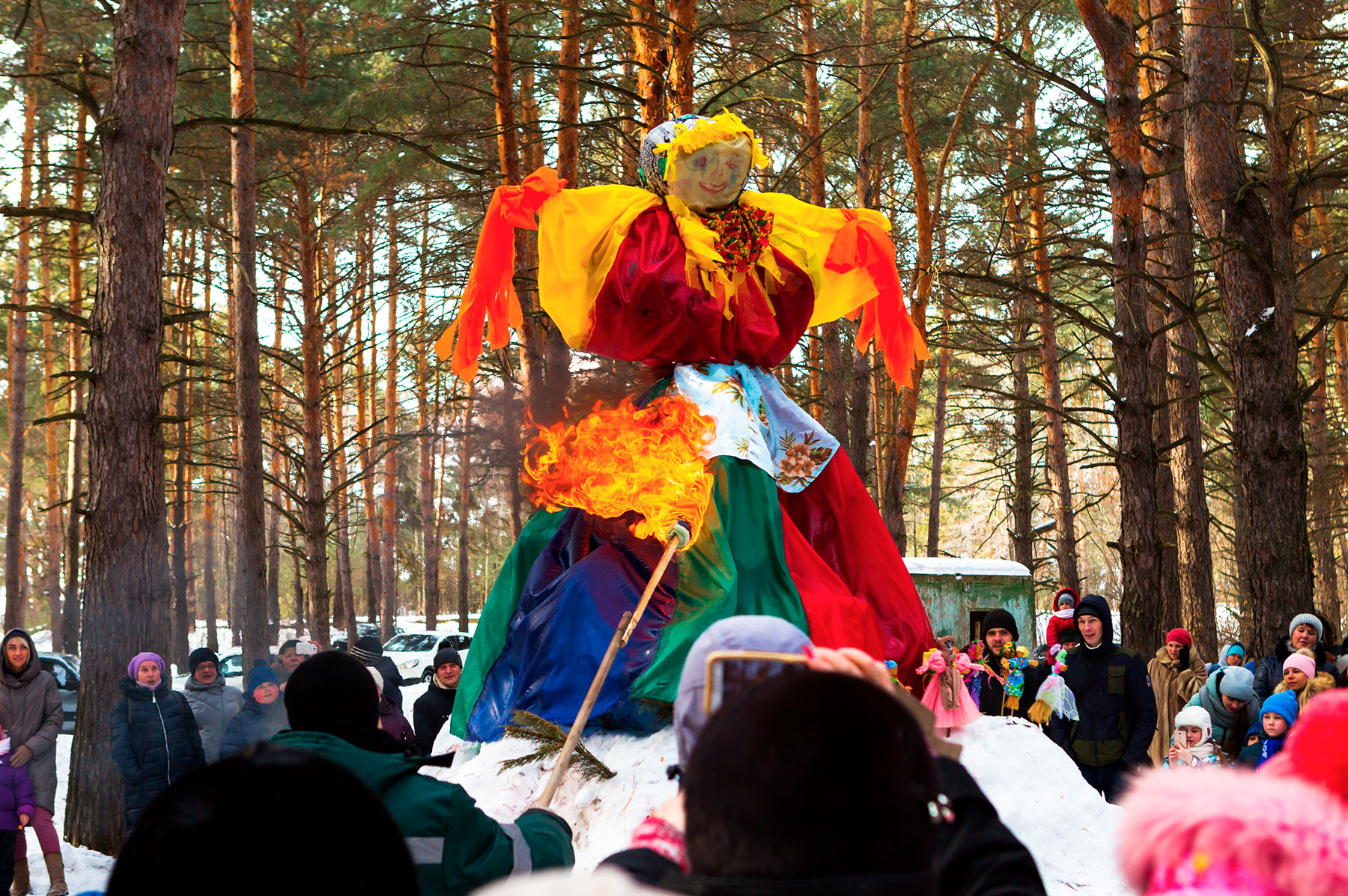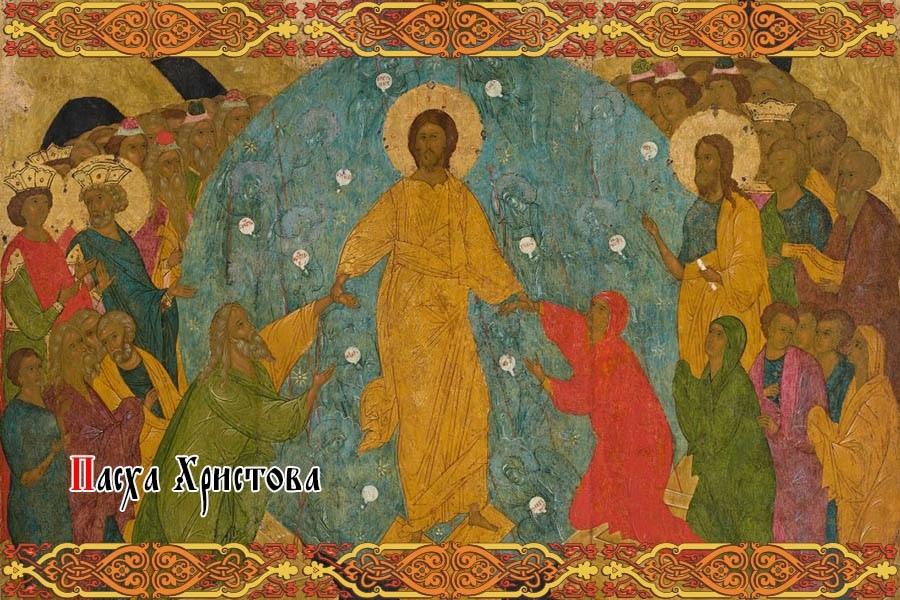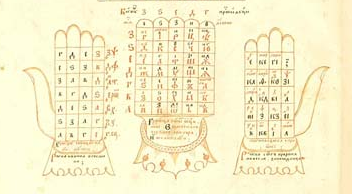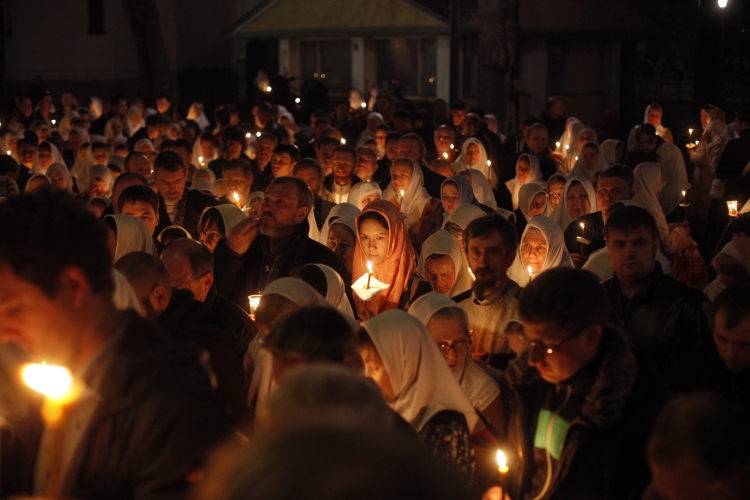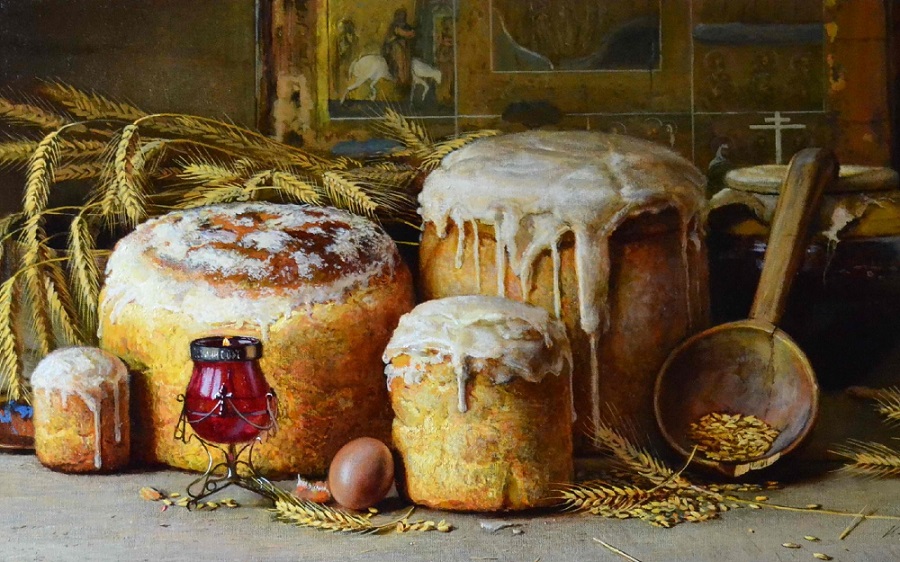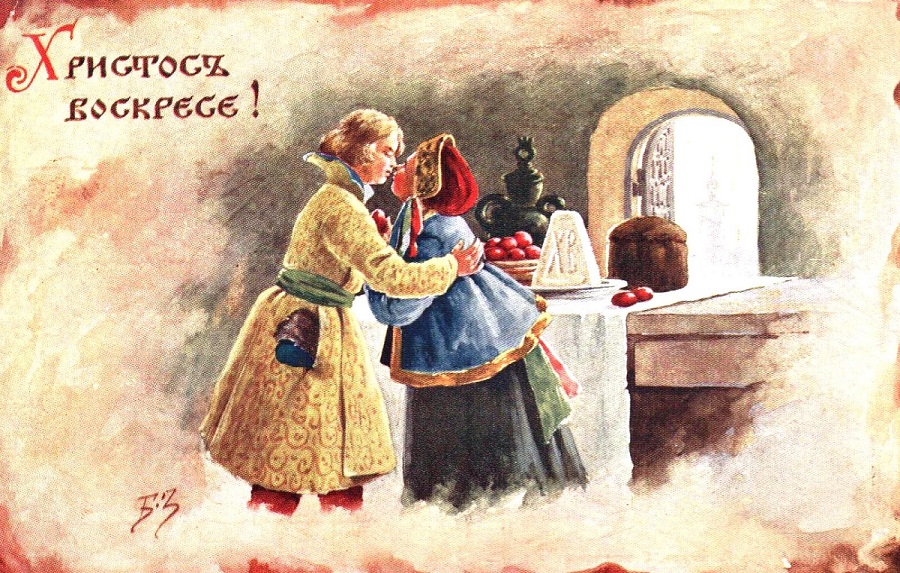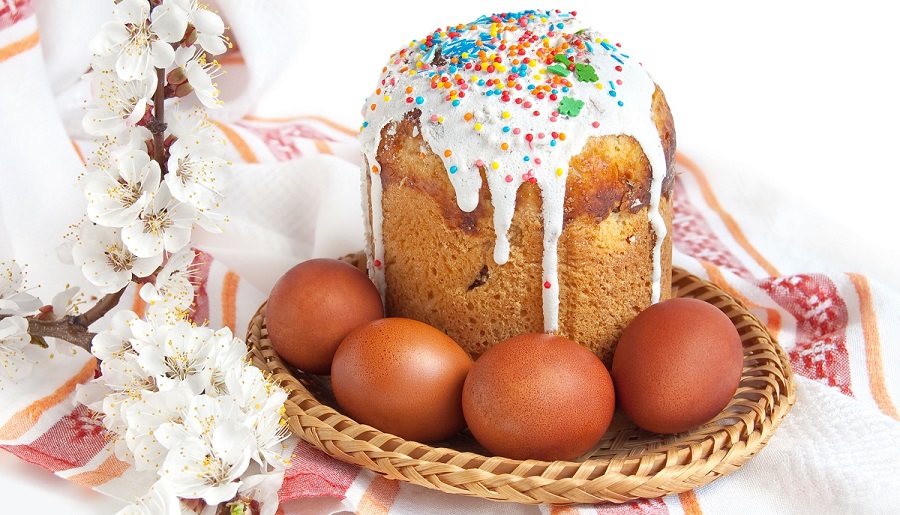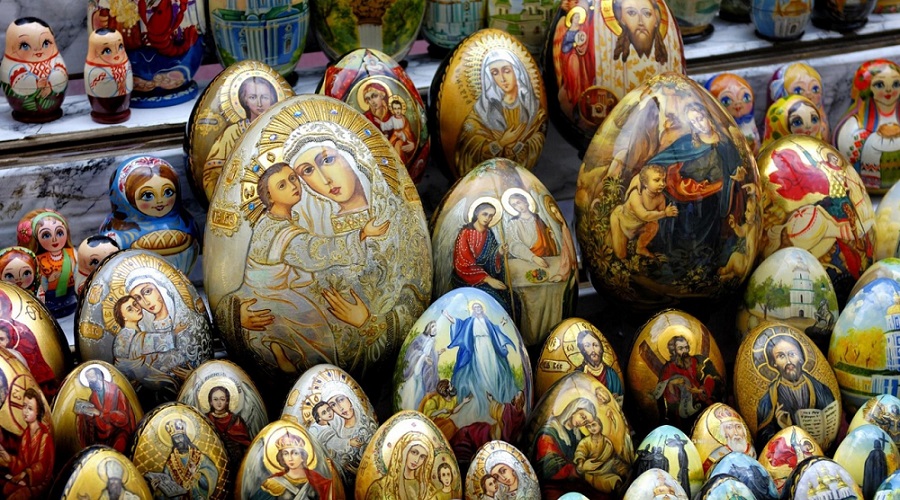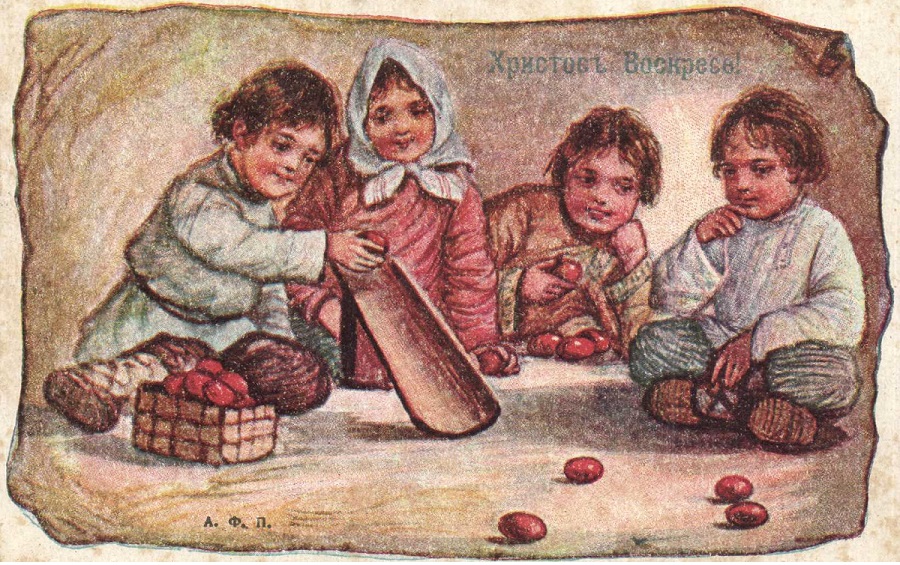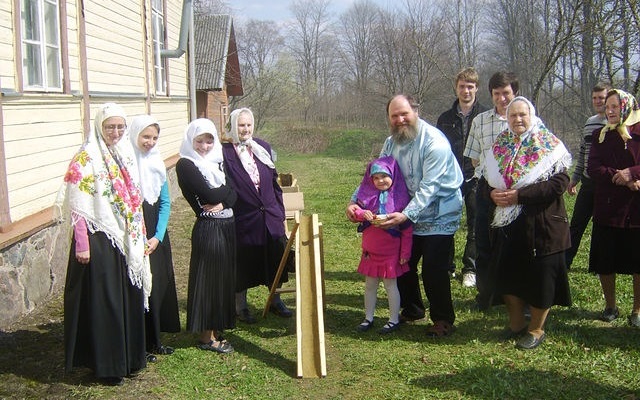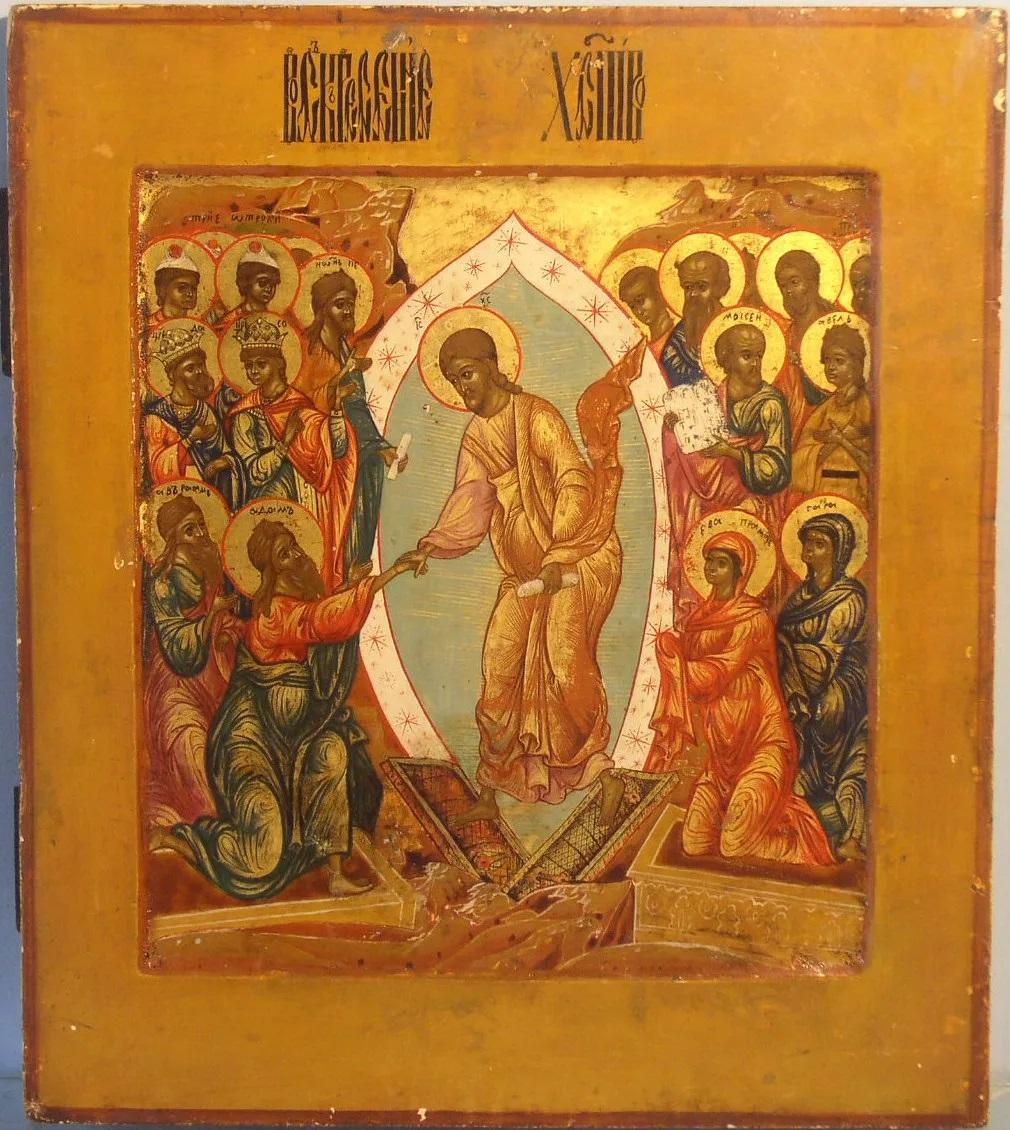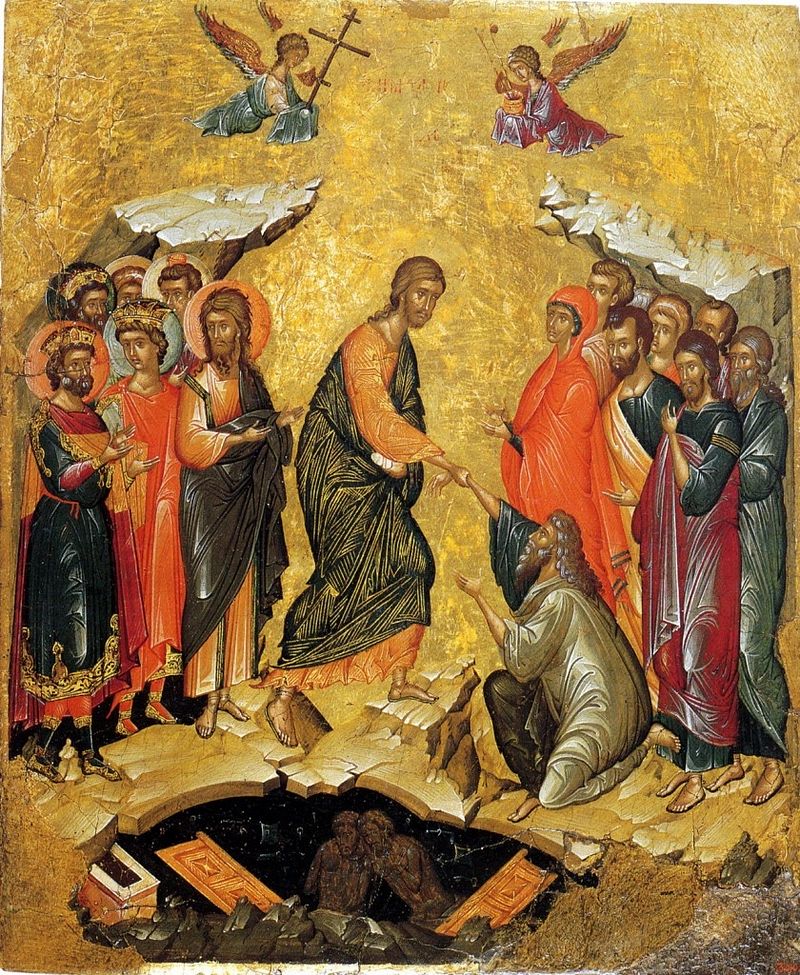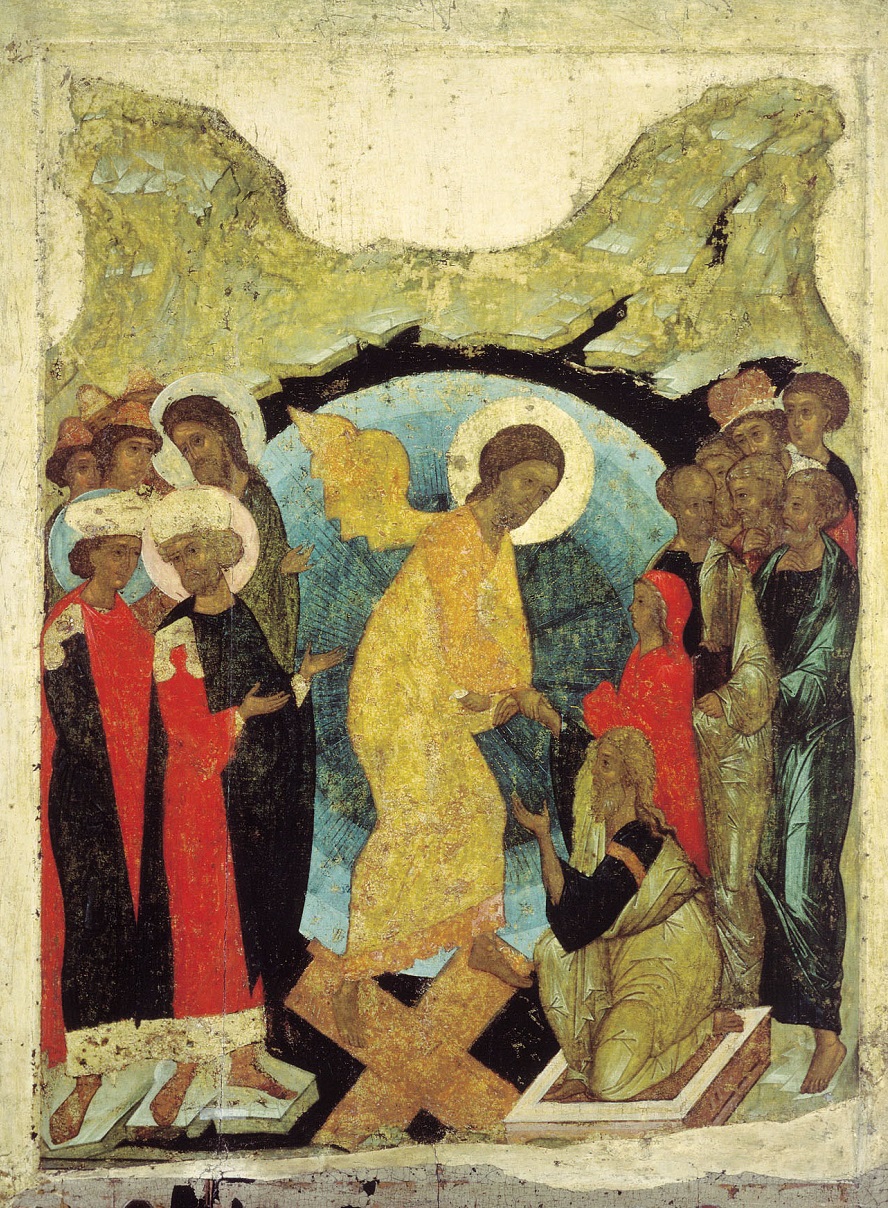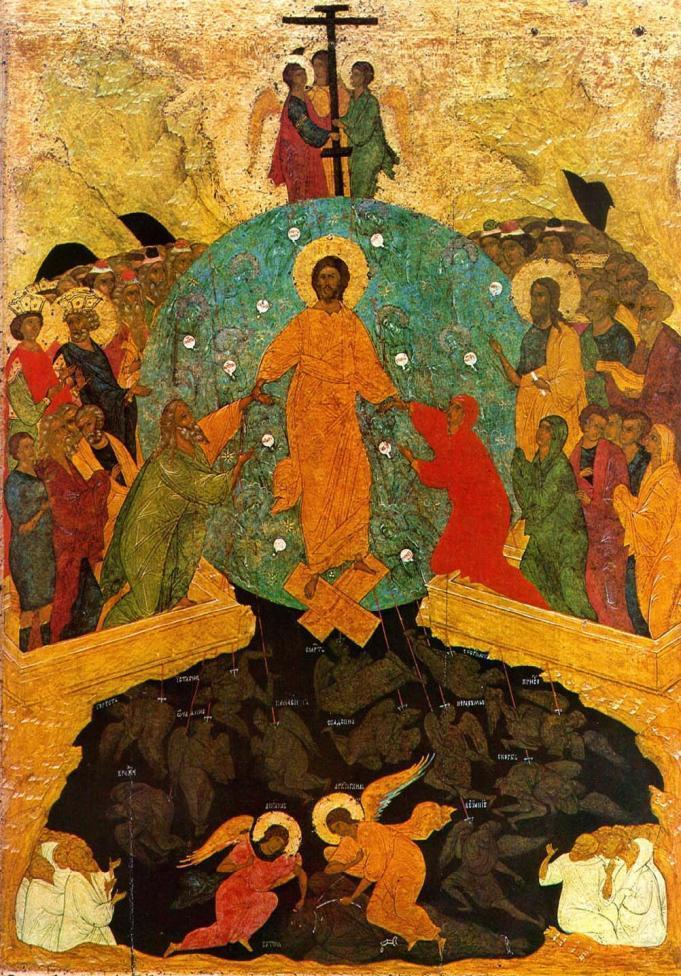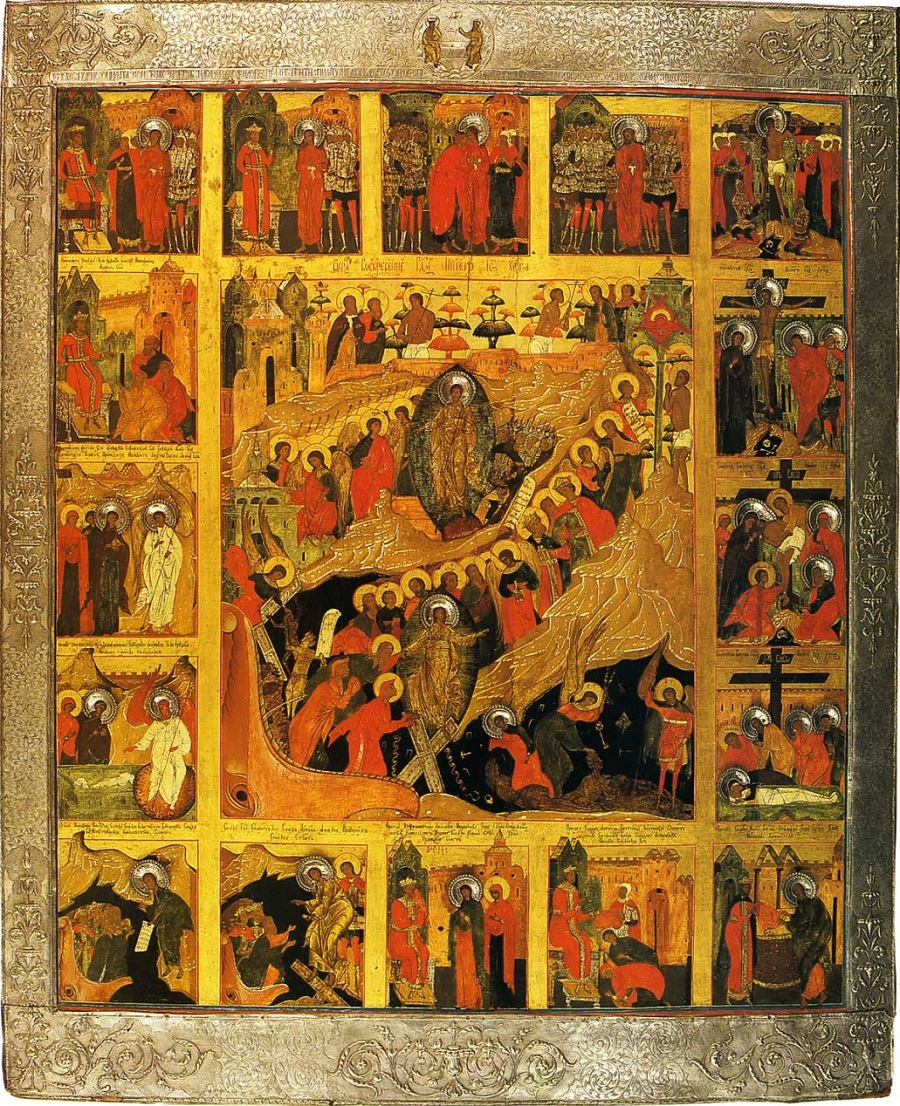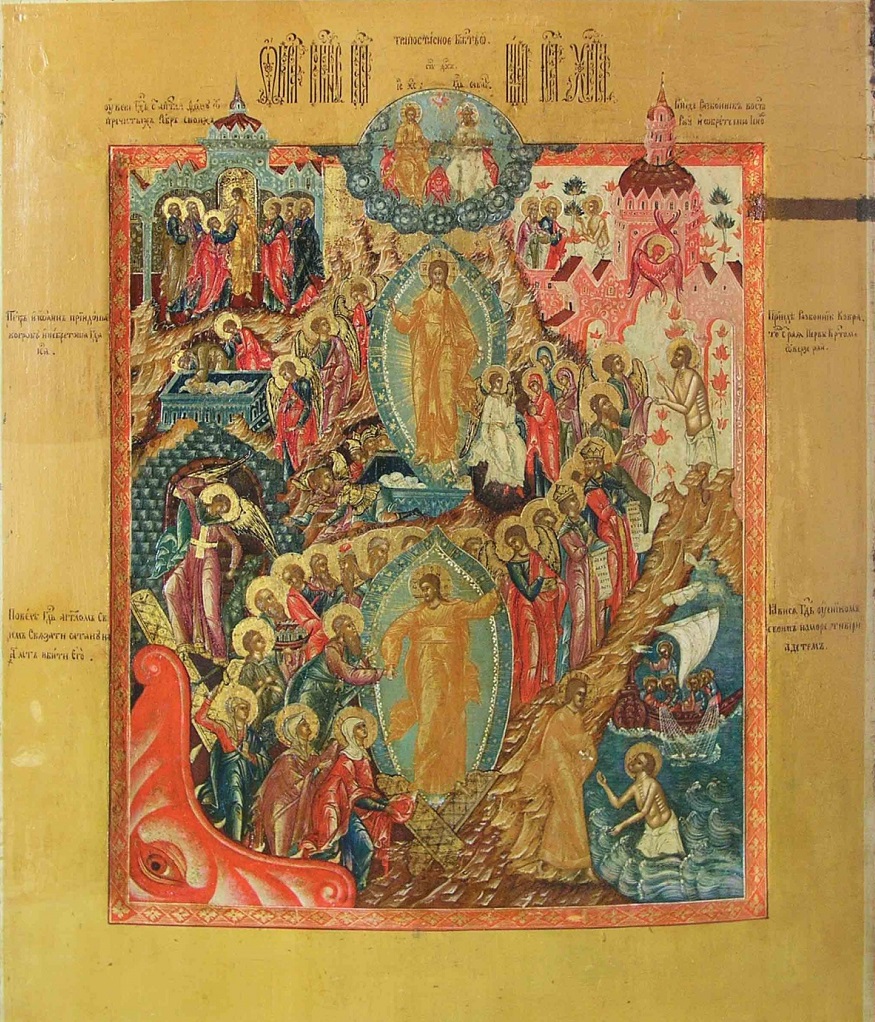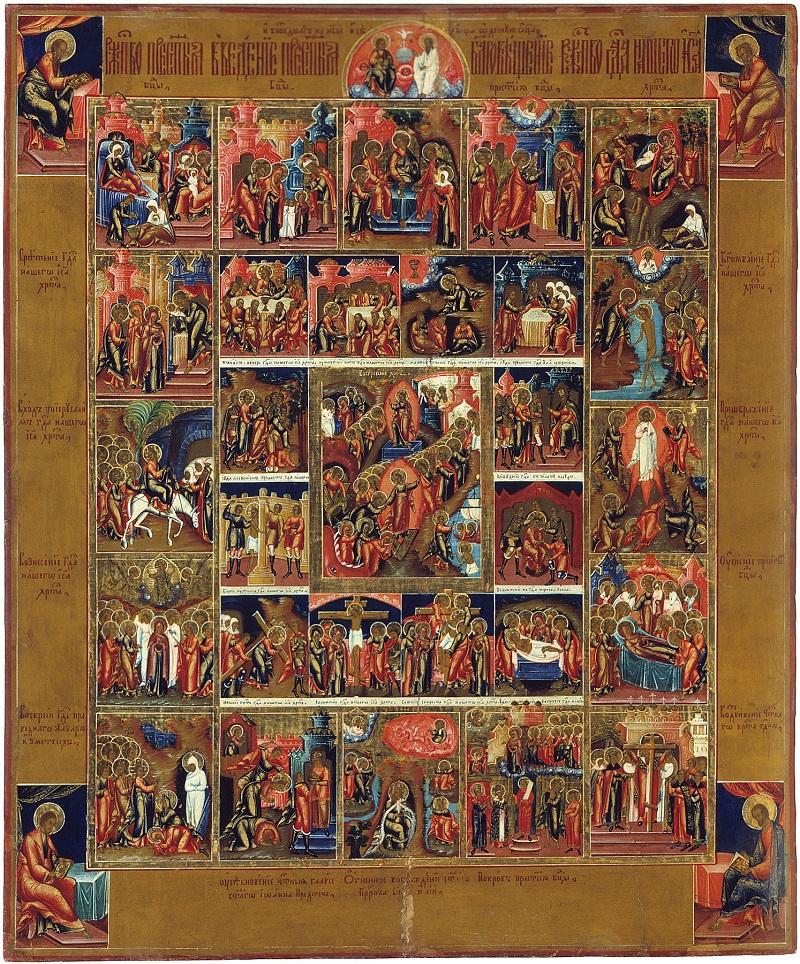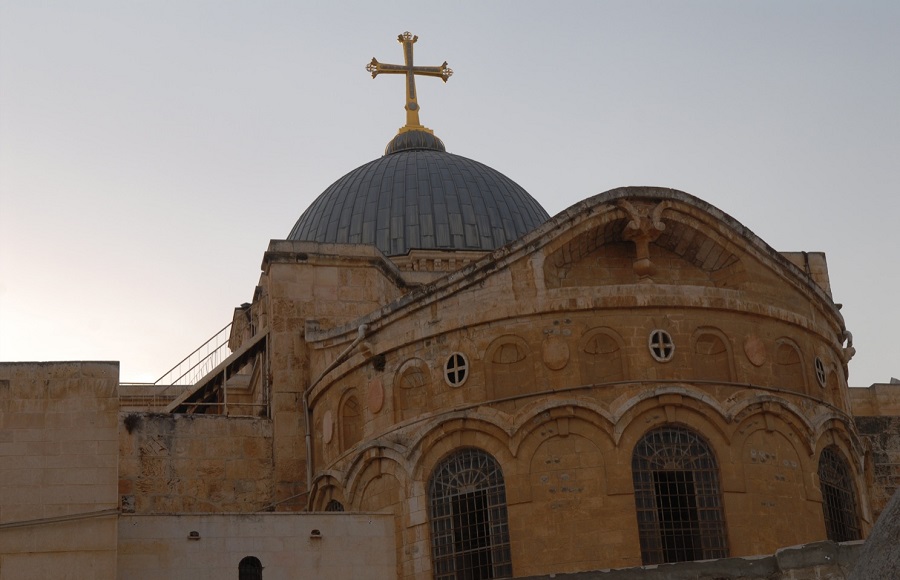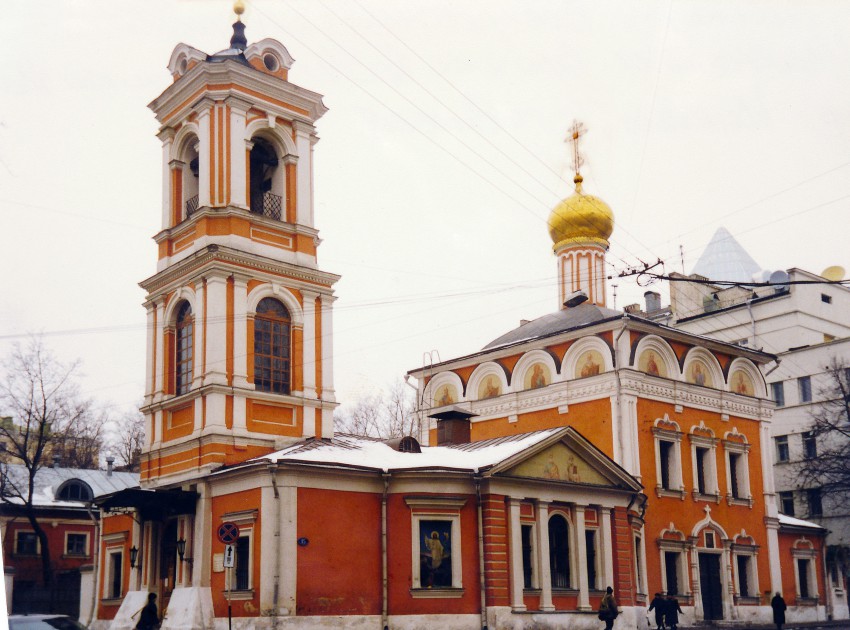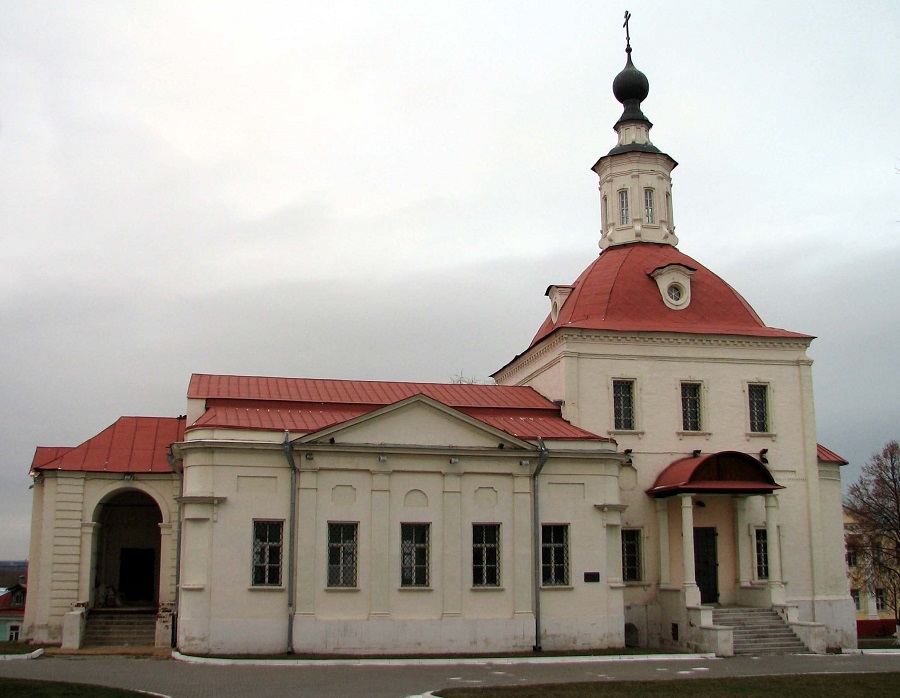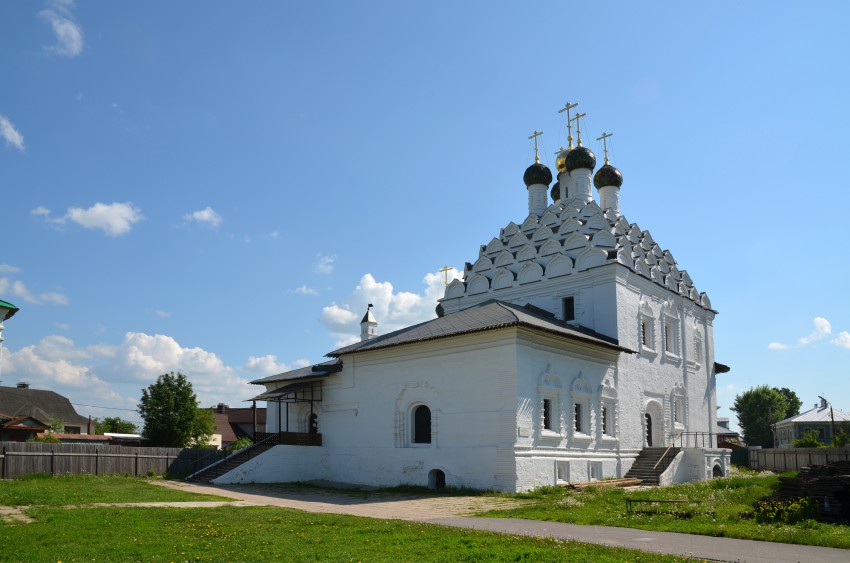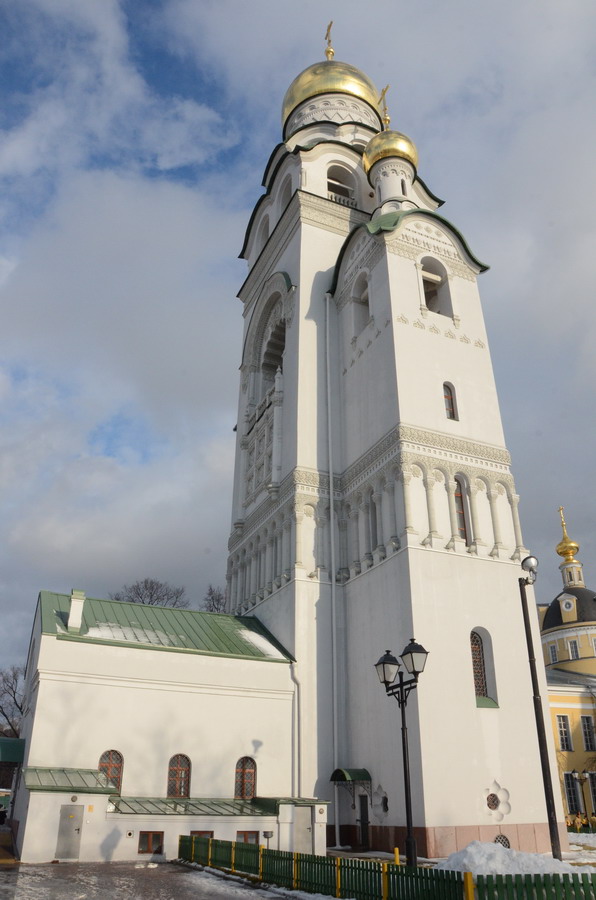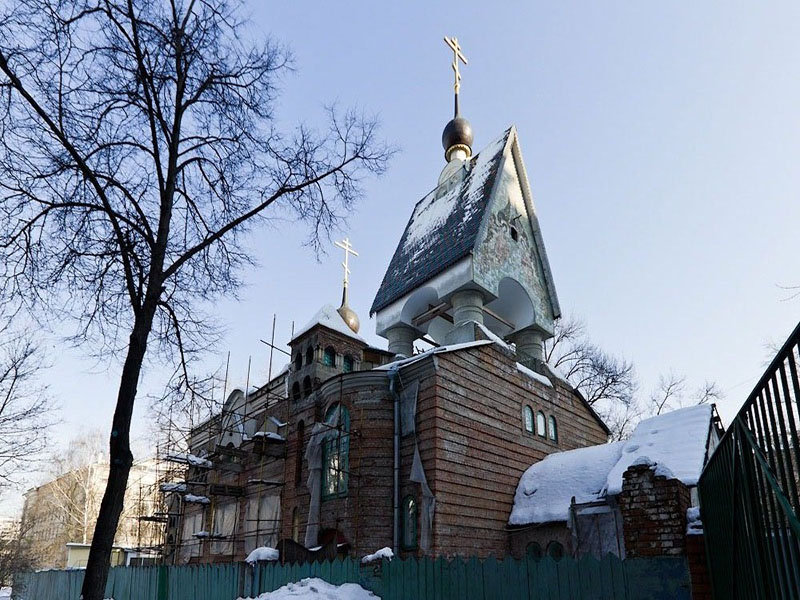Почему праздник Пасхи не является государственным праздником?
Объясните мне, пожалуйста, почему праздник Пасхи не объявлен государственным праздником, как например праздник Рождества? Виктор.
Отвечает протоиерей Александр Ильяшенко:
Здравствуйте, Виктор! Христос воскресе!
Думаю, Ваш вопрос уместнее было бы задать депутатам Государственной Думы, которые принимали поправки в Трудовой Кодекс, где были установлены праздничные дни, в том числе и празднование Рождества Христова как государственного праздника. Я же могу только предположить, что Пасха не отнесена к праздничным дням потому, что и так приходится на воскресный день, то есть нерабочий, день, и поэтому особо выделять этот праздник не стали. А праздник Рождества Христова может выпасть на любой день недели, поэтому, возможно, и было принято решение считать этот день праздничным и нерабочим.
С уважением, протоиерей Александр Ильяшенко.
- Много лет как безвозмездный донор сдаю кровь. Богоугодно ли это?
- Как себя вести, когда тебя оскорбляют в коллективе, покинуть который нельзя? Как быть смиренным и не стать всеобщим посмешищем?
- Можно ли заниматься сетевым маркетингом?
- Можно ли и нужно ли подавать милостыню?
Выходные дни на Пасху:
- 23.04 — суббота накануне праздника;
- 24.04 — Светлое Христово Воскресение.
В понедельник, 25 апреля, почти всем работающим гражданам придется выйти на службу.
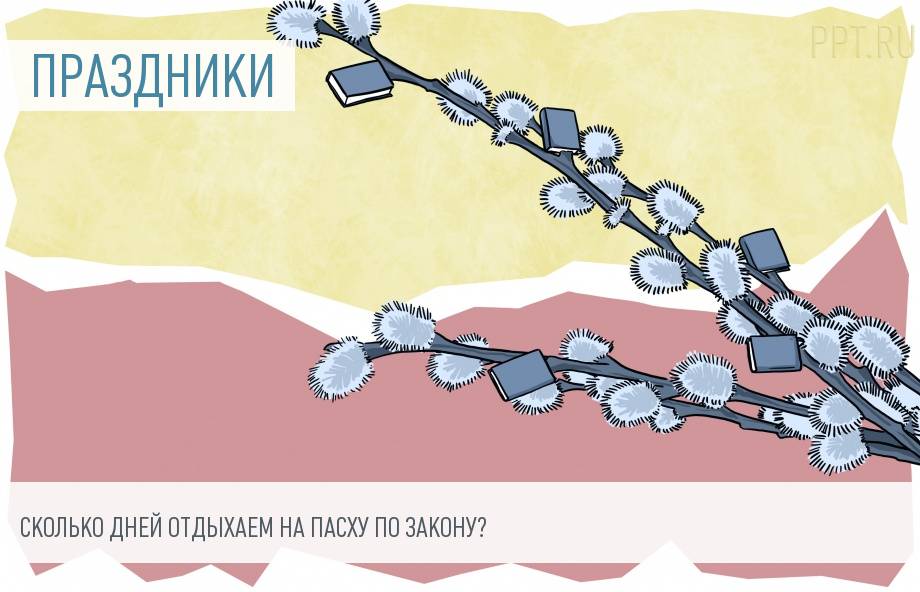
Праздник Пасхи всегда выпадает на воскресенье, но многих волнует вопрос: переносится Пасха на понедельник в России — нет, нормами Трудового кодекса РФ это не предусмотрено. Но в некоторых регионах РФ действуют специальные нормы, по которым главные религиозные христианские и мусульманские праздники объявлены нерабочими днями.
История и традиции
Сам праздник Светлого Христова Воскресения очень старый — ему больше тысячи лет, но в современную Россию он пришел в полной мере только после распада СССР. Хотя граждане и раньше пекли куличи, делали творожные пасхи, красили яйца, они редко соблюдали настоящие православные каноны, присущие этому торжеству. Сейчас же большинство православных россиян соблюдают праздничные дни на Пасху: ходят в церковь на всенощную службу, соблюдают пост перед праздником, посещают кладбища и поминают своих умерших родных.
Очевидно, что для исполнения всех пасхальных традиций мало одного воскресенья, на который он всегда выпадает. Но отдых в понедельник после Пасхи доступен для немногих граждан России, сама религиозная дата не является официальным государственным праздничным нерабочим днем. Это связано с тем, что Российская Федерация — многоконфессиональное государство, и религиозных поводов для торжества у ее граждан очень много, даже таких важных и значимых, как Светлое Воскресение. Более того, в статье 14 Конституции РФ Россия признана светским государством, в котором ни одна из церквей не вправе занимать лидирующее положение. Но есть в России регионы, где традиции верующих разных конфессий учтены при составлении производственного календаря, и Пасха считается праздничным днем в рабочем календаре, как и другие православные праздничные даты — Рождество и Троица. В некоторых регионах дополнительно дают людям нерабочий день на Радоницу, чтобы они могли посетить кладбище и помянуть умерших родных.
Торжество в 2022 году
В 2022 году Светлое Христово Воскресение православные будут отмечать 24 апреля. У этого религиозного события нет строго установленной даты, она ежегодно меняется. Выбирают день для празднования служители церкви. Для этого они используют особую методику, которая применяется уже много лет. В ней учитываются другие важные религиозные события и природные явления (полнолуние, солнцестояние). В ТК РФ указано, является ли Пасха государственным праздником, — нет, она не входит в закрытый перечень указанных там дат.
Государственные праздничные нерабочие дни
Все праздничные нерабочие даты перечислены в статье 112 Трудового кодекса РФ. Всего таких дат 8, но дней для отдыха больше, в честь новогодних каникул Россия отдыхает целых 5 дней. Полный перечень праздничных нерабочих дат из этой статьи выглядит так:
- 1-5 января — Новый год;
- 7 января — Рождество;
- 23 февраля — День защитника Отечества;
- 8 марта — Международный женский день;
- 1 мая — Праздник Весны и Труда;
- 9 мая — День Победы;
- 12 июня — День России;
- 4 ноября — День народного единства.
Из этого списка очевидно, что дополнительные выходные на Пасху в России официально не предусмотрены. А значит, не действует и норма статьи 112 ТК РФ о переносе выходного, совпавшего с праздником, на другую дату. Но сам праздник всегда совпадает с воскресеньем — календарным выходным днем, поэтому нет сомнений, как будем отдыхать на Пасху в 2022 году: в субботу и воскресенье.
Но есть регионы, в которых дела обстоят иначе, их власти на местном уровне определяют, Пасха выходной день или нет, ежегодно.
Пасхальные выходные дни в регионах РФ
Субъекты РФ, в соответствии с Конституцией, вправе устанавливать собственные праздничные нерабочие дни. К примеру, Светлое Христово Воскресение — национальный праздник в Республике Крым. И если смотреть, когда выходные на Пасху в этом регионе, то их три:
- суббота — 23 апреля;
- воскресенье — 24-ое число;
- понедельник — 25.04.
Кстати, в этих регионах проживают много мусульман. Их главные религиозные праздники отмечены в местных производственных календарях как нерабочие даты. В других российских регионах с преобладающим мусульманским населением, в частности, в Татарстане, Адыгее, Дагестане, Ингушетии, Кабардино-Балкарии, Карачаево-Черкесии, Чечне и Башкортостане, все граждане отдыхают в дни Курбан-Байрама и Ураза-Байрама. Возможно, в недалеком будущем регионы РФ с преобладающим православным населением примут такие же местные законы, и Светлое Христово Воскресение станет праздничным нерабочим днем, а значит, и ответ на вопрос, сколько дней отдыхают на Пасху в России, — 3 дня, станет общим для большинства субъектов РФ.
Подробнее о региональных праздниках и выходных днях: «Как отдыхаем в 2022: официальные выходные в России и субъектах РФ».

Дидух Юлия
бухгалтер, юрист
В 1998 году закончила КГАУ, экономический факультет по специальности бухгалтер. В 2006 году ТНУ, юридический факультет по специальности гражданское и предпринимательское право. Опыт работы бухгалтером с 1998 по 2007 год. Пишу статьи с 2012 года
Все статьи автора
This article is about the Christian and cultural festival. For other uses, see Easter (disambiguation).
| Easter | |
|---|---|
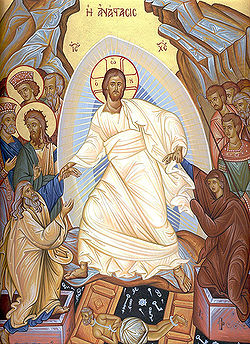
Icon of the Resurrection depicting Christ having destroyed the gates of hell and removing Adam and Eve from the grave. Christ is flanked by saints, and Satan, depicted as an old man, is bound and chained. |
|
| Observed by | Christians |
| Significance | Celebrates the resurrection of Jesus |
| Celebrations | Church services, festive family meals, Easter egg decoration, and gift-giving |
| Observances | Prayer, all-night vigil, sunrise service |
| Date | Variable, determined by the Computus |
| 2022 date |
|
| 2023 date |
|
| 2024 date |
|
| 2025 date |
|
| Related to | Passover, Septuagesima, Sexagesima, Quinquagesima, Shrove Tuesday, Ash Wednesday, Clean Monday, Lent, Great Lent, Palm Sunday, Holy Week, Maundy Thursday, Good Friday, and Holy Saturday which lead up to Easter; and Divine Mercy Sunday, Ascension, Pentecost, Trinity Sunday, Corpus Christi and Feast of the Sacred Heart which follow it. |
Easter,[nb 1] also called Pascha[nb 2] (Aramaic, Greek, Latin) or Resurrection Sunday,[nb 3] is a Christian festival and cultural holiday commemorating the resurrection of Jesus from the dead, described in the New Testament as having occurred on the third day of his burial following his crucifixion by the Romans at Calvary c. 30 AD.[12][13] It is the culmination of the Passion of Jesus Christ, preceded by Lent (or Great Lent), a 40-day period of fasting, prayer, and penance.
Easter-observing Christians commonly refer to the week before Easter as Holy Week, which in Western Christianity begins on Palm Sunday (marking the entrance of Jesus in Jerusalem), includes Spy Wednesday (on which the betrayal of Jesus is mourned),[14] and contains the days of the Easter Triduum including Maundy Thursday, commemorating the Maundy and Last Supper,[15][16] as well as Good Friday, commemorating the crucifixion and death of Jesus.[17] In Eastern Christianity, the same days and events are commemorated with the names of days all starting with «Holy» or «Holy and Great»; and Easter itself might be called «Great and Holy Pascha», «Easter Sunday», «Pascha» or «Sunday of Pascha». In Western Christianity, Eastertide, or the Easter Season, begins on Easter Sunday and lasts seven weeks, ending with the coming of the 50th day, Pentecost Sunday. In Eastern Christianity, the Paschal season ends with Pentecost as well, but the leave-taking of the Great Feast of Pascha is on the 39th day, the day before the Feast of the Ascension.
Easter and its related holidays are moveable feasts, not falling on a fixed date; its date is computed based on a lunisolar calendar (solar year plus Moon phase) similar to the Hebrew calendar. The First Council of Nicaea (325) established only two rules, namely independence from the Hebrew calendar and worldwide uniformity. No details for the computation were specified; these were worked out in practice, a process that took centuries and generated a number of controversies. It has come to be the first Sunday after the ecclesiastical full moon that occurs on or soonest after 21 March.[18] Even if calculated on the basis of the more accurate Gregorian calendar, the date of that full moon sometimes differs from that of the astronomical first full moon after the March equinox.[19]
The English term is derived from the Saxon spring festival Ēostre; Easter is also linked to the Jewish Passover by its name (Hebrew: פֶּסַח pesach, Aramaic: פָּסחָא pascha are the basis of the term Pascha), by its origin (according to the synoptic Gospels, both the crucifixion and the resurrection took place during the week of Passover)[20][21] and by much of its symbolism, as well as by its position in the calendar. In most European languages, both the Christian Easter and the Jewish Passover are called by the same name; and in the older English versions of the Bible, as well, the term Easter was used to translate Passover.[22] Easter customs vary across the Christian world, and include sunrise services, midnight vigils, exclamations and exchanges of Paschal greetings, clipping the church (England),[23] decoration and the communal breaking of Easter eggs (a symbol of the empty tomb).[24][25][26] The Easter lily, a symbol of the resurrection in Western Christianity,[27][28] traditionally decorates the chancel area of churches on this day and for the rest of Eastertide.[29] Additional customs that have become associated with Easter and are observed by both Christians and some non-Christians include Easter parades, communal dancing (Eastern Europe), the Easter Bunny and egg hunting.[30][31][32][33][34] There are also traditional Easter foods that vary by region and culture.
Etymology
The modern English term Easter, cognate with modern Dutch ooster and German Ostern, developed from an Old English word that usually appears in the form Ēastrun, -on, or -an; but also as Ēastru, -o; and Ēastre or Ēostre.[nb 4] Bede provides the only documentary source for the etymology of the word, in his eighth-century The Reckoning of Time. He wrote that Ēosturmōnaþ (Old English ‘Month of Ēostre’, translated in Bede’s time as «Paschal month») was an English month, corresponding to April, which he says «was once called after a goddess of theirs named Ēostre, in whose honour feasts were celebrated in that month».[35]
In Latin and Greek, the Christian celebration was, and still is, called Pascha (Greek: Πάσχα), a word derived from Aramaic פסחא (Paskha), cognate to Hebrew פֶּסַח (Pesach). The word originally denoted the Jewish festival known in English as Passover, commemorating the Jewish Exodus from slavery in Egypt.[36][37] As early as the 50s of the 1st century, Paul the Apostle, writing from Ephesus to the Christians in Corinth,[38] applied the term to Christ, and it is unlikely that the Ephesian and Corinthian Christians were the first to hear Exodus 12 interpreted as speaking about the death of Jesus, not just about the Jewish Passover ritual.[39] In most languages, Germanic languages such as English being exceptions, the feast is known by names derived from Greek and Latin Pascha.[9][40] Pascha is also a name by which Jesus himself is remembered in the Orthodox Church, especially in connection with his resurrection and with the season of its celebration.[41] Others call the holiday «Resurrection Sunday» or «Resurrection Day,» after the Greek: Ἀνάστασις, romanized: Anastasis, lit. ‘Resurrection’ day.[10][11][42][43]
Theological significance
Easter celebrates Jesus’ supernatural resurrection from the dead, which is one of the chief tenets of the Christian faith.[44] The resurrection established Jesus as the Son of God and is cited as proof that God will righteously judge the world.[45] Paul writes that, for those who trust in Jesus’s death and resurrection, «death is swallowed up in victory.» The First Epistle of Peter declares that God has given believers «a new birth into a living hope through the resurrection of Jesus Christ from the dead». Christian theology holds that, through faith in the working of God, those who follow Jesus are spiritually resurrected with him so that they may walk in a new way of life and receive eternal salvation, and can hope to be physically resurrected to dwell with him in the Kingdom of Heaven.[45]
Easter is linked to Passover and the Exodus from Egypt recorded in the Old Testament through the Last Supper, sufferings, and crucifixion of Jesus that preceded the resurrection.[40] According to the three Synoptic Gospels, Jesus gave the Passover meal a new meaning, as in the upper room during the Last Supper he prepared himself and his disciples for his death.[40] He identified the bread and cup of wine as his body, soon to be sacrificed, and his blood, soon to be shed. The Apostle Paul states, in his First Epistle to the Corinthians, «Get rid of the old yeast that you may be a new batch without yeast—as you really are. For Christ, our Passover lamb, has been sacrificed. This refers to the requirement in Jewish law that Jews eliminate all chametz, or leavening, from their homes in advance of Passover, and to the allegory of Jesus as the Paschal lamb.[46][47]
Early Christianity
The Last Supper celebrated by Jesus and his disciples. The early Christians, too, would have celebrated this meal to commemorate Jesus’s death and subsequent resurrection.
As the Gospels affirm that both the crucifixion and resurrection of Jesus during the week of Passover, the first Christians timed the observance of the annual celebration of the resurrections in relation to Passover.[48] Direct evidence for a more fully formed Christian festival of Pascha (Easter) begins to appear in the mid-2nd century. Perhaps the earliest extant primary source referring to Easter is a mid-2nd-century Paschal homily attributed to Melito of Sardis, which characterizes the celebration as a well-established one.[49] Evidence for another kind of annually recurring Christian festival, those commemorating the martyrs, began to appear at about the same time as the above homily.[50]
While martyrs’ days (usually the individual dates of martyrdom) were celebrated on fixed dates in the local solar calendar, the date of Easter was fixed by means of the local Jewish[51] lunisolar calendar. This is consistent with the celebration of Easter having entered Christianity during its earliest, Jewish, period, but does not leave the question free of doubt.[52]
The ecclesiastical historian Socrates Scholasticus attributes the observance of Easter by the church to the perpetuation of pre-Christian custom, «just as many other customs have been established», stating that neither Jesus nor his Apostles enjoined the keeping of this or any other festival. Although he describes the details of the Easter celebration as deriving from local custom, he insists the feast itself is universally observed.[53]
Date
A stained-glass window depicting the Passover Lamb, a concept integral to the foundation of Easter[40][54]
Easter and the holidays that are related to it are moveable feasts, in that they do not fall on a fixed date in the Gregorian or Julian calendars (both of which follow the cycle of the sun and the seasons). Instead, the date for Easter is determined on a lunisolar calendar similar to the Hebrew calendar. The First Council of Nicaea (325) established two rules, independence of the Jewish calendar and worldwide uniformity, which were the only rules for Easter explicitly laid down by the Council. No details for the computation were specified; these were worked out in practice, a process that took centuries and generated a number of controversies. (See also Computus and Reform of the date of Easter.) In particular, the Council did not decree that Easter must fall on Sunday, but this was already the practice almost everywhere.[55][incomplete short citation]
In Western Christianity, using the Gregorian calendar, Easter always falls on a Sunday between 22 March and 25 April,[56] within about seven days after the astronomical full moon.[57] The following day, Easter Monday, is a legal holiday in many countries with predominantly Christian traditions.[58]
Eastern Orthodox Christians base Paschal date calculations on the Julian Calendar. Because of the thirteen-day difference between the calendars between 1900 and 2099, 21 March corresponds, during the 21st century, to 3 April in the Gregorian Calendar. Since the Julian calendar is no longer used as the civil calendar of the countries where Eastern Christian traditions predominate, Easter varies between 4 April and 8 May in the Gregorian calendar. Also, because the Julian «full moon» is always several days after the astronomical full moon, the eastern Easter is often later, relative to the visible lunar phases, than western Easter.[59]
Among the Oriental Orthodox, some churches have changed from the Julian to the Gregorian calendar and the date for Easter, as for other fixed and moveable feasts, is the same as in the Western church.[60]
Computations
In 725, Bede succinctly wrote, «The Sunday following the full Moon which falls on or after the equinox will give the lawful Easter.»[61] However, this does not precisely reflect the ecclesiastical rules. The full moon referred to (called the Paschal full moon) is not an astronomical full moon, but the 14th day of a lunar month. Another difference is that the astronomical equinox is a natural astronomical phenomenon, which can fall on 19, 20 or 21 March,[62] while the ecclesiastical date is fixed by convention on 21 March.[63]
In applying the ecclesiastical rules, Christian churches use 21 March as the starting point in determining the date of Easter, from which they find the next full moon, etc. The Eastern Orthodox and Oriental Orthodox Churches continue to use the Julian calendar. Their starting point in determining the date of Orthodox Easter is also 21 March but according to the Julian reckoning, which in the current century corresponds to 3 April in the Gregorian calendar.[citation needed]
In addition, the lunar tables of the Julian calendar are currently five days behind those of the Gregorian calendar. Therefore, the Julian computation of the Paschal full moon is a full five days later than the astronomical full moon. The result of this combination of solar and lunar discrepancies is divergence in the date of Easter in most years (see table).[64]
Easter is determined on the basis of lunisolar cycles. The lunar year consists of 30-day and 29-day lunar months, generally alternating, with an embolismic month added periodically to bring the lunar cycle into line with the solar cycle. In each solar year (1 January to 31 December inclusive), the lunar month beginning with an ecclesiastical new moon falling in the 29-day period from 8 March to 5 April inclusive is designated as the paschal lunar month for that year.[65]
Easter is the third Sunday in the paschal lunar month, or, in other words, the Sunday after the paschal lunar month’s 14th day. The 14th of the paschal lunar month is designated by convention as the Paschal full moon, although the 14th of the lunar month may differ from the date of the astronomical full moon by up to two days.[65] Since the ecclesiastical new moon falls on a date from 8 March to 5 April inclusive, the paschal full moon (the 14th of that lunar month) must fall on a date from 22 March to 18 April inclusive.[64]
The Gregorian calculation of Easter was based on a method devised by the Calabrian doctor Aloysius Lilius (or Lilio) for adjusting the epacts of the Moon,[66] and has been adopted by almost all Western Christians and by Western countries which celebrate national holidays at Easter. For the British Empire and colonies, a determination of the date of Easter Sunday using Golden Numbers and Sunday letters was defined by the Calendar (New Style) Act 1750 with its Annexe. This was designed to match exactly the Gregorian calculation.[citation needed]
Controversies over the date
A five-part Russian Orthodox icon depicting the Easter story.
Eastern Orthodox Christians use a different computation for the date of Easter than the Western churches.
The precise date of Easter has at times been a matter of contention. By the later 2nd century, it was widely accepted that the celebration of the holiday was a practice of the disciples and an undisputed tradition. The Quartodeciman controversy, the first of several Easter controversies, arose concerning the date on which the holiday should be celebrated.[citation needed]
The term «Quartodeciman» refers to the practice of ending the Lenten fast on Nisan 14 of the Hebrew calendar, «the LORD‘s passover».[67] According to the church historian Eusebius, the Quartodeciman Polycarp (bishop of Smyrna, by tradition a disciple of John the Apostle) debated the question with Anicetus (bishop of Rome). The Roman province of Asia was Quartodeciman, while the Roman and Alexandrian churches continued the fast until the Sunday following (the Sunday of Unleavened Bread), wishing to associate Easter with Sunday. Neither Polycarp nor Anicetus persuaded the other, but they did not consider the matter schismatic either, parting in peace and leaving the question unsettled.[citation needed]
Controversy arose when Victor, bishop of Rome a generation after Anicetus, attempted to excommunicate Polycrates of Ephesus and all other bishops of Asia for their Quartodecimanism. According to Eusebius, a number of synods were convened to deal with the controversy, which he regarded as all ruling in support of Easter on Sunday.[68] Polycrates (circa 190), however, wrote to Victor defending the antiquity of Asian Quartodecimanism. Victor’s attempted excommunication was apparently rescinded, and the two sides reconciled upon the intervention of bishop Irenaeus and others, who reminded Victor of the tolerant precedent of Anicetus.[citation needed]
Quartodecimanism seems to have lingered into the 4th century, when Socrates of Constantinople recorded that some Quartodecimans were deprived of their churches by John Chrysostom[69] and that some were harassed by Nestorius.[70]
It is not known how long the Nisan 14 practice continued. But both those who followed the Nisan 14 custom, and those who set Easter to the following Sunday, had in common the custom of consulting their Jewish neighbors to learn when the month of Nisan would fall, and setting their festival accordingly. By the later 3rd century, however, some Christians began to express dissatisfaction with the custom of relying on the Jewish community to determine the date of Easter. The chief complaint was that the Jewish communities sometimes erred in setting Passover to fall before the Northern Hemisphere spring equinox.[71][72] The Sardica paschal table[73] confirms these complaints, for it indicates that the Jews of some eastern Mediterranean city (possibly Antioch) fixed Nisan 14 on dates well before the spring equinox on multiple occasions.[74]
Because of this dissatisfaction with reliance on the Jewish calendar, some Christians began to experiment with independent computations.[nb 5] Others, however, believed that the customary practice of consulting Jews should continue, even if the Jewish computations were in error.[citation needed]
First Council of Nicaea (325 AD)
This controversy between those who advocated independent computations, and those who wished to continue the custom of relying on the Jewish calendar, was formally resolved by the First Council of Nicaea in 325, which endorsed changing to an independent computation by the Christian community in order to celebrate in common. This effectively required the abandonment of the old custom of consulting the Jewish community in those places where it was still used. Epiphanius of Salamis wrote in the mid-4th century:
the emperor … convened a council of 318 bishops … in the city of Nicaea … They passed certain ecclesiastical canons at the council besides, and at the same time decreed in regard to the Passover [i.e., Easter] that there must be one unanimous concord on the celebration of God’s holy and supremely excellent day. For it was variously observed by people; some kept it early, some between [the disputed dates], but others late. And in a word, there was a great deal of controversy at that time.[77]
Canons[78] and sermons[79] condemning the custom of computing Easter’s date based on the Jewish calendar indicate that this custom (called «protopaschite» by historians) did not die out at once, but persisted for a time after the Council of Nicaea.
Dionysius Exiguus, and others following him, maintained that the 318 bishops assembled at Nicaea had specified a particular method of determining the date of Easter; subsequent scholarship has refuted this tradition.[80] In any case, in the years following the council, the computational system that was worked out by the church of Alexandria came to be normative. The Alexandrian system, however, was not immediately adopted throughout Christian Europe. Following Augustalis’ treatise De ratione Paschae (On the Measurement of Easter), Rome retired the earlier 8-year cycle in favor of Augustalis’ 84-year lunisolar calendar cycle, which it used until 457. It then switched to Victorius of Aquitaine’s adaptation of the Alexandrian system.[81][82]
Because this Victorian cycle differed from the unmodified Alexandrian cycle in the dates of some of the Paschal Full Moons, and because it tried to respect the Roman custom of fixing Easter to the Sunday in the week of the 16th to the 22nd of the lunar month (rather than the 15th to the 21st as at Alexandria), by providing alternative «Latin» and «Greek» dates in some years, occasional differences in the date of Easter as fixed by Alexandrian rules continued.[81][82] The Alexandrian rules were adopted in the West following the tables of Dionysius Exiguus in 525.[citation needed]
Early Christians in Britain and Ireland also used an 84-year cycle. From the 5th century onward this cycle set its equinox to 25 March and fixed Easter to the Sunday falling in the 14th to the 20th of the lunar month inclusive.[83][84] This 84-year cycle was replaced by the Alexandrian method in the course of the 7th and 8th centuries. Churches in western continental Europe used a late Roman method until the late 8th century during the reign of Charlemagne, when they finally adopted the Alexandrian method. Since 1582, when the Roman Catholic Church adopted the Gregorian calendar while most of Europe used the Julian calendar, the date on which Easter is celebrated has again differed.[85]
The Greek island of Syros, whose population is divided almost equally between Catholics and Orthodox, is one of the few places where the two Churches share a common date for Easter, with the Catholics accepting the Orthodox date—a practice helping considerably in maintaining good relations between the two communities.[86] Conversely, Orthodox Christians in Finland celebrate Easter according to the Western Christian date.[87]
Reform of the date
In the 20th century, some individuals and institutions have propounded changing the method of calculating the date for Easter, the most prominent proposal being the Sunday after the second Saturday in April. Despite having some support, proposals to reform the date have not been implemented.[88] An Orthodox congress of Eastern Orthodox bishops, which included representatives mostly from the Patriarch of Constantinople and the Serbian Patriarch, met in Constantinople in 1923, where the bishops agreed to the Revised Julian calendar.[89]
The original form of this calendar would have determined Easter using precise astronomical calculations based on the meridian of Jerusalem.[90][91] However, all the Eastern Orthodox countries that subsequently adopted the Revised Julian calendar adopted only that part of the revised calendar that applied to festivals falling on fixed dates in the Julian calendar. The revised Easter computation that had been part of the original 1923 agreement was never permanently implemented in any Orthodox diocese.[89]
In the United Kingdom, Parliament passed the Easter Act 1928 to change the date of Easter to be the first Sunday after the second Saturday in April (or, in other words, the Sunday in the period from 9 to 15 April). However, the legislation has not been implemented, although it remains on the Statute book and could be implemented, subject to approval by the various Christian churches.[92]
At a summit in Aleppo, Syria, in 1997, the World Council of Churches (WCC) proposed a reform in the calculation of Easter which would have replaced the present divergent practices of calculating Easter with modern scientific knowledge taking into account actual astronomical instances of the spring equinox and full moon based on the meridian of Jerusalem, while also following the tradition of Easter being on the Sunday following the full moon.[93] The recommended World Council of Churches changes would have sidestepped the calendar issues and eliminated the difference in date between the Eastern and Western churches. The reform was proposed for implementation starting in 2001, and despite repeated calls for reform, it was not ultimately adopted by any member body.[94][95]
In January 2016, the Anglican Communion, Coptic Orthodox Church, Greek Orthodox Church, and Roman Catholic Church again considered agreeing on a common, universal date for Easter, while also simplifying the calculation of that date, with either the second or third Sunday in April being popular choices.[96]
In November 2022, the Patriarch of Constantinople said that conversations between the Roman Catholic Church and the Orthodox Churches had begun to determine a common date for the celebration of Easter. The agreement is expected to be reached for the 1700th anniversary of the Council of Nicaea in 2025.[97]
Table of the dates of Easter by Gregorian and Julian calendars
The WCC presented comparative data of the relationships:
| Year | Full Moon | Jewish Passover [note 1] | Astronomical Easter [note 2] | Gregorian Easter | Julian Easter |
|---|---|---|---|---|---|
| 2001 | 8 April | 15 April | |||
| 2002 | 28 March | 31 March | 5 May | ||
| 2003 | 16 April | 17 April | 20 April | 27 April | |
| 2004 | 5 April | 6 April | 11 April | ||
| 2005 | 25 March | 24 April | 27 March | 1 May | |
| 2006 | 13 April | 16 April | 23 April | ||
| 2007 | 2 April | 3 April | 8 April | ||
| 2008 | 21 March | 20 April | 23 March | 27 April | |
| 2009 | 9 April | 12 April | 19 April | ||
| 2010 | 30 March | 4 April | |||
| 2011 | 18 April | 19 April | 24 April | ||
| 2012 | 6 April | 7 April | 8 April | 15 April | |
| 2013 | 27 March | 26 March | 31 March | 5 May | |
| 2014 | 15 April | 20 April | |||
| 2015 | 4 April | 5 April | 12 April | ||
| 2016 | 23 March | 23 April | 27 March | 1 May | |
| 2017 | 11 April | 16 April | |||
| 2018 | 31 March | 1 April | 8 April | ||
| 2019 | 20 March | 20 April | 24 March | 21 April | 28 April |
| 2020 | 8 April | 9 April | 12 April | 19 April | |
| 2021 | 28 March | 4 April | 2 May | ||
| 2022 | 16 April | 17 April | 24 April | ||
| 2023 | 6 April | 9 April | 16 April | ||
| 2024 | 25 March | 23 April | 31 March | 5 May | |
| 2025 | 13 April | 20 April | |||
|
Position in the church year
Western Christianity
Easter and other named days and day ranges around Lent and Easter in Western Christianity, with the fasting days of Lent numbered
In most branches of Western Christianity, Easter is preceded by Lent, a period of penitence that begins on Ash Wednesday, lasts 40 days (not counting Sundays), and is often marked with fasting. The week before Easter, known as Holy Week, is an important time for observers to commemorate the final week of Jesus’ life on earth.[99] The Sunday before Easter is Palm Sunday, with the Wednesday before Easter being known as Spy Wednesday (or Holy Wednesday). The last three days before Easter are Maundy Thursday, Good Friday and Holy Saturday (sometimes referred to as Silent Saturday).[100]
Palm Sunday, Maundy Thursday and Good Friday respectively commemorate Jesus’s entry in Jerusalem, the Last Supper and the crucifixion. Maundy Thursday, Good Friday, and Holy Saturday are sometimes referred to as the Easter Triduum (Latin for «Three Days»). Many churches begin celebrating Easter late in the evening of Holy Saturday at a service called the Easter Vigil.
The week beginning with Easter Sunday is called Easter Week or the Octave of Easter, and each day is prefaced with «Easter», e.g. Easter Monday (a public holiday in many countries), Easter Tuesday (a much less widespread public holiday), etc. Easter Saturday is therefore the Saturday after Easter Sunday. The day before Easter is properly called Holy Saturday. Eastertide, or Paschaltide, the season of Easter, begins on Easter Sunday and lasts until the day of Pentecost, seven weeks later.
Eastern Christianity
In Eastern Christianity, the spiritual preparation for Easter/Pascha begins with Great Lent, which starts on Clean Monday and lasts for 40 continuous days (including Sundays). Great Lent ends on a Friday, and the next day is Lazarus Saturday. The Vespers which begins Lazarus Saturday officially brings Great Lent to a close, although the fast continues through the following week, i.e. Holy Week. After Lazarus Saturday comes Palm Sunday, Holy Week, and finally Easter/Pascha itself, and the fast is broken immediately after the Paschal Divine Liturgy.[citation needed]
The Paschal Vigil begins with the Midnight Office, which is the last service of the Lenten Triodion and is timed so that it ends a little before midnight on Holy Saturday night. At the stroke of midnight the Paschal celebration itself begins, consisting of Paschal Matins, Paschal Hours, and Paschal Divine Liturgy.[101]
The liturgical season from Easter to the Sunday of All Saints (the Sunday after Pentecost) is known as the Pentecostarion (the «50 days»). The week which begins on Easter Sunday is called Bright Week, during which there is no fasting, even on Wednesday and Friday. The Afterfeast of Easter lasts 39 days, with its Apodosis (leave-taking) on the day before the Feast of the Ascension. Pentecost Sunday is the 50th day from Easter (counted inclusively).[102] In the Pentecostarion published by Apostoliki Diakonia of the Church of Greece, the Great Feast Pentecost is noted in the synaxarion portion of Matins to be the 8th Sunday of Pascha. However, the Paschal greeting of «Christ is risen!» is no longer exchanged among the faithful after the Apodosis of Pascha.
Liturgical observance
Western Christianity
The Easter festival is kept in many different ways among Western Christians. The traditional, liturgical observation of Easter, as practised among Roman Catholics, Lutherans,[103] and some Anglicans begins on the night of Holy Saturday with the Easter Vigil which follows an ancient liturgy involving symbols of light, candles and water and numerous readings form the Old and New Testament.[104]
Services continue on Easter Sunday and in a number of countries on Easter Monday. In parishes of the Moravian Church, as well as some other denominations such as the Methodist Churches, there is a tradition of Easter Sunrise Services[105] often starting in cemeteries[106] in remembrance of the biblical narrative in the Gospels, or other places in the open where the sunrise is visible.[107]
In some traditions, Easter services typically begin with the Paschal greeting: «Christ is risen!» The response is: «He is risen indeed. Alleluia!»[108]
Eastern Christianity
Icon of the Resurrection by an unknown 17th-century Bulgarian artist
Eastern Orthodox, Eastern Catholics and Byzantine Rite Lutherans have a similar emphasis on Easter in their calendars, and many of their liturgical customs are very similar.[109]
Preparation for Easter begins with the season of Great Lent, which begins on Clean Monday.[110] While the end of Lent is Lazarus Saturday, fasting does not end until Easter Sunday.[111] The Orthodox service begins late Saturday evening, observing the Jewish tradition that evening is the start of liturgical holy days.[111]
The church is darkened, then the priest lights a candle at midnight, representing the resurrection of Jesus Christ. Altar servers light additional candles, with a procession which moves three times around the church to represent the three days in the tomb.[111] The service continues early into Sunday morning, with a feast to end the fasting. An additional service is held later that day on Easter Sunday.[111]
Non-observing Christian groups
Many Puritans saw traditional feasts of the established Anglican Church, such as All Saints’ Day and Easter, as abominations because the Bible does not mention them.[112][113] Conservative Reformed denominations such as the Free Presbyterian Church of Scotland and the Reformed Presbyterian Church of North America likewise reject the celebration of Easter as a violation of the regulative principle of worship and what they see as its non-Scriptural origin.[114][115]
Members of the Religious Society of Friends (Quakers), as part of their historic testimony against times and seasons, do not celebrate or observe Easter or any traditional feast days of the established Church, believing instead that «every day is the Lord’s Day,» and that elevation of one day above others suggests that it is acceptable to do un-Christian acts on other days.[116][117] During the 17th and 18th centuries, Quakers were persecuted for this non-observance of Holy Days.[118]
Groups such as the Restored Church of God reject the celebration of Easter, seeing it as originating in a pagan spring festival adopted by the Roman Catholic Church.[119][non-primary source needed]
Jehovah’s Witnesses maintain a similar view, observing a yearly commemorative service of the Last Supper and the subsequent execution of Christ on the evening of Nisan 14 (as they calculate the dates derived from the lunar Hebrew calendar). It is commonly referred to by many Witnesses as simply «The Memorial». Jehovah’s Witnesses believe that such verses as Luke 22:19–20 and 1 Corinthians 11:26 constitute a commandment to remember the death of Christ though not the resurrection.[120][non-primary source needed]
Easter celebrations around the world
In countries where Christianity is a state religion, or those with large Christian populations, Easter is often a public holiday. As Easter always falls on a Sunday, many countries in the world also recognize Easter Monday as a public holiday. Some retail stores, shopping malls, and restaurants are closed on Easter Sunday. Good Friday, which occurs two days before Easter Sunday, is also a public holiday in many countries, as well as in 12 U.S. states. Even in states where Good Friday is not a holiday, many financial institutions, stock markets, and public schools are closed — the few banks that are normally open on regular Sundays are closed on Easter.[citation needed]
In the Nordic countries Good Friday, Easter Sunday, and Easter Monday are public holidays,[121] and Good Friday and Easter Monday are bank holidays.[122] In Denmark, Iceland and Norway Maundy Thursday is also a public holiday. It is a holiday for most workers, except those operating some shopping malls which keep open for a half-day. Many businesses give their employees almost a week off, called Easter break.[123] Schools are closed between Palm Sunday and Easter Monday. According to a 2014 poll, 6 of 10 Norwegians travel during Easter, often to a countryside cottage; 3 of 10 said their typical Easter included skiing.[124]
In the Netherlands both Easter Sunday and Easter Monday are national holidays. Like first and second Christmas Day, they are both considered Sundays, which results in a first and a second Easter Sunday, after which the week continues to a Tuesday.[125]
In Greece Good Friday and Saturday as well as Easter Sunday and Monday are traditionally observed public holidays. It is custom for employees of the public sector to receive Easter bonuses as a gift from the state.[126]
In Commonwealth nations Easter Day is rarely a public holiday, as is the case for celebrations which fall on a Sunday. In the United Kingdom both Good Friday and Easter Monday are bank holidays, except for Scotland, where only Good Friday is a bank holiday.[127] In Canada, Easter Monday is a statutory holiday for federal employees. In the Canadian province of Quebec, either Good Friday or Easter Monday are statutory holidays (although most companies give both).[128]
In Australia, Easter is associated with harvest time.[129] Good Friday and Easter Monday are public holidays across all states and territories. «Easter Saturday» (the Saturday before Easter Sunday) is a public holiday in every state except Tasmania and Western Australia, while Easter Sunday itself is a public holiday only in New South Wales. Easter Tuesday is additionally a conditional public holiday in Tasmania, varying between award, and was also a public holiday in Victoria until 1994.[130]
In the United States, because Easter falls on a Sunday, which is already a non-working day for federal and state employees, it has not been designated as a federal or state holiday.[131] Easter parades are held in many American cities, involving festive strolling processions.[30]
Easter eggs
Traditional customs
The egg is an ancient symbol of new life and rebirth.[132] In Christianity it became associated with Jesus’s crucifixion and resurrection.[133] The custom of the Easter egg originated in the early Christian community of Mesopotamia, who stained eggs red in memory of the blood of Christ, shed at his crucifixion.[134][135] As such, for Christians, the Easter egg is a symbol of the empty tomb.[25][26] The oldest tradition is to use dyed chicken eggs.
In the Eastern Orthodox Church Easter eggs are blessed by a priest[136] both in families’ baskets together with other foods forbidden during Great Lent and alone for distribution or in church or elsewhere.
-
Traditional red Easter eggs for blessing by a priest
-
A priest blessing baskets with Easter eggs and other foods forbidden during Great Lent
-
A priest distributing blessed Easter eggs after blessing the Soyuz rocket
Easter eggs are a widely popular symbol of new life among the Eastern Orthodox but also in folk traditions in Slavic countries and elsewhere. A batik-like decorating process known as pisanka produces intricate, brilliantly colored eggs. The celebrated House of Fabergé workshops created exquisite jewelled Easter eggs for the Russian Imperial family from 1885 to 1916.[137]
Modern customs
A modern custom in the Western world is to substitute decorated chocolate, or plastic eggs filled with candy such as jellybeans; as many people give up sweets as their Lenten sacrifice, individuals enjoy them at Easter after having abstained from them during the preceding forty days of Lent.[138]
-
Easter eggs, a symbol of the empty tomb, are a popular cultural symbol of Easter.[24]
-
Marshmallow rabbits, candy eggs and other treats in an Easter basket
Manufacturing their first Easter egg in 1875, British chocolate company Cadbury sponsors the annual Easter egg hunt which takes place in over 250 National Trust locations in the United Kingdom.[139][140] On Easter Monday, the President of the United States holds an annual Easter egg roll on the White House lawn for young children.[141]
Easter Bunny
In some traditions the children put out their empty baskets for the Easter bunny to fill while they sleep. They wake to find their baskets filled with candy eggs and other treats.[142][31] A custom originating in Germany,[142] the Easter Bunny is a popular legendary anthropomorphic Easter gift-giving character analogous to Santa Claus in American culture. Many children around the world follow the tradition of coloring hard-boiled eggs and giving baskets of candy.[31] Historically, foxes, cranes and storks were also sometimes named as the mystical creatures.[142] Since the rabbit is a pest in Australia, the Easter Bilby is available as an alternative.[143]
Music
|
This section needs expansion. You can help by adding to it. (March 2021) |
- Marc-Antoine Charpentier:
- Messe pour le samedi de Pâques, for soloists, chorus and continuo, H.8 (1690).
- Prose pour le jour de Pâques, for 3 voices and continuo, H.13 (1670)
- Chant joyeux du temps de Pâques, for soloists, chorus, 2 treble viols, and continuo, H.339 (1685).
- O filii à 3 voix pareilles, for 3 voices, 2 flutes, and continuo, H.312 (1670).
- Pour Pâques, for 2 voices, 2 flutes, and continuo, H.308 (1670).
- O filii pour les voix, violons, flûtes et orgue, for soloists, chorus, flutes, strings, and continuo, H.356 (1685 ?).
- Louis-Nicolas Clérambault: Motet pour le Saint jour de Pâques, in F major, opus 73
- André Campra: Au Christ triomphant, cantata for Easter
- Dieterich Buxtehude: Cantatas BuxWV 15 and BuxWV 62
- Carl Heinrich Graun: Easter Oratorio
- Henrich Biber: Missa Christi resurgentis C.3 (1674)
- Michael Praetorius: Easter Mass
- Johann Sebastian Bach: Christ lag in Todesbanden, BWV 4; Der Himmel lacht! Die Erde jubilieret, BWV 31; Oster-Oratorium, BWV 249.
- Georg Philipp Telemann, more than 100 cantatas for Eastertide.
- Jacques-Nicolas Lemmens: Sonata n° 2 «O Filii», Sonata n° 3 «Pascale», for organ.
- Charles Gounod: Messe solennelle de Pâques (1883).
- Nikolai Rimsky-Korsakov: La Grande Pâque russe, symphonic overture (1888).
- Sergueï Vassilievitch Rachmaninov: Suite pour deux pianos n°1 – Pâques, op. 5, n° 4 (1893).
See also
- Divine Mercy Sunday
- Life of Jesus in the New Testament
- List of Easter hymns
- Movable Eastern Christian Observances
- Regina Caeli
- Category:Film portrayals of Jesus’ death and resurrection
Footnotes
- ^ Traditional names for the feast in English are «Easter Day», as in the Book of Common Prayer; «Easter Sunday», used by James Ussher (The Whole Works of the Most Rev. James Ussher, Volume 4[3]) and Samuel Pepys (The Diary of Samuel Pepys, Volume 2[4]), as well as the single word «Easter» in books printed in 1575,[5] 1584,[6] and 1586.[7]
- ^ In the Eastern Orthodox Church, the Greek word Pascha is used for the celebration; in English, the analogous word is Pasch.[8][9]
- ^ The term «Resurrection Sunday» is used particularly by Christian communities in the Middle East.[10][11]
- ^ Old English pronunciation: [ˈæːɑstre, ˈeːostre]
- ^ Eusebius reports that Dionysius, Bishop of Alexandria, proposed an 8-year Easter cycle, and quotes a letter from Anatolius, Bishop of Laodicea, that refers to a 19-year cycle.[75] An 8-year cycle has been found inscribed on a statue unearthed in Rome in the 17th century, and since dated to the 3rd century.[76]
References
- ^ Selected Christian Observances, 2023, U.S. Naval Observatory Astronomical Applications Department
- ^ When is Orthodox Easter?, Calendarpedia
- ^ Archived 1 August 2020 at the Wayback Machine
- ^ Archived 9 June 2021 at the Wayback Machine
- ^ Archived 1 August 2020 at the Wayback Machine
- ^ Archived 1 August 2020 at the Wayback Machine
- ^ Archived 1 August 2020 at the Wayback Machine
- ^ Ferguson, Everett (2009). Baptism in the Early Church: History, Theology, and Liturgy in the First Five Centuries. Wm. B. Eerdmans Publishing. p. 351. ISBN 978-0802827487. Archived from the original on 1 August 2020. Retrieved 23 April 2014.
The practices are usually interpreted in terms of baptism at the pasch (Easter), for which compare Tertullian, but the text does not specify this season, only that it was done on Sunday, and the instructions may apply to whenever the baptism was to be performed.
- ^ a b Norman Davies (1998). Europe: A History. HarperCollins. p. 201. ISBN 978-0060974688.
In most European languages Easter is called by some variant of the late Latin word Pascha, which in turn derives from the Hebrew pesach, meaning passover.
- ^ a b Gamman, Andrew; Bindon, Caroline (2014). Stations for Lent and Easter. Kereru Publishing Limited. p. 7. ISBN 978-0473276812.
Easter Day, also known as Resurrection Sunday, marks the high point of the Christian year. It is the day that we celebrate the resurrection of Jesus Christ from the dead.
- ^ a b Boda, Mark J.; Smith, Gordon T. (2006). Repentance in Christian Theology. Liturgical Press. p. 316. ISBN 978-0814651759. Archived from the original on 4 August 2020. Retrieved 19 April 2014.
Orthodox, Catholic, and all Reformed churches in the Middle East celebrate Easter according to the Eastern calendar, calling this holy day «Resurrection Sunday,» not Easter.
- ^ Bernard Trawicky; Ruth Wilhelme Gregory (2000). Anniversaries and Holidays. American Library Association. ISBN 978-0838906958. Archived from the original on 12 October 2017. Retrieved 17 October 2020.
Easter is the central celebration of the Christian liturgical year. It is the oldest and most important Christian feast, celebrating the Resurrection of Jesus Christ. The date of Easter determines the dates of all movable feasts except those of Advent.
{{cite book}}: CS1 maint: multiple names: authors list (link) - ^ Aveni, Anthony (2004). «The Easter/Passover Season: Connecting Time’s Broken Circle», The Book of the Year: A Brief History of Our Seasonal Holidays. Oxford University Press. pp. 64–78. ISBN 0-19-517154-3. Archived from the original on 8 February 2021. Retrieved 17 October 2020.
- ^ Cooper, J.HB. (23 October 2013). Dictionary of Christianity. Routledge. p. 124. ISBN 9781134265466.
Holy Week. The last week in LENT. It begins on PALM SUNDAY; the fourth day is called SPY WEDNESDAY; the fifth is MAUNDY THURSDAY or HOLY THURSDAY; the sixth is GOOD FRIDAY; and the last ‘Holy Saturday’, or the ‘Great Sabbath’.
- ^ Peter C. Bower (2003). The Companion to the Book of Common Worship. Geneva Press. ISBN 978-0664502324. Archived from the original on 8 June 2021. Retrieved 11 April 2009.
Maundy Thursday (or le mandé; Thursday of the Mandatum, Latin, commandment). The name is taken from the first few words sung at the ceremony of the washing of the feet, «I give you a new commandment» (John 13:34); also from the commandment of Christ that we should imitate His loving humility in the washing of the feet (John 13:14–17). The term mandatum (maundy), therefore, was applied to the rite of foot-washing on this day.
- ^ Gail Ramshaw (2004). Three Day Feast: Maundy Thursday, Good Friday, and Easter. Augsburg Fortress. ISBN 978-1451408164. Archived from the original on 5 November 2021. Retrieved 11 April 2009.
In the liturgies of the Three Days, the service for Maundy Thursday includes both, telling the story of Jesus’ last supper and enacting the footwashing.
- ^ Leonard Stuart (1909). New century reference library of the world’s most important knowledge: complete, thorough, practical, Volume 3. Syndicate Pub. Co. Archived from the original on 5 November 2021. Retrieved 11 April 2009.
Holy Week, or Passion Week, the week which immediately precedes Easter, and is devoted especially to commemorating the passion of our Lord. The Days more especially solemnized during it are Holy Wednesday, Maundy Thursday, Good Friday, and Holy Saturday.
- ^ «Frequently asked questions about the date of Easter». Archived from the original on 22 April 2011. Retrieved 22 April 2009.
- ^ Woodman, Clarence E. (1923). «Clarence E. Woodman, «Easter and the Ecclesiastical Calendar» in Journal of the Royal Astronomical Society of Canada, Vol. 17, p.141″. Journal of the Royal Astronomical Society of Canada. 17: 141. Bibcode:1923JRASC..17..141W. Archived from the original on 12 May 2019. Retrieved 12 May 2019.
- ^ «5 April 2007: Mass of the Lord’s Supper | BENEDICT XVI». www.vatican.va. Archived from the original on 5 April 2021. Retrieved 1 April 2021.
- ^ Reno, R. R. (14 April 2017). «The Profound Connection Between Easter and Passover». The Wall Street Journal. ISSN 0099-9660. Archived from the original on 17 December 2021. Retrieved 1 April 2021.
- ^ Weiser, Francis X. (1958). Handbook of Christian Feasts and Customs. New York: Harcourt, Brace and Company. p. 214. ISBN 0-15-138435-5.
- ^ Simpson, Jacqueline; Roud, Steve (2003). «clipping the church». Oxford Reference. Oxford University Press. doi:10.1093/acref/9780198607663.001.0001. ISBN 9780198607663. Archived from the original on 12 April 2020. Retrieved 31 March 2013.
- ^ a b Anne Jordan (2000). Christianity. Nelson Thornes. ISBN 978-0748753208. Archived from the original on 8 February 2021. Retrieved 7 April 2012.
Easter eggs are used as a Christian symbol to represent the empty tomb. The outside of the egg looks dead but inside there is new life, which is going to break out. The Easter egg is a reminder that Jesus will rise from His tomb and bring new life. Eastern Orthodox Christians dye boiled eggs red to represent the blood of Christ shed for the sins of the world.
- ^ a b The Guardian, Volume 29. H. Harbaugh. 1878. Archived from the original on 4 August 2020. Retrieved 7 April 2012.
Just so, on that first Easter morning, Jesus came to life and walked out of the tomb, and left it, as it were, an empty shell. Just so, too, when the Christian dies, the body is left in the grave, an empty shell, but the soul takes wings and flies away to be with God. Thus you see that though an egg seems to be as dead as a sone, yet it really has life in it; and also it is like Christ’s dead body, which was raised to life again. This is the reason we use eggs on Easter. (In olden times they used to color the eggs red, so as to show the kind of death by which Christ died, – a bloody death.)
- ^ a b Gordon Geddes, Jane Griffiths (2002). Christian belief and practice. Heinemann. ISBN 978-0435306915. Archived from the original on 29 July 2020. Retrieved 7 April 2012.
Red eggs are given to Orthodox Christians after the Easter Liturgy. They crack their eggs against each other’s. The cracking of the eggs symbolizes a wish to break away from the bonds of sin and misery and enter the new life issuing from Christ’s resurrection.
- ^ Collins, Cynthia (19 April 2014). «Easter Lily Tradition and History». The Guardian. Archived from the original on 17 August 2020. Retrieved 20 April 2014.
The Easter Lily is symbolic of the resurrection of Jesus Christ. Churches of all denominations, large and small, are filled with floral arrangements of these white flowers with their trumpet-like shape on Easter morning.
- ^ Schell, Stanley (1916). Easter Celebrations. Werner & Company. p. 84.
We associate the lily with Easter, as pre-eminently the symbol of the Resurrection.
- ^ Luther League Review: 1936–1937. Luther League of America. 1936. Archived from the original on 3 August 2020. Retrieved 20 June 2015.
- ^ a b Duchak, Alicia (2002). An A–Z of Modern America. Rutledge. p. 372. ISBN 978-0415187558. Archived from the original on 27 December 2021. Retrieved 17 October 2020.
- ^ a b c Sifferlin, Alexandra (21 February 2020) [2015]. «What’s the Origin of the Easter Bunny?». Time. Archived from the original on 22 October 2021. Retrieved 4 April 2021.
- ^ Vicki K. Black (2004). The Church Standard, Volume 74. Church Publishing, Inc. ISBN 978-0819225757. Archived from the original on 4 August 2020. Retrieved 7 April 2012.
In parts of Europe, the eggs were dyed red and were then cracked together when people exchanged Easter greetings. Many congregations today continue to have Easter egg hunts for the children after the services on Easter Day.
- ^ The Church Standard, Volume 74. Walter N. Hering. 1897. Archived from the original on 30 August 2020. Retrieved 7 April 2012.
When the custom was carried over into Christian practice the Easter eggs were usually sent to the priests to be blessed and sprinkled with holy water. In later times the coloring and decorating of eggs was introduced, and in a royal roll of the time of Edward I., which is preserved in the Tower of London, there is an entry of 18d. for 400 eggs, to be used for Easter gifts.
- ^ Brown, Eleanor Cooper (2010). From Preparation to Passion. ISBN 978-1609577650. Archived from the original on 4 August 2020. Retrieved 7 April 2012.
So what preparations do most Christians and non-Christians make? Shopping for new clothing often signifies the belief that Spring has arrived, and it is a time of renewal. Preparations for the Easter Egg Hunts and the Easter Ham for the Sunday dinner are high on the list too.
- ^ Wallis, Faith (1999). Bede: The Reckoning of Time. Liverpool University Press. p. 54. ISBN 0853236933.
- ^ «History of Easter». The History Channel website. A&E Television Networks. Archived from the original on 31 May 2013. Retrieved 9 March 2013.
- ^ Karl Gerlach (1998). The Antenicene Pascha: A Rhetorical History. Peeters Publishers. p. xviii. ISBN 978-9042905702. Archived from the original on 8 August 2021. Retrieved 9 January 2020.
The second century equivalent of easter and the paschal Triduum was called by both Greek and Latin writers «Pascha (πάσχα)», a Greek transliteration of the Aramaic form of the Hebrew פֶּסַח, the Passover feast of Ex. 12.
- ^ 1 Corinthians 5:7
- ^ Karl Gerlach (1998). The Antenicene Pascha: A Rhetorical History. Peters Publishers. p. 21. ISBN 978-9042905702. Archived from the original on 28 December 2021. Retrieved 17 October 2020.
For while it is from Ephesus that Paul writes, «Christ our Pascha has been sacrificed for us,» Ephesian Christians were not likely the first to hear that Ex 12 did not speak about the rituals of Pesach, but the death of Jesus of Nazareth.
- ^ a b c d Vicki K. Black (2004). Welcome to the Church Year: An Introduction to the Seasons of the Episcopal Church. Church Publishing, Inc. ISBN 978-0819219664. Archived from the original on 8 August 2021. Retrieved 9 January 2020.
Easter is still called by its older Greek name, Pascha, which means «Passover», and it is this meaning as the Christian Passover-the celebration of Jesus’s triumph over death and entrance into resurrected life-that is the heart of Easter in the church. For the early church, Jesus Christ was the fulfillment of the Jewish Passover feast: through Jesus, we have been freed from slavery of sin and granted to the Promised Land of everlasting life.
- ^ Orthros of Holy Pascha, Stichera: «Today the sacred Pascha is revealed to us. The new and holy Pascha, the mystical Pascha. The all-venerable Pascha. The Pascha which is Christ the Redeemer. The spotless Pascha. The great Pascha. The Pascha of the faithful. The Pascha which has opened unto us the gates of Paradise. The Pascha which sanctifies all faithful.»
- ^ «Easter or Resurrection day?». Simply Catholic. 17 January 2019. Archived from the original on 8 June 2021. Retrieved 4 April 2021.
- ^ «Easter: 5 facts you need to know about resurrection sunday». Christian Post. 1 April 2018. Archived from the original on 22 November 2021. Retrieved 4 April 2021.
- ^ Torrey, Reuben Archer (1897). «The Resurrection of Christ». Torrey’s New Topical Textbook. Archived from the original on 20 November 2021. Retrieved 31 March 2013. (interprets primary source references in this section as applying to the Resurrection)
«The Letter of Paul to the Corinthians». Encyclopædia Britannica Online. Encyclopædia Britannica. Archived from the original on 24 April 2015. Retrieved 10 March 2013. - ^ a b «Jesus Christ». Encyclopædia Britannica Online. Encyclopædia Britannica. Archived from the original on 3 May 2015. Retrieved 11 March 2013.
- ^ Barker, Kenneth, ed. (2002). Zondervan NIV Study Bible. Grand Rapids: Zondervan. p. 1520. ISBN 0-310-92955-5.
- ^ Karl Gerlach (1998). The Antenicene Pascha: A Rhetorical History. Peeters Publishers. pp. 32, 56. ISBN 978-9042905702. Archived from the original on 27 December 2021. Retrieved 9 January 2020.
- ^ Landau, Brent. «Why Easter is called Easter, and other little-known facts about the holiday». The Conversation. Archived from the original on 12 August 2021. Retrieved 3 April 2021.
- ^
Melito of Sardis. «Homily on the Pascha». Kerux. Northwest Theological Seminary. Archived from the original on 12 March 2007. Retrieved 28 March 2007. - ^ Cheslyn Jones, Geoffrey Wainwright, Edward Yarnold, and Paul Bradshaw, Eds., The Study of Liturgy, Revised Edition, Oxford University Press, New York, 1992, p. 474.
- ^ Genung, Charles Harvey (1904). «The Reform of the Calendar». The North American Review. 179 (575): 569–583. JSTOR 25105305.
- ^ Cheslyn Jones, Geoffrey Wainwright, Edward Yarnold, and Paul Bradshaw, Eds., The Study of Liturgy, Revised Edition, Oxford University Press, New York, 1992, p. 459:»[Easter] is the only feast of the Christian Year that can plausibly claim to go back to apostolic times … [It] must derive from a time when Jewish influence was effective … because it depends on the lunar calendar (every other feast depends on the solar calendar).»
- ^ Socrates, Church History, 5.22, in Schaff, Philip (13 July 2005). «The Author’s Views respecting the Celebration of Easter, Baptism, Fasting, Marriage, the Eucharist, and Other Ecclesiastical Rites». Socrates and Sozomenus Ecclesiastical Histories. Calvin College Christian Classics Ethereal Library. Archived from the original on 16 March 2010. Retrieved 28 March 2007.
- ^ Karl Gerlach (1998). The Antenicene Pascha: A Rhetorical History. Peeters Publishers. p. 21. ISBN 978-9042905702. Archived from the original on 8 August 2021. Retrieved 9 January 2020.
Long before this controversy, Ex 12 as a story of origins and its ritual expression had been firmly fixed in the Christian imagination. Though before the final decades of the 2nd century only accessible as an exegetical tradition, already in the Pauline letters the Exodus saga is deeply involved with the celebration of bath and meal. Even here, this relationship does not suddenly appear, but represents developments in ritual narrative that must have begun at the very inception of the Christian message. Jesus of Nazareth was crucified during Pesach-Mazzot, an event that a new covenant people of Jews and Gentiles both saw as definitive and defining. Ex 12 is thus one of the few reliable guides for tracing the synergism among ritual, text, and kerygma before the Council of Nicaea.
- ^ Sozomen, Book 7, Chapter 18
- ^ Caroline Wyatt (25 March 2016). «Why Can’t the Date of Easter be Fixed». BBC. Archived from the original on 24 November 2021. Retrieved 13 April 2017.
- ^ The Date of Easter Archived 14 August 2011 at the Wayback Machine. Article from United States Naval Observatory (27 March 2007).
- ^ «Easter Monday in Hungary in 2021». Office Holidays. Archived from the original on 5 November 2021. Retrieved 3 April 2021.
- ^ «calendar — The early Roman calendar | Britannica». www.britannica.com. Archived from the original on 16 April 2022. Retrieved 16 April 2022.
- ^ «The Church in Malankara switched entirely to the Gregorian calendar in 1953, following Encyclical No. 620 from Patriarch Mor Ignatius Aphrem I, dt. December 1952.» Calendars of the Syriac Orthodox Church Archived 24 February 2010 at the Wayback Machine. Retrieved 22 April 2009
- ^ Wallis, Faith (1999). Bede: The Reckoning of Time. Liverpool University Press. p. 148. ISBN 0853236933.
- ^ Why is Easter so early this year? Archived 19 April 2021 at the Wayback Machine, EarthSky, Bruce McClure in Astronomy Essentials, 30 March 2018.
- ^ Paragraph 7 of Inter gravissimas ISO.org Archived 14 July 2022 at the Wayback Machine to «the vernal equinox, which was fixed by the fathers of the [first] Nicene Council at XII calends April [21 March]». This definition can be traced at least back to chapters 6 & 59 of Bede’s De temporum ratione (725).
- ^ a b «Date of Easter». The Anglican Church of Canada. Archived from the original on 26 December 2021. Retrieved 5 April 2021.
- ^ a b Montes, Marcos J. «Calculation of the Ecclesiastical Calendar» Archived 3 November 2008 at the Wayback Machine. Retrieved 12 January 2008.
- ^ G Moyer (1983), «Aloisius Lilius and the ‘Compendium novae rationis restituendi kalendarium'» Archived 12 October 2021 at the Wayback Machine, pp. 171–188 in G.V. Coyne (ed.).
- ^ Leviticus 23:5
- ^ Eusebius, Church History 5.23.
- ^ Socrates, Church History, 6.11, at Schaff, Philip (13 July 2005). «Of Severian and Antiochus: their Disagreement from John». Socrates and Sozomenus Ecclesiastical Histories. Calvin College Christian Classics Ethereal Library. Archived from the original on 13 October 2010. Retrieved 28 March 2009.
- ^ Socrates, Church History 7.29, at Schaff, Philip (13 July 2005). «Nestorius of Antioch promoted to the See of Constantinople. His Persecution of the Heretics». Socrates and Sozomenus Ecclesiastical Histories. Calvin College Christian Classics Ethereal Librar. Archived from the original on 13 October 2010. Retrieved 28 March 2009.
- ^ Eusebius, Church History, 7.32.
- ^ Peter of Alexandria, quoted in the Chronicon Paschale. In Alexander Roberts and James Donaldson, eds., Ante-Nicene Christian Library, Volume 14: The Writings of Methodius, Alexander of Lycopolis, Peter of Alexandria, And Several Fragments, Edinburgh, 1869, p. 326, at Donaldson, Alexander (1 June 2005). «That Up to the Time of the Destruction of Jerusalem, the Jews Rightly Appointed the Fourteenth Day of the First Lunar Month». Gregory Thaumaturgus, Dionysius the Great, Julius Africanus, Anatolius and Minor Writers, Methodius, Arnobius. Calvin College Christian Classics Ethereal Library. Archived from the original on 15 April 2009. Retrieved 28 March 2009.
- ^ MS Verona, Biblioteca Capitolare LX(58) folios 79v–80v.
- ^ Sacha Stern, Calendar and Community: A History of the Jewish Calendar Second Century BCE – Tenth Century CE, Oxford, 2001, pp. 124–132.
- ^ Eusebius, Church History, 7.20, 7.31.
- ^ Allen Brent, Hippolytus and the Roman Church in the Third Century, Leiden: E.J. Brill, 1995.
- ^ Epiphanius, Adversus Haereses, Heresy 69, 11,1, in Willams, F. (1994). The Panarion of Epiphianus of Salamis Books II and III. Leiden: E.J. Brill. p. 331.
- ^ Apostolic Canon 7: «If any bishop, presbyter, or deacon shall celebrate the holy day of Easter before the vernal equinox with the Jews, let him be deposed.» A Select Library of Nicene and Post-Nicene Fathers of the Christian Church, Second Series, Volume 14: The Seven Ecumenical Councils, Eerdmans, 1956, p. 594.
- ^ St. John Chrysostom, «Against those who keep the first Passover», in Saint John Chrysostom: Discourses against Judaizing Christians, translated by Paul W. Harkins, Washington, DC, 1979, pp. 47ff.
- ^ Mosshammer, Alden A. (2008). The Easter Computus and the Origins of the Christian Era. Oxford: Oxford University Press. pp. 50–52, 62–65. ISBN 978-0-19-954312-0.
- ^ a b Mosshammer, Alden A. (2008). The Easter Computus and the Origins of the Christian Era. Oxford: Oxford University Press. pp. 239–244. ISBN 978-0-19-954312-0.
- ^ a b Holford-Strevens, Leofranc, and Blackburn, Bonnie (1999). The Oxford Companion to the Year. Oxford: Oxford University Press. pp. 808–809. ISBN 0-19-214231-3.
- ^ Mosshammer, Alden A. (2008). The Easter Computus and the Origins of the Christian Era. Oxford: Oxford University Press. pp. 223–224. ISBN 978-0-19-954312-0.
- ^ Holford-Strevens, Leofranc, and Blackburn, Bonnie (1999). The Oxford Companion to the Year. Oxford: Oxford University Press. pp. 870–875. ISBN 0-19-214231-3.
- ^ «Orthodox Easter: Why are there two Easters?». BBC Newsround. 20 April 2020. Archived from the original on 23 December 2021. Retrieved 4 April 2021.
- ^ «Easter: A date with God». The Economist. 20 April 2011. Archived from the original on 23 April 2018. Retrieved 23 April 2011.
Only in a handful of places do Easter celebrants alter their own arrangements to take account of their neighbours. Finland’s Orthodox Christians mark Easter on the Western date. And on the Greek island of Syros, a Papist stronghold, Catholics and Orthodox alike march to Orthodox time. The spectacular public commemorations, involving flower-strewn funeral biers on Good Friday and fireworks on Saturday night, bring the islanders together, rather than highlighting division.
- ^ «Easter: A date with God». The Economist. 20 April 2011. Archived from the original on 23 April 2018. Retrieved 23 April 2011.
Finland’s Orthodox Christians mark Easter on the Western date.
- ^ «Easter (holiday)». Encyclopædia Britannica Online. Encyclopædia Britannica. Archived from the original on 3 May 2015. Retrieved 9 March 2013.
- ^ a b Hieromonk Cassian, A Scientific Examination of the Orthodox Church Calendar, Center for Traditionalist Orthodox Studies, 1998, pp. 51–52, ISBN 0-911165-31-2.
- ^ M. Milankovitch, «Das Ende des julianischen Kalenders und der neue Kalender der orientalischen Kirchen», Astronomische Nachrichten 200, 379–384 (1924).
- ^ Miriam Nancy Shields, «The new calendar of the Eastern churches Archived 24 March 2015 at the Wayback Machine», Popular Astronomy 32 (1924) 407–411 (page 411 Archived 12 January 2016 at the Wayback Machine). This is a translation of M. Milankovitch, «The end of the Julian calendar and the new calendar of the Eastern churches», Astronomische Nachrichten No. 5279 (1924).
- ^ «Hansard Reports, April 2005, regarding the Easter Act of 1928». United Kingdom Parliament. Archived from the original on 8 June 2021. Retrieved 14 March 2010.
- ^ WCC: Towards a common date for Easter Archived 13 December 2007 at the Wayback Machine
- ^ «Why is Orthodox Easter on a different day?». U.S. Catholic magazine. 3 April 2015. Archived from the original on 9 May 2021. Retrieved 5 April 2021.
- ^ Iati, Marisa (20 April 2019). «Why isn’t Easter celebrated on the same date every year?». Washington Post. Archived from the original on 10 December 2020. Retrieved 5 April 2021.
- ^ «Christian Churches to Fix Common Date for Easter» Archived 9 June 2021 at the Wayback Machine (18 January 2016). CathNews.com. Retrieved 18 September 2018.
- ^ Hertz, Joachin Meisner (16 November 2022). «Patriarch of Constantinople: Conversations Are Underway for Catholics and Orthodox to Celebrate Easter on the Same Date». ZENIT — English. Retrieved 18 November 2022.
- ^ «Towards a Common Date for Easter». Aleppo, Syria: World Council of Churches (WCC) / Middle East Council of Churches Consultation (MECC). 10 March 1997.
- ^ MacKinnon, Grace (March 2003). «The Meaning of Holy Week». Catholic Education Resource Center. Archived from the original on 12 May 2021. Retrieved 16 April 2022.
- ^ Sfetcu, Nicolae (2 May 2014). Easter Traditions. Nicolae Sfetcu.
- ^ Lash, Ephrem (Archimandrite) (25 January 2007). «On the Holy and Great Sunday of Pascha». Monastery of Saint Andrew the First Called, Manchester, England. Archived from the original on 9 April 2007. Retrieved 27 March 2007.
- ^ «Pentecost Sunday». About.com. Archived from the original on 29 March 2013. Retrieved 28 March 2013.
- ^ Notes for the Easter Vigil Archived 21 November 2021 at the Wayback Machine, website of Lutheran pastor Weitzel
- ^ Catholic Activity: Easter Vigil Archived 15 September 2021 at the Wayback Machine, entry on catholicculture.org
- ^ Easter observed at Sunrise Celebration Archived 25 December 2019 at the Wayback Machine, report of Washington Post April 2012
- ^ Sunrise Service At Abington Cemetery Is An Easter Tradition Archived 24 January 2021 at the Wayback Machine, report of Hartford Courant newspaper of 4 April 2016
- ^ «Easter sunrise services: A celebration of resurrection». The United Methodist Church. 5 April 2019. Archived from the original on 23 December 2021. Retrieved 4 April 2021.
- ^ «The Easter Liturgy». The Church of England. Archived from the original on 19 October 2021. Retrieved 4 April 2021.
- ^ Moroz, Vladimir (10 May 2016). Лютерани східного обряду: такі є лише в Україні (in Ukrainian). РІСУ – Релігійно-інформаційна служба України. Archived from the original on 15 August 2020. Retrieved 19 September 2018.
В українських лютеран, як і в ортодоксальних Церквах, напередодні Великодня є Великий Піст або Чотиридесятниця.
- ^ «Easter». History.com. History. Archived from the original on 9 December 2021. Retrieved 20 April 2019.
- ^ a b c d Olp, Susan. «Celebrating Easter looks different for Eastern Orthodox, Catholic and Protestant churches». The Billings Gazette. Archived from the original on 29 November 2021. Retrieved 20 April 2019.
- ^ Daniels, Bruce Colin (1995). Puritans at Play: Leisure and Recreation in Colonial New England. Macmillan, p. 89, ISBN 978-0-31216124-8
- ^ Roark, James; Johnson, Michael; Cohen, Patricia; Stage, Sarah; Lawson, Alan; Hartmann, Susan (2011). Understanding the American Promise: A History, Volume I: To 1877. Bedford/St. Martin’s. p. 91.
Puritans mandated other purifications of what they considered corrupt English practices. They refused to celebrate Christmas or Easter because the Bible did not mention either one.
- ^ «The Regulative Principle of Worship». Free Presbyterian Church of Scotland. Archived from the original on 14 February 2022. Retrieved 12 April 2022.
Those who adhere to the Regulative Principle by singing exclusively the psalms, refusing to use musical instruments, and rejecting «Christmas», «Easter» and the rest, are often accused of causing disunity among the people of God. The truth is the opposite. The right way to move towards more unity is to move to exclusively Scriptural worship. Each departure from the worship instituted in Scripture creates a new division among the people of God. Returning to Scripture alone to guide worship is the only remedy.
- ^ Minutes of Session of 1905. Reformed Presbyterian Church of North America. 1905. p. 130.
WHEREAS, There is a growing tendency in Protestant Churches, and to some extent in our own, to observe days and ceremonies, as Christmas and Easter, that are without divine authority; we urge our people to abstain from all such customs as are popish in their origin and injurious as lending sacredness to rites that come from paganism; that ministers keep before the minds of the people that only institutions that are Scriptural and of Divine appointment should be used in the worship of God.
- ^ Brownlee, William Craig (1824). «A Careful and Free Inquiry into the True Nature and Tendency of the …» Archived from the original on 1 August 2020. Retrieved 20 June 2015.
- ^ «See Quaker Faith & practice of Britain Yearly Meeting, Paragraph 27:42″. Archived from the original on 8 June 2021. Retrieved 21 April 2014.
- ^ Quaker life, December 2011: «Early Quaker Top 10 Ways to Celebrate (or Not) «the Day Called Christmas» by Rob Pierson Archived 6 February 2012 at the Wayback Machine
- ^ Pack, David. «The True Origin of Easter». The Restored Church of God. Archived from the original on 26 April 2011. Retrieved 24 March 2011.
- ^ «Easter or the Memorial – Which Should You Observe?». Watchtower Magazine. Watch Tower Bible and Tract Society of Pennsylvania. 1 April 1996. Archived from the original on 18 April 2014. Retrieved 11 April 2014.
- ^ Public holidays in Scandinavian countries, for example; «Public holidays in Sweden». VisitSweden. Archived from the original on 13 April 2014. Retrieved 10 April 2014.
«Public holidays [in Denmark]». VisitDenmark. Archived from the original on 25 July 2018. Retrieved 10 April 2014. - ^ «Bank Holidays». Nordea Bank AB. Archived from the original on 13 April 2014. Retrieved 10 April 2014.
- ^ «Lov om detailsalg fra butikker m.v.» (in Danish). retsinformation.dk. Archived from the original on 16 July 2011. Retrieved 10 April 2014.
- ^ Mona Langset (12 April 2014) Nordmenn tar påskeferien i Norge Archived 10 April 2016 at the Wayback Machine (in Norwegian) VG
- ^ «Dutch Easter traditions – how the Dutch celebrate Easter». Dutch Community. Archived from the original on 13 April 2014. Retrieved 10 April 2014.
- ^ webteam (6 April 2017). «Τι προβλέπει η νομοθεσία για την καταβολή του δώρου του Πάσχα | Ελληνική Κυβέρνηση» (in Greek). Archived from the original on 28 July 2021. Retrieved 23 April 2022.
- ^ «UK bank holidays». gov.uk. Archived from the original on 21 September 2012. Retrieved 10 April 2014.
- ^ «Statutory holidays». CNESST. Archived from the original on 1 January 2022. Retrieved 1 January 2022.
- ^ «Easter 2016». Public Holidays Australia. Archived from the original on 22 December 2021. Retrieved 1 June 2015.
- ^ Public holidays Archived 4 January 2015 at the Wayback Machine, australia.gov.au
- ^ «2022 Puerto Rican Public Holidays». welcome.topuertorico.org. Magaly Rivera. Archived from the original on 26 January 2022. Retrieved 3 April 2022.
- ^ «Easter Sunday 2021: Date, Significance, History, Facts, Easter Egg». S A NEWS. 3 April 2021. Archived from the original on 3 April 2021. Retrieved 3 April 2021.
- ^ «Easter Symbols and Traditions – Holidays». History.com. Archived from the original on 25 December 2021. Retrieved 27 April 2017.
- ^ Siemaszkiewicz, Wojciech; Deyrup, Marta Mestrovic (2013). Wallington’s Polish Community. Arcadia Publishing. p. 101. ISBN 978-1439643303.
The tradition of Easter eggs dates back to early Christians in Mesopotamia. The Easter egg is a reminder that Jesus rose from the grave, promising an eternal life for believers.
- ^ Donahoe’s Magazine, Volume 5. T.B. Noonan. 1881. Archived from the original on 1 August 2020. Retrieved 24 April 2014.
The early Christians of Mesopotamia had the custom of dyeing and decorating eggs at Easter. They were stained red, in memory of the blood of Christ, shed at His crucifixion. The Church adopted the custom, and regarded the eggs as the emblem of the resurrection, as is evinced by the benediction of Pope Paul V., about 1610, which reads thus: ‘Bless, O Lord! we beseech thee, this thy creature of eggs, that it may become a wholesome sustenance to thy faithful servants, eating it in thankfulness to thee on account of the resurrection of the Lord.’ Thus the custom has come down from ages lost in antiquity.
- ^ The Great Book of Needs: Expanded and Supplemented (Volume 2): The Sanctification of the Temple and other Ecclesiastical and Liturgical Blessings, South Canaan, Pennsylvania: Saint Tikhon’s Seminary Press, 2000, p. 337, ISBN 1-878997-56-4, archived from the original on 16 January 2021, retrieved 5 May 2021
- ^ von Solodkoff, A. (1989). Masterpieces from the House of Fabergé. Abradale Press. ISBN 978-0810980891.
- ^ Shoda, Richard W. (2014). Saint Alphonsus: Capuchins, Closures, and Continuity (1956–2011). Dorrance Publishing. p. 128. ISBN 978-1-4349-2948-8.
- ^ «Amazing archive images show how Cadbury cracked Easter egg market». Birmingham Mail. Archived from the original on 9 August 2020. Retrieved 21 May 2019.
- ^ «Cadbury and National Trust accused of ‘airbrushing faith’ by Church of England for dropping ‘Easter’ from egg hunt». Independent.co.uk. The Independent. 4 April 2017. Archived from the original on 2 July 2019. Retrieved 21 May 2019.
- ^ «Easter Egg Roll». whitehouse.gov. Archived from the original on 20 January 2021. Retrieved 10 April 2014 – via National Archives.
- ^ a b c Anderson, Emma (10 April 2017). «Easter in Germany: The very deutsch origins of the Easter Bunny». The Local Germany. Archived from the original on 23 November 2021. Retrieved 4 April 2021.
- ^ Conroy, Gemma (13 April 2017). «10 reasons Australians should celebrate bilbies, not bunnies, this Easter». Australian Geographic. Archived from the original on 18 July 2021. Retrieved 4 April 2021.
External links
Wikiquote has quotations related to Easter.
Wikimedia Commons has media related to Easter.
Wikivoyage has a travel guide for Easter.
Look up Easter in Wiktionary, the free dictionary.
Wikisource has original text related to this article:
- Greek words (Wiktionary): Πάσχα (Easter) vs. πάσχα (Passover) vs. πάσχω (to suffer)
Liturgical
- Liturgical Resources for Easter
- Holy Pascha: The Resurrection of Our Lord (Orthodox icon and synaxarion)
Traditions
- Greek Orthodox
- Roman Catholic View of Easter (from the Catholic Encyclopedia)
Calculating
- A Perpetual Easter and Passover Calculator Julian and Gregorian Easter for any year plus other info
- Almanac – The Christian Year Julian or Gregorian Easter and associated festivals for any year
- Orthodox Paschal Calculator Julian Easter and associated festivals in Gregorian calendar 1583–4099
| Sundays of the Easter cycle | ||
|---|---|---|
| Preceded by
Palm Sunday |
Easter April 9, 2023 |
Succeeded by
Second Sunday of Easter |
This article is about the Christian and cultural festival. For other uses, see Easter (disambiguation).
| Easter | |
|---|---|

Icon of the Resurrection depicting Christ having destroyed the gates of hell and removing Adam and Eve from the grave. Christ is flanked by saints, and Satan, depicted as an old man, is bound and chained. |
|
| Observed by | Christians |
| Significance | Celebrates the resurrection of Jesus |
| Celebrations | Church services, festive family meals, Easter egg decoration, and gift-giving |
| Observances | Prayer, all-night vigil, sunrise service |
| Date | Variable, determined by the Computus |
| 2022 date |
|
| 2023 date |
|
| 2024 date |
|
| 2025 date |
|
| Related to | Passover, Septuagesima, Sexagesima, Quinquagesima, Shrove Tuesday, Ash Wednesday, Clean Monday, Lent, Great Lent, Palm Sunday, Holy Week, Maundy Thursday, Good Friday, and Holy Saturday which lead up to Easter; and Divine Mercy Sunday, Ascension, Pentecost, Trinity Sunday, Corpus Christi and Feast of the Sacred Heart which follow it. |
Easter,[nb 1] also called Pascha[nb 2] (Aramaic, Greek, Latin) or Resurrection Sunday,[nb 3] is a Christian festival and cultural holiday commemorating the resurrection of Jesus from the dead, described in the New Testament as having occurred on the third day of his burial following his crucifixion by the Romans at Calvary c. 30 AD.[12][13] It is the culmination of the Passion of Jesus Christ, preceded by Lent (or Great Lent), a 40-day period of fasting, prayer, and penance.
Easter-observing Christians commonly refer to the week before Easter as Holy Week, which in Western Christianity begins on Palm Sunday (marking the entrance of Jesus in Jerusalem), includes Spy Wednesday (on which the betrayal of Jesus is mourned),[14] and contains the days of the Easter Triduum including Maundy Thursday, commemorating the Maundy and Last Supper,[15][16] as well as Good Friday, commemorating the crucifixion and death of Jesus.[17] In Eastern Christianity, the same days and events are commemorated with the names of days all starting with «Holy» or «Holy and Great»; and Easter itself might be called «Great and Holy Pascha», «Easter Sunday», «Pascha» or «Sunday of Pascha». In Western Christianity, Eastertide, or the Easter Season, begins on Easter Sunday and lasts seven weeks, ending with the coming of the 50th day, Pentecost Sunday. In Eastern Christianity, the Paschal season ends with Pentecost as well, but the leave-taking of the Great Feast of Pascha is on the 39th day, the day before the Feast of the Ascension.
Easter and its related holidays are moveable feasts, not falling on a fixed date; its date is computed based on a lunisolar calendar (solar year plus Moon phase) similar to the Hebrew calendar. The First Council of Nicaea (325) established only two rules, namely independence from the Hebrew calendar and worldwide uniformity. No details for the computation were specified; these were worked out in practice, a process that took centuries and generated a number of controversies. It has come to be the first Sunday after the ecclesiastical full moon that occurs on or soonest after 21 March.[18] Even if calculated on the basis of the more accurate Gregorian calendar, the date of that full moon sometimes differs from that of the astronomical first full moon after the March equinox.[19]
The English term is derived from the Saxon spring festival Ēostre; Easter is also linked to the Jewish Passover by its name (Hebrew: פֶּסַח pesach, Aramaic: פָּסחָא pascha are the basis of the term Pascha), by its origin (according to the synoptic Gospels, both the crucifixion and the resurrection took place during the week of Passover)[20][21] and by much of its symbolism, as well as by its position in the calendar. In most European languages, both the Christian Easter and the Jewish Passover are called by the same name; and in the older English versions of the Bible, as well, the term Easter was used to translate Passover.[22] Easter customs vary across the Christian world, and include sunrise services, midnight vigils, exclamations and exchanges of Paschal greetings, clipping the church (England),[23] decoration and the communal breaking of Easter eggs (a symbol of the empty tomb).[24][25][26] The Easter lily, a symbol of the resurrection in Western Christianity,[27][28] traditionally decorates the chancel area of churches on this day and for the rest of Eastertide.[29] Additional customs that have become associated with Easter and are observed by both Christians and some non-Christians include Easter parades, communal dancing (Eastern Europe), the Easter Bunny and egg hunting.[30][31][32][33][34] There are also traditional Easter foods that vary by region and culture.
Etymology
The modern English term Easter, cognate with modern Dutch ooster and German Ostern, developed from an Old English word that usually appears in the form Ēastrun, -on, or -an; but also as Ēastru, -o; and Ēastre or Ēostre.[nb 4] Bede provides the only documentary source for the etymology of the word, in his eighth-century The Reckoning of Time. He wrote that Ēosturmōnaþ (Old English ‘Month of Ēostre’, translated in Bede’s time as «Paschal month») was an English month, corresponding to April, which he says «was once called after a goddess of theirs named Ēostre, in whose honour feasts were celebrated in that month».[35]
In Latin and Greek, the Christian celebration was, and still is, called Pascha (Greek: Πάσχα), a word derived from Aramaic פסחא (Paskha), cognate to Hebrew פֶּסַח (Pesach). The word originally denoted the Jewish festival known in English as Passover, commemorating the Jewish Exodus from slavery in Egypt.[36][37] As early as the 50s of the 1st century, Paul the Apostle, writing from Ephesus to the Christians in Corinth,[38] applied the term to Christ, and it is unlikely that the Ephesian and Corinthian Christians were the first to hear Exodus 12 interpreted as speaking about the death of Jesus, not just about the Jewish Passover ritual.[39] In most languages, Germanic languages such as English being exceptions, the feast is known by names derived from Greek and Latin Pascha.[9][40] Pascha is also a name by which Jesus himself is remembered in the Orthodox Church, especially in connection with his resurrection and with the season of its celebration.[41] Others call the holiday «Resurrection Sunday» or «Resurrection Day,» after the Greek: Ἀνάστασις, romanized: Anastasis, lit. ‘Resurrection’ day.[10][11][42][43]
Theological significance
Easter celebrates Jesus’ supernatural resurrection from the dead, which is one of the chief tenets of the Christian faith.[44] The resurrection established Jesus as the Son of God and is cited as proof that God will righteously judge the world.[45] Paul writes that, for those who trust in Jesus’s death and resurrection, «death is swallowed up in victory.» The First Epistle of Peter declares that God has given believers «a new birth into a living hope through the resurrection of Jesus Christ from the dead». Christian theology holds that, through faith in the working of God, those who follow Jesus are spiritually resurrected with him so that they may walk in a new way of life and receive eternal salvation, and can hope to be physically resurrected to dwell with him in the Kingdom of Heaven.[45]
Easter is linked to Passover and the Exodus from Egypt recorded in the Old Testament through the Last Supper, sufferings, and crucifixion of Jesus that preceded the resurrection.[40] According to the three Synoptic Gospels, Jesus gave the Passover meal a new meaning, as in the upper room during the Last Supper he prepared himself and his disciples for his death.[40] He identified the bread and cup of wine as his body, soon to be sacrificed, and his blood, soon to be shed. The Apostle Paul states, in his First Epistle to the Corinthians, «Get rid of the old yeast that you may be a new batch without yeast—as you really are. For Christ, our Passover lamb, has been sacrificed. This refers to the requirement in Jewish law that Jews eliminate all chametz, or leavening, from their homes in advance of Passover, and to the allegory of Jesus as the Paschal lamb.[46][47]
Early Christianity
The Last Supper celebrated by Jesus and his disciples. The early Christians, too, would have celebrated this meal to commemorate Jesus’s death and subsequent resurrection.
As the Gospels affirm that both the crucifixion and resurrection of Jesus during the week of Passover, the first Christians timed the observance of the annual celebration of the resurrections in relation to Passover.[48] Direct evidence for a more fully formed Christian festival of Pascha (Easter) begins to appear in the mid-2nd century. Perhaps the earliest extant primary source referring to Easter is a mid-2nd-century Paschal homily attributed to Melito of Sardis, which characterizes the celebration as a well-established one.[49] Evidence for another kind of annually recurring Christian festival, those commemorating the martyrs, began to appear at about the same time as the above homily.[50]
While martyrs’ days (usually the individual dates of martyrdom) were celebrated on fixed dates in the local solar calendar, the date of Easter was fixed by means of the local Jewish[51] lunisolar calendar. This is consistent with the celebration of Easter having entered Christianity during its earliest, Jewish, period, but does not leave the question free of doubt.[52]
The ecclesiastical historian Socrates Scholasticus attributes the observance of Easter by the church to the perpetuation of pre-Christian custom, «just as many other customs have been established», stating that neither Jesus nor his Apostles enjoined the keeping of this or any other festival. Although he describes the details of the Easter celebration as deriving from local custom, he insists the feast itself is universally observed.[53]
Date
A stained-glass window depicting the Passover Lamb, a concept integral to the foundation of Easter[40][54]
Easter and the holidays that are related to it are moveable feasts, in that they do not fall on a fixed date in the Gregorian or Julian calendars (both of which follow the cycle of the sun and the seasons). Instead, the date for Easter is determined on a lunisolar calendar similar to the Hebrew calendar. The First Council of Nicaea (325) established two rules, independence of the Jewish calendar and worldwide uniformity, which were the only rules for Easter explicitly laid down by the Council. No details for the computation were specified; these were worked out in practice, a process that took centuries and generated a number of controversies. (See also Computus and Reform of the date of Easter.) In particular, the Council did not decree that Easter must fall on Sunday, but this was already the practice almost everywhere.[55][incomplete short citation]
In Western Christianity, using the Gregorian calendar, Easter always falls on a Sunday between 22 March and 25 April,[56] within about seven days after the astronomical full moon.[57] The following day, Easter Monday, is a legal holiday in many countries with predominantly Christian traditions.[58]
Eastern Orthodox Christians base Paschal date calculations on the Julian Calendar. Because of the thirteen-day difference between the calendars between 1900 and 2099, 21 March corresponds, during the 21st century, to 3 April in the Gregorian Calendar. Since the Julian calendar is no longer used as the civil calendar of the countries where Eastern Christian traditions predominate, Easter varies between 4 April and 8 May in the Gregorian calendar. Also, because the Julian «full moon» is always several days after the astronomical full moon, the eastern Easter is often later, relative to the visible lunar phases, than western Easter.[59]
Among the Oriental Orthodox, some churches have changed from the Julian to the Gregorian calendar and the date for Easter, as for other fixed and moveable feasts, is the same as in the Western church.[60]
Computations
In 725, Bede succinctly wrote, «The Sunday following the full Moon which falls on or after the equinox will give the lawful Easter.»[61] However, this does not precisely reflect the ecclesiastical rules. The full moon referred to (called the Paschal full moon) is not an astronomical full moon, but the 14th day of a lunar month. Another difference is that the astronomical equinox is a natural astronomical phenomenon, which can fall on 19, 20 or 21 March,[62] while the ecclesiastical date is fixed by convention on 21 March.[63]
In applying the ecclesiastical rules, Christian churches use 21 March as the starting point in determining the date of Easter, from which they find the next full moon, etc. The Eastern Orthodox and Oriental Orthodox Churches continue to use the Julian calendar. Their starting point in determining the date of Orthodox Easter is also 21 March but according to the Julian reckoning, which in the current century corresponds to 3 April in the Gregorian calendar.[citation needed]
In addition, the lunar tables of the Julian calendar are currently five days behind those of the Gregorian calendar. Therefore, the Julian computation of the Paschal full moon is a full five days later than the astronomical full moon. The result of this combination of solar and lunar discrepancies is divergence in the date of Easter in most years (see table).[64]
Easter is determined on the basis of lunisolar cycles. The lunar year consists of 30-day and 29-day lunar months, generally alternating, with an embolismic month added periodically to bring the lunar cycle into line with the solar cycle. In each solar year (1 January to 31 December inclusive), the lunar month beginning with an ecclesiastical new moon falling in the 29-day period from 8 March to 5 April inclusive is designated as the paschal lunar month for that year.[65]
Easter is the third Sunday in the paschal lunar month, or, in other words, the Sunday after the paschal lunar month’s 14th day. The 14th of the paschal lunar month is designated by convention as the Paschal full moon, although the 14th of the lunar month may differ from the date of the astronomical full moon by up to two days.[65] Since the ecclesiastical new moon falls on a date from 8 March to 5 April inclusive, the paschal full moon (the 14th of that lunar month) must fall on a date from 22 March to 18 April inclusive.[64]
The Gregorian calculation of Easter was based on a method devised by the Calabrian doctor Aloysius Lilius (or Lilio) for adjusting the epacts of the Moon,[66] and has been adopted by almost all Western Christians and by Western countries which celebrate national holidays at Easter. For the British Empire and colonies, a determination of the date of Easter Sunday using Golden Numbers and Sunday letters was defined by the Calendar (New Style) Act 1750 with its Annexe. This was designed to match exactly the Gregorian calculation.[citation needed]
Controversies over the date
A five-part Russian Orthodox icon depicting the Easter story.
Eastern Orthodox Christians use a different computation for the date of Easter than the Western churches.
The precise date of Easter has at times been a matter of contention. By the later 2nd century, it was widely accepted that the celebration of the holiday was a practice of the disciples and an undisputed tradition. The Quartodeciman controversy, the first of several Easter controversies, arose concerning the date on which the holiday should be celebrated.[citation needed]
The term «Quartodeciman» refers to the practice of ending the Lenten fast on Nisan 14 of the Hebrew calendar, «the LORD‘s passover».[67] According to the church historian Eusebius, the Quartodeciman Polycarp (bishop of Smyrna, by tradition a disciple of John the Apostle) debated the question with Anicetus (bishop of Rome). The Roman province of Asia was Quartodeciman, while the Roman and Alexandrian churches continued the fast until the Sunday following (the Sunday of Unleavened Bread), wishing to associate Easter with Sunday. Neither Polycarp nor Anicetus persuaded the other, but they did not consider the matter schismatic either, parting in peace and leaving the question unsettled.[citation needed]
Controversy arose when Victor, bishop of Rome a generation after Anicetus, attempted to excommunicate Polycrates of Ephesus and all other bishops of Asia for their Quartodecimanism. According to Eusebius, a number of synods were convened to deal with the controversy, which he regarded as all ruling in support of Easter on Sunday.[68] Polycrates (circa 190), however, wrote to Victor defending the antiquity of Asian Quartodecimanism. Victor’s attempted excommunication was apparently rescinded, and the two sides reconciled upon the intervention of bishop Irenaeus and others, who reminded Victor of the tolerant precedent of Anicetus.[citation needed]
Quartodecimanism seems to have lingered into the 4th century, when Socrates of Constantinople recorded that some Quartodecimans were deprived of their churches by John Chrysostom[69] and that some were harassed by Nestorius.[70]
It is not known how long the Nisan 14 practice continued. But both those who followed the Nisan 14 custom, and those who set Easter to the following Sunday, had in common the custom of consulting their Jewish neighbors to learn when the month of Nisan would fall, and setting their festival accordingly. By the later 3rd century, however, some Christians began to express dissatisfaction with the custom of relying on the Jewish community to determine the date of Easter. The chief complaint was that the Jewish communities sometimes erred in setting Passover to fall before the Northern Hemisphere spring equinox.[71][72] The Sardica paschal table[73] confirms these complaints, for it indicates that the Jews of some eastern Mediterranean city (possibly Antioch) fixed Nisan 14 on dates well before the spring equinox on multiple occasions.[74]
Because of this dissatisfaction with reliance on the Jewish calendar, some Christians began to experiment with independent computations.[nb 5] Others, however, believed that the customary practice of consulting Jews should continue, even if the Jewish computations were in error.[citation needed]
First Council of Nicaea (325 AD)
This controversy between those who advocated independent computations, and those who wished to continue the custom of relying on the Jewish calendar, was formally resolved by the First Council of Nicaea in 325, which endorsed changing to an independent computation by the Christian community in order to celebrate in common. This effectively required the abandonment of the old custom of consulting the Jewish community in those places where it was still used. Epiphanius of Salamis wrote in the mid-4th century:
the emperor … convened a council of 318 bishops … in the city of Nicaea … They passed certain ecclesiastical canons at the council besides, and at the same time decreed in regard to the Passover [i.e., Easter] that there must be one unanimous concord on the celebration of God’s holy and supremely excellent day. For it was variously observed by people; some kept it early, some between [the disputed dates], but others late. And in a word, there was a great deal of controversy at that time.[77]
Canons[78] and sermons[79] condemning the custom of computing Easter’s date based on the Jewish calendar indicate that this custom (called «protopaschite» by historians) did not die out at once, but persisted for a time after the Council of Nicaea.
Dionysius Exiguus, and others following him, maintained that the 318 bishops assembled at Nicaea had specified a particular method of determining the date of Easter; subsequent scholarship has refuted this tradition.[80] In any case, in the years following the council, the computational system that was worked out by the church of Alexandria came to be normative. The Alexandrian system, however, was not immediately adopted throughout Christian Europe. Following Augustalis’ treatise De ratione Paschae (On the Measurement of Easter), Rome retired the earlier 8-year cycle in favor of Augustalis’ 84-year lunisolar calendar cycle, which it used until 457. It then switched to Victorius of Aquitaine’s adaptation of the Alexandrian system.[81][82]
Because this Victorian cycle differed from the unmodified Alexandrian cycle in the dates of some of the Paschal Full Moons, and because it tried to respect the Roman custom of fixing Easter to the Sunday in the week of the 16th to the 22nd of the lunar month (rather than the 15th to the 21st as at Alexandria), by providing alternative «Latin» and «Greek» dates in some years, occasional differences in the date of Easter as fixed by Alexandrian rules continued.[81][82] The Alexandrian rules were adopted in the West following the tables of Dionysius Exiguus in 525.[citation needed]
Early Christians in Britain and Ireland also used an 84-year cycle. From the 5th century onward this cycle set its equinox to 25 March and fixed Easter to the Sunday falling in the 14th to the 20th of the lunar month inclusive.[83][84] This 84-year cycle was replaced by the Alexandrian method in the course of the 7th and 8th centuries. Churches in western continental Europe used a late Roman method until the late 8th century during the reign of Charlemagne, when they finally adopted the Alexandrian method. Since 1582, when the Roman Catholic Church adopted the Gregorian calendar while most of Europe used the Julian calendar, the date on which Easter is celebrated has again differed.[85]
The Greek island of Syros, whose population is divided almost equally between Catholics and Orthodox, is one of the few places where the two Churches share a common date for Easter, with the Catholics accepting the Orthodox date—a practice helping considerably in maintaining good relations between the two communities.[86] Conversely, Orthodox Christians in Finland celebrate Easter according to the Western Christian date.[87]
Reform of the date
In the 20th century, some individuals and institutions have propounded changing the method of calculating the date for Easter, the most prominent proposal being the Sunday after the second Saturday in April. Despite having some support, proposals to reform the date have not been implemented.[88] An Orthodox congress of Eastern Orthodox bishops, which included representatives mostly from the Patriarch of Constantinople and the Serbian Patriarch, met in Constantinople in 1923, where the bishops agreed to the Revised Julian calendar.[89]
The original form of this calendar would have determined Easter using precise astronomical calculations based on the meridian of Jerusalem.[90][91] However, all the Eastern Orthodox countries that subsequently adopted the Revised Julian calendar adopted only that part of the revised calendar that applied to festivals falling on fixed dates in the Julian calendar. The revised Easter computation that had been part of the original 1923 agreement was never permanently implemented in any Orthodox diocese.[89]
In the United Kingdom, Parliament passed the Easter Act 1928 to change the date of Easter to be the first Sunday after the second Saturday in April (or, in other words, the Sunday in the period from 9 to 15 April). However, the legislation has not been implemented, although it remains on the Statute book and could be implemented, subject to approval by the various Christian churches.[92]
At a summit in Aleppo, Syria, in 1997, the World Council of Churches (WCC) proposed a reform in the calculation of Easter which would have replaced the present divergent practices of calculating Easter with modern scientific knowledge taking into account actual astronomical instances of the spring equinox and full moon based on the meridian of Jerusalem, while also following the tradition of Easter being on the Sunday following the full moon.[93] The recommended World Council of Churches changes would have sidestepped the calendar issues and eliminated the difference in date between the Eastern and Western churches. The reform was proposed for implementation starting in 2001, and despite repeated calls for reform, it was not ultimately adopted by any member body.[94][95]
In January 2016, the Anglican Communion, Coptic Orthodox Church, Greek Orthodox Church, and Roman Catholic Church again considered agreeing on a common, universal date for Easter, while also simplifying the calculation of that date, with either the second or third Sunday in April being popular choices.[96]
In November 2022, the Patriarch of Constantinople said that conversations between the Roman Catholic Church and the Orthodox Churches had begun to determine a common date for the celebration of Easter. The agreement is expected to be reached for the 1700th anniversary of the Council of Nicaea in 2025.[97]
Table of the dates of Easter by Gregorian and Julian calendars
The WCC presented comparative data of the relationships:
| Year | Full Moon | Jewish Passover [note 1] | Astronomical Easter [note 2] | Gregorian Easter | Julian Easter |
|---|---|---|---|---|---|
| 2001 | 8 April | 15 April | |||
| 2002 | 28 March | 31 March | 5 May | ||
| 2003 | 16 April | 17 April | 20 April | 27 April | |
| 2004 | 5 April | 6 April | 11 April | ||
| 2005 | 25 March | 24 April | 27 March | 1 May | |
| 2006 | 13 April | 16 April | 23 April | ||
| 2007 | 2 April | 3 April | 8 April | ||
| 2008 | 21 March | 20 April | 23 March | 27 April | |
| 2009 | 9 April | 12 April | 19 April | ||
| 2010 | 30 March | 4 April | |||
| 2011 | 18 April | 19 April | 24 April | ||
| 2012 | 6 April | 7 April | 8 April | 15 April | |
| 2013 | 27 March | 26 March | 31 March | 5 May | |
| 2014 | 15 April | 20 April | |||
| 2015 | 4 April | 5 April | 12 April | ||
| 2016 | 23 March | 23 April | 27 March | 1 May | |
| 2017 | 11 April | 16 April | |||
| 2018 | 31 March | 1 April | 8 April | ||
| 2019 | 20 March | 20 April | 24 March | 21 April | 28 April |
| 2020 | 8 April | 9 April | 12 April | 19 April | |
| 2021 | 28 March | 4 April | 2 May | ||
| 2022 | 16 April | 17 April | 24 April | ||
| 2023 | 6 April | 9 April | 16 April | ||
| 2024 | 25 March | 23 April | 31 March | 5 May | |
| 2025 | 13 April | 20 April | |||
|
Position in the church year
Western Christianity
Easter and other named days and day ranges around Lent and Easter in Western Christianity, with the fasting days of Lent numbered
In most branches of Western Christianity, Easter is preceded by Lent, a period of penitence that begins on Ash Wednesday, lasts 40 days (not counting Sundays), and is often marked with fasting. The week before Easter, known as Holy Week, is an important time for observers to commemorate the final week of Jesus’ life on earth.[99] The Sunday before Easter is Palm Sunday, with the Wednesday before Easter being known as Spy Wednesday (or Holy Wednesday). The last three days before Easter are Maundy Thursday, Good Friday and Holy Saturday (sometimes referred to as Silent Saturday).[100]
Palm Sunday, Maundy Thursday and Good Friday respectively commemorate Jesus’s entry in Jerusalem, the Last Supper and the crucifixion. Maundy Thursday, Good Friday, and Holy Saturday are sometimes referred to as the Easter Triduum (Latin for «Three Days»). Many churches begin celebrating Easter late in the evening of Holy Saturday at a service called the Easter Vigil.
The week beginning with Easter Sunday is called Easter Week or the Octave of Easter, and each day is prefaced with «Easter», e.g. Easter Monday (a public holiday in many countries), Easter Tuesday (a much less widespread public holiday), etc. Easter Saturday is therefore the Saturday after Easter Sunday. The day before Easter is properly called Holy Saturday. Eastertide, or Paschaltide, the season of Easter, begins on Easter Sunday and lasts until the day of Pentecost, seven weeks later.
Eastern Christianity
In Eastern Christianity, the spiritual preparation for Easter/Pascha begins with Great Lent, which starts on Clean Monday and lasts for 40 continuous days (including Sundays). Great Lent ends on a Friday, and the next day is Lazarus Saturday. The Vespers which begins Lazarus Saturday officially brings Great Lent to a close, although the fast continues through the following week, i.e. Holy Week. After Lazarus Saturday comes Palm Sunday, Holy Week, and finally Easter/Pascha itself, and the fast is broken immediately after the Paschal Divine Liturgy.[citation needed]
The Paschal Vigil begins with the Midnight Office, which is the last service of the Lenten Triodion and is timed so that it ends a little before midnight on Holy Saturday night. At the stroke of midnight the Paschal celebration itself begins, consisting of Paschal Matins, Paschal Hours, and Paschal Divine Liturgy.[101]
The liturgical season from Easter to the Sunday of All Saints (the Sunday after Pentecost) is known as the Pentecostarion (the «50 days»). The week which begins on Easter Sunday is called Bright Week, during which there is no fasting, even on Wednesday and Friday. The Afterfeast of Easter lasts 39 days, with its Apodosis (leave-taking) on the day before the Feast of the Ascension. Pentecost Sunday is the 50th day from Easter (counted inclusively).[102] In the Pentecostarion published by Apostoliki Diakonia of the Church of Greece, the Great Feast Pentecost is noted in the synaxarion portion of Matins to be the 8th Sunday of Pascha. However, the Paschal greeting of «Christ is risen!» is no longer exchanged among the faithful after the Apodosis of Pascha.
Liturgical observance
Western Christianity
The Easter festival is kept in many different ways among Western Christians. The traditional, liturgical observation of Easter, as practised among Roman Catholics, Lutherans,[103] and some Anglicans begins on the night of Holy Saturday with the Easter Vigil which follows an ancient liturgy involving symbols of light, candles and water and numerous readings form the Old and New Testament.[104]
Services continue on Easter Sunday and in a number of countries on Easter Monday. In parishes of the Moravian Church, as well as some other denominations such as the Methodist Churches, there is a tradition of Easter Sunrise Services[105] often starting in cemeteries[106] in remembrance of the biblical narrative in the Gospels, or other places in the open where the sunrise is visible.[107]
In some traditions, Easter services typically begin with the Paschal greeting: «Christ is risen!» The response is: «He is risen indeed. Alleluia!»[108]
Eastern Christianity
Icon of the Resurrection by an unknown 17th-century Bulgarian artist
Eastern Orthodox, Eastern Catholics and Byzantine Rite Lutherans have a similar emphasis on Easter in their calendars, and many of their liturgical customs are very similar.[109]
Preparation for Easter begins with the season of Great Lent, which begins on Clean Monday.[110] While the end of Lent is Lazarus Saturday, fasting does not end until Easter Sunday.[111] The Orthodox service begins late Saturday evening, observing the Jewish tradition that evening is the start of liturgical holy days.[111]
The church is darkened, then the priest lights a candle at midnight, representing the resurrection of Jesus Christ. Altar servers light additional candles, with a procession which moves three times around the church to represent the three days in the tomb.[111] The service continues early into Sunday morning, with a feast to end the fasting. An additional service is held later that day on Easter Sunday.[111]
Non-observing Christian groups
Many Puritans saw traditional feasts of the established Anglican Church, such as All Saints’ Day and Easter, as abominations because the Bible does not mention them.[112][113] Conservative Reformed denominations such as the Free Presbyterian Church of Scotland and the Reformed Presbyterian Church of North America likewise reject the celebration of Easter as a violation of the regulative principle of worship and what they see as its non-Scriptural origin.[114][115]
Members of the Religious Society of Friends (Quakers), as part of their historic testimony against times and seasons, do not celebrate or observe Easter or any traditional feast days of the established Church, believing instead that «every day is the Lord’s Day,» and that elevation of one day above others suggests that it is acceptable to do un-Christian acts on other days.[116][117] During the 17th and 18th centuries, Quakers were persecuted for this non-observance of Holy Days.[118]
Groups such as the Restored Church of God reject the celebration of Easter, seeing it as originating in a pagan spring festival adopted by the Roman Catholic Church.[119][non-primary source needed]
Jehovah’s Witnesses maintain a similar view, observing a yearly commemorative service of the Last Supper and the subsequent execution of Christ on the evening of Nisan 14 (as they calculate the dates derived from the lunar Hebrew calendar). It is commonly referred to by many Witnesses as simply «The Memorial». Jehovah’s Witnesses believe that such verses as Luke 22:19–20 and 1 Corinthians 11:26 constitute a commandment to remember the death of Christ though not the resurrection.[120][non-primary source needed]
Easter celebrations around the world
In countries where Christianity is a state religion, or those with large Christian populations, Easter is often a public holiday. As Easter always falls on a Sunday, many countries in the world also recognize Easter Monday as a public holiday. Some retail stores, shopping malls, and restaurants are closed on Easter Sunday. Good Friday, which occurs two days before Easter Sunday, is also a public holiday in many countries, as well as in 12 U.S. states. Even in states where Good Friday is not a holiday, many financial institutions, stock markets, and public schools are closed — the few banks that are normally open on regular Sundays are closed on Easter.[citation needed]
In the Nordic countries Good Friday, Easter Sunday, and Easter Monday are public holidays,[121] and Good Friday and Easter Monday are bank holidays.[122] In Denmark, Iceland and Norway Maundy Thursday is also a public holiday. It is a holiday for most workers, except those operating some shopping malls which keep open for a half-day. Many businesses give their employees almost a week off, called Easter break.[123] Schools are closed between Palm Sunday and Easter Monday. According to a 2014 poll, 6 of 10 Norwegians travel during Easter, often to a countryside cottage; 3 of 10 said their typical Easter included skiing.[124]
In the Netherlands both Easter Sunday and Easter Monday are national holidays. Like first and second Christmas Day, they are both considered Sundays, which results in a first and a second Easter Sunday, after which the week continues to a Tuesday.[125]
In Greece Good Friday and Saturday as well as Easter Sunday and Monday are traditionally observed public holidays. It is custom for employees of the public sector to receive Easter bonuses as a gift from the state.[126]
In Commonwealth nations Easter Day is rarely a public holiday, as is the case for celebrations which fall on a Sunday. In the United Kingdom both Good Friday and Easter Monday are bank holidays, except for Scotland, where only Good Friday is a bank holiday.[127] In Canada, Easter Monday is a statutory holiday for federal employees. In the Canadian province of Quebec, either Good Friday or Easter Monday are statutory holidays (although most companies give both).[128]
In Australia, Easter is associated with harvest time.[129] Good Friday and Easter Monday are public holidays across all states and territories. «Easter Saturday» (the Saturday before Easter Sunday) is a public holiday in every state except Tasmania and Western Australia, while Easter Sunday itself is a public holiday only in New South Wales. Easter Tuesday is additionally a conditional public holiday in Tasmania, varying between award, and was also a public holiday in Victoria until 1994.[130]
In the United States, because Easter falls on a Sunday, which is already a non-working day for federal and state employees, it has not been designated as a federal or state holiday.[131] Easter parades are held in many American cities, involving festive strolling processions.[30]
Easter eggs
Traditional customs
The egg is an ancient symbol of new life and rebirth.[132] In Christianity it became associated with Jesus’s crucifixion and resurrection.[133] The custom of the Easter egg originated in the early Christian community of Mesopotamia, who stained eggs red in memory of the blood of Christ, shed at his crucifixion.[134][135] As such, for Christians, the Easter egg is a symbol of the empty tomb.[25][26] The oldest tradition is to use dyed chicken eggs.
In the Eastern Orthodox Church Easter eggs are blessed by a priest[136] both in families’ baskets together with other foods forbidden during Great Lent and alone for distribution or in church or elsewhere.
-
Traditional red Easter eggs for blessing by a priest
-
A priest blessing baskets with Easter eggs and other foods forbidden during Great Lent
-
A priest distributing blessed Easter eggs after blessing the Soyuz rocket
Easter eggs are a widely popular symbol of new life among the Eastern Orthodox but also in folk traditions in Slavic countries and elsewhere. A batik-like decorating process known as pisanka produces intricate, brilliantly colored eggs. The celebrated House of Fabergé workshops created exquisite jewelled Easter eggs for the Russian Imperial family from 1885 to 1916.[137]
Modern customs
A modern custom in the Western world is to substitute decorated chocolate, or plastic eggs filled with candy such as jellybeans; as many people give up sweets as their Lenten sacrifice, individuals enjoy them at Easter after having abstained from them during the preceding forty days of Lent.[138]
-
Easter eggs, a symbol of the empty tomb, are a popular cultural symbol of Easter.[24]
-
Marshmallow rabbits, candy eggs and other treats in an Easter basket
Manufacturing their first Easter egg in 1875, British chocolate company Cadbury sponsors the annual Easter egg hunt which takes place in over 250 National Trust locations in the United Kingdom.[139][140] On Easter Monday, the President of the United States holds an annual Easter egg roll on the White House lawn for young children.[141]
Easter Bunny
In some traditions the children put out their empty baskets for the Easter bunny to fill while they sleep. They wake to find their baskets filled with candy eggs and other treats.[142][31] A custom originating in Germany,[142] the Easter Bunny is a popular legendary anthropomorphic Easter gift-giving character analogous to Santa Claus in American culture. Many children around the world follow the tradition of coloring hard-boiled eggs and giving baskets of candy.[31] Historically, foxes, cranes and storks were also sometimes named as the mystical creatures.[142] Since the rabbit is a pest in Australia, the Easter Bilby is available as an alternative.[143]
Music
|
This section needs expansion. You can help by adding to it. (March 2021) |
- Marc-Antoine Charpentier:
- Messe pour le samedi de Pâques, for soloists, chorus and continuo, H.8 (1690).
- Prose pour le jour de Pâques, for 3 voices and continuo, H.13 (1670)
- Chant joyeux du temps de Pâques, for soloists, chorus, 2 treble viols, and continuo, H.339 (1685).
- O filii à 3 voix pareilles, for 3 voices, 2 flutes, and continuo, H.312 (1670).
- Pour Pâques, for 2 voices, 2 flutes, and continuo, H.308 (1670).
- O filii pour les voix, violons, flûtes et orgue, for soloists, chorus, flutes, strings, and continuo, H.356 (1685 ?).
- Louis-Nicolas Clérambault: Motet pour le Saint jour de Pâques, in F major, opus 73
- André Campra: Au Christ triomphant, cantata for Easter
- Dieterich Buxtehude: Cantatas BuxWV 15 and BuxWV 62
- Carl Heinrich Graun: Easter Oratorio
- Henrich Biber: Missa Christi resurgentis C.3 (1674)
- Michael Praetorius: Easter Mass
- Johann Sebastian Bach: Christ lag in Todesbanden, BWV 4; Der Himmel lacht! Die Erde jubilieret, BWV 31; Oster-Oratorium, BWV 249.
- Georg Philipp Telemann, more than 100 cantatas for Eastertide.
- Jacques-Nicolas Lemmens: Sonata n° 2 «O Filii», Sonata n° 3 «Pascale», for organ.
- Charles Gounod: Messe solennelle de Pâques (1883).
- Nikolai Rimsky-Korsakov: La Grande Pâque russe, symphonic overture (1888).
- Sergueï Vassilievitch Rachmaninov: Suite pour deux pianos n°1 – Pâques, op. 5, n° 4 (1893).
See also
- Divine Mercy Sunday
- Life of Jesus in the New Testament
- List of Easter hymns
- Movable Eastern Christian Observances
- Regina Caeli
- Category:Film portrayals of Jesus’ death and resurrection
Footnotes
- ^ Traditional names for the feast in English are «Easter Day», as in the Book of Common Prayer; «Easter Sunday», used by James Ussher (The Whole Works of the Most Rev. James Ussher, Volume 4[3]) and Samuel Pepys (The Diary of Samuel Pepys, Volume 2[4]), as well as the single word «Easter» in books printed in 1575,[5] 1584,[6] and 1586.[7]
- ^ In the Eastern Orthodox Church, the Greek word Pascha is used for the celebration; in English, the analogous word is Pasch.[8][9]
- ^ The term «Resurrection Sunday» is used particularly by Christian communities in the Middle East.[10][11]
- ^ Old English pronunciation: [ˈæːɑstre, ˈeːostre]
- ^ Eusebius reports that Dionysius, Bishop of Alexandria, proposed an 8-year Easter cycle, and quotes a letter from Anatolius, Bishop of Laodicea, that refers to a 19-year cycle.[75] An 8-year cycle has been found inscribed on a statue unearthed in Rome in the 17th century, and since dated to the 3rd century.[76]
References
- ^ Selected Christian Observances, 2023, U.S. Naval Observatory Astronomical Applications Department
- ^ When is Orthodox Easter?, Calendarpedia
- ^ Archived 1 August 2020 at the Wayback Machine
- ^ Archived 9 June 2021 at the Wayback Machine
- ^ Archived 1 August 2020 at the Wayback Machine
- ^ Archived 1 August 2020 at the Wayback Machine
- ^ Archived 1 August 2020 at the Wayback Machine
- ^ Ferguson, Everett (2009). Baptism in the Early Church: History, Theology, and Liturgy in the First Five Centuries. Wm. B. Eerdmans Publishing. p. 351. ISBN 978-0802827487. Archived from the original on 1 August 2020. Retrieved 23 April 2014.
The practices are usually interpreted in terms of baptism at the pasch (Easter), for which compare Tertullian, but the text does not specify this season, only that it was done on Sunday, and the instructions may apply to whenever the baptism was to be performed.
- ^ a b Norman Davies (1998). Europe: A History. HarperCollins. p. 201. ISBN 978-0060974688.
In most European languages Easter is called by some variant of the late Latin word Pascha, which in turn derives from the Hebrew pesach, meaning passover.
- ^ a b Gamman, Andrew; Bindon, Caroline (2014). Stations for Lent and Easter. Kereru Publishing Limited. p. 7. ISBN 978-0473276812.
Easter Day, also known as Resurrection Sunday, marks the high point of the Christian year. It is the day that we celebrate the resurrection of Jesus Christ from the dead.
- ^ a b Boda, Mark J.; Smith, Gordon T. (2006). Repentance in Christian Theology. Liturgical Press. p. 316. ISBN 978-0814651759. Archived from the original on 4 August 2020. Retrieved 19 April 2014.
Orthodox, Catholic, and all Reformed churches in the Middle East celebrate Easter according to the Eastern calendar, calling this holy day «Resurrection Sunday,» not Easter.
- ^ Bernard Trawicky; Ruth Wilhelme Gregory (2000). Anniversaries and Holidays. American Library Association. ISBN 978-0838906958. Archived from the original on 12 October 2017. Retrieved 17 October 2020.
Easter is the central celebration of the Christian liturgical year. It is the oldest and most important Christian feast, celebrating the Resurrection of Jesus Christ. The date of Easter determines the dates of all movable feasts except those of Advent.
{{cite book}}: CS1 maint: multiple names: authors list (link) - ^ Aveni, Anthony (2004). «The Easter/Passover Season: Connecting Time’s Broken Circle», The Book of the Year: A Brief History of Our Seasonal Holidays. Oxford University Press. pp. 64–78. ISBN 0-19-517154-3. Archived from the original on 8 February 2021. Retrieved 17 October 2020.
- ^ Cooper, J.HB. (23 October 2013). Dictionary of Christianity. Routledge. p. 124. ISBN 9781134265466.
Holy Week. The last week in LENT. It begins on PALM SUNDAY; the fourth day is called SPY WEDNESDAY; the fifth is MAUNDY THURSDAY or HOLY THURSDAY; the sixth is GOOD FRIDAY; and the last ‘Holy Saturday’, or the ‘Great Sabbath’.
- ^ Peter C. Bower (2003). The Companion to the Book of Common Worship. Geneva Press. ISBN 978-0664502324. Archived from the original on 8 June 2021. Retrieved 11 April 2009.
Maundy Thursday (or le mandé; Thursday of the Mandatum, Latin, commandment). The name is taken from the first few words sung at the ceremony of the washing of the feet, «I give you a new commandment» (John 13:34); also from the commandment of Christ that we should imitate His loving humility in the washing of the feet (John 13:14–17). The term mandatum (maundy), therefore, was applied to the rite of foot-washing on this day.
- ^ Gail Ramshaw (2004). Three Day Feast: Maundy Thursday, Good Friday, and Easter. Augsburg Fortress. ISBN 978-1451408164. Archived from the original on 5 November 2021. Retrieved 11 April 2009.
In the liturgies of the Three Days, the service for Maundy Thursday includes both, telling the story of Jesus’ last supper and enacting the footwashing.
- ^ Leonard Stuart (1909). New century reference library of the world’s most important knowledge: complete, thorough, practical, Volume 3. Syndicate Pub. Co. Archived from the original on 5 November 2021. Retrieved 11 April 2009.
Holy Week, or Passion Week, the week which immediately precedes Easter, and is devoted especially to commemorating the passion of our Lord. The Days more especially solemnized during it are Holy Wednesday, Maundy Thursday, Good Friday, and Holy Saturday.
- ^ «Frequently asked questions about the date of Easter». Archived from the original on 22 April 2011. Retrieved 22 April 2009.
- ^ Woodman, Clarence E. (1923). «Clarence E. Woodman, «Easter and the Ecclesiastical Calendar» in Journal of the Royal Astronomical Society of Canada, Vol. 17, p.141″. Journal of the Royal Astronomical Society of Canada. 17: 141. Bibcode:1923JRASC..17..141W. Archived from the original on 12 May 2019. Retrieved 12 May 2019.
- ^ «5 April 2007: Mass of the Lord’s Supper | BENEDICT XVI». www.vatican.va. Archived from the original on 5 April 2021. Retrieved 1 April 2021.
- ^ Reno, R. R. (14 April 2017). «The Profound Connection Between Easter and Passover». The Wall Street Journal. ISSN 0099-9660. Archived from the original on 17 December 2021. Retrieved 1 April 2021.
- ^ Weiser, Francis X. (1958). Handbook of Christian Feasts and Customs. New York: Harcourt, Brace and Company. p. 214. ISBN 0-15-138435-5.
- ^ Simpson, Jacqueline; Roud, Steve (2003). «clipping the church». Oxford Reference. Oxford University Press. doi:10.1093/acref/9780198607663.001.0001. ISBN 9780198607663. Archived from the original on 12 April 2020. Retrieved 31 March 2013.
- ^ a b Anne Jordan (2000). Christianity. Nelson Thornes. ISBN 978-0748753208. Archived from the original on 8 February 2021. Retrieved 7 April 2012.
Easter eggs are used as a Christian symbol to represent the empty tomb. The outside of the egg looks dead but inside there is new life, which is going to break out. The Easter egg is a reminder that Jesus will rise from His tomb and bring new life. Eastern Orthodox Christians dye boiled eggs red to represent the blood of Christ shed for the sins of the world.
- ^ a b The Guardian, Volume 29. H. Harbaugh. 1878. Archived from the original on 4 August 2020. Retrieved 7 April 2012.
Just so, on that first Easter morning, Jesus came to life and walked out of the tomb, and left it, as it were, an empty shell. Just so, too, when the Christian dies, the body is left in the grave, an empty shell, but the soul takes wings and flies away to be with God. Thus you see that though an egg seems to be as dead as a sone, yet it really has life in it; and also it is like Christ’s dead body, which was raised to life again. This is the reason we use eggs on Easter. (In olden times they used to color the eggs red, so as to show the kind of death by which Christ died, – a bloody death.)
- ^ a b Gordon Geddes, Jane Griffiths (2002). Christian belief and practice. Heinemann. ISBN 978-0435306915. Archived from the original on 29 July 2020. Retrieved 7 April 2012.
Red eggs are given to Orthodox Christians after the Easter Liturgy. They crack their eggs against each other’s. The cracking of the eggs symbolizes a wish to break away from the bonds of sin and misery and enter the new life issuing from Christ’s resurrection.
- ^ Collins, Cynthia (19 April 2014). «Easter Lily Tradition and History». The Guardian. Archived from the original on 17 August 2020. Retrieved 20 April 2014.
The Easter Lily is symbolic of the resurrection of Jesus Christ. Churches of all denominations, large and small, are filled with floral arrangements of these white flowers with their trumpet-like shape on Easter morning.
- ^ Schell, Stanley (1916). Easter Celebrations. Werner & Company. p. 84.
We associate the lily with Easter, as pre-eminently the symbol of the Resurrection.
- ^ Luther League Review: 1936–1937. Luther League of America. 1936. Archived from the original on 3 August 2020. Retrieved 20 June 2015.
- ^ a b Duchak, Alicia (2002). An A–Z of Modern America. Rutledge. p. 372. ISBN 978-0415187558. Archived from the original on 27 December 2021. Retrieved 17 October 2020.
- ^ a b c Sifferlin, Alexandra (21 February 2020) [2015]. «What’s the Origin of the Easter Bunny?». Time. Archived from the original on 22 October 2021. Retrieved 4 April 2021.
- ^ Vicki K. Black (2004). The Church Standard, Volume 74. Church Publishing, Inc. ISBN 978-0819225757. Archived from the original on 4 August 2020. Retrieved 7 April 2012.
In parts of Europe, the eggs were dyed red and were then cracked together when people exchanged Easter greetings. Many congregations today continue to have Easter egg hunts for the children after the services on Easter Day.
- ^ The Church Standard, Volume 74. Walter N. Hering. 1897. Archived from the original on 30 August 2020. Retrieved 7 April 2012.
When the custom was carried over into Christian practice the Easter eggs were usually sent to the priests to be blessed and sprinkled with holy water. In later times the coloring and decorating of eggs was introduced, and in a royal roll of the time of Edward I., which is preserved in the Tower of London, there is an entry of 18d. for 400 eggs, to be used for Easter gifts.
- ^ Brown, Eleanor Cooper (2010). From Preparation to Passion. ISBN 978-1609577650. Archived from the original on 4 August 2020. Retrieved 7 April 2012.
So what preparations do most Christians and non-Christians make? Shopping for new clothing often signifies the belief that Spring has arrived, and it is a time of renewal. Preparations for the Easter Egg Hunts and the Easter Ham for the Sunday dinner are high on the list too.
- ^ Wallis, Faith (1999). Bede: The Reckoning of Time. Liverpool University Press. p. 54. ISBN 0853236933.
- ^ «History of Easter». The History Channel website. A&E Television Networks. Archived from the original on 31 May 2013. Retrieved 9 March 2013.
- ^ Karl Gerlach (1998). The Antenicene Pascha: A Rhetorical History. Peeters Publishers. p. xviii. ISBN 978-9042905702. Archived from the original on 8 August 2021. Retrieved 9 January 2020.
The second century equivalent of easter and the paschal Triduum was called by both Greek and Latin writers «Pascha (πάσχα)», a Greek transliteration of the Aramaic form of the Hebrew פֶּסַח, the Passover feast of Ex. 12.
- ^ 1 Corinthians 5:7
- ^ Karl Gerlach (1998). The Antenicene Pascha: A Rhetorical History. Peters Publishers. p. 21. ISBN 978-9042905702. Archived from the original on 28 December 2021. Retrieved 17 October 2020.
For while it is from Ephesus that Paul writes, «Christ our Pascha has been sacrificed for us,» Ephesian Christians were not likely the first to hear that Ex 12 did not speak about the rituals of Pesach, but the death of Jesus of Nazareth.
- ^ a b c d Vicki K. Black (2004). Welcome to the Church Year: An Introduction to the Seasons of the Episcopal Church. Church Publishing, Inc. ISBN 978-0819219664. Archived from the original on 8 August 2021. Retrieved 9 January 2020.
Easter is still called by its older Greek name, Pascha, which means «Passover», and it is this meaning as the Christian Passover-the celebration of Jesus’s triumph over death and entrance into resurrected life-that is the heart of Easter in the church. For the early church, Jesus Christ was the fulfillment of the Jewish Passover feast: through Jesus, we have been freed from slavery of sin and granted to the Promised Land of everlasting life.
- ^ Orthros of Holy Pascha, Stichera: «Today the sacred Pascha is revealed to us. The new and holy Pascha, the mystical Pascha. The all-venerable Pascha. The Pascha which is Christ the Redeemer. The spotless Pascha. The great Pascha. The Pascha of the faithful. The Pascha which has opened unto us the gates of Paradise. The Pascha which sanctifies all faithful.»
- ^ «Easter or Resurrection day?». Simply Catholic. 17 January 2019. Archived from the original on 8 June 2021. Retrieved 4 April 2021.
- ^ «Easter: 5 facts you need to know about resurrection sunday». Christian Post. 1 April 2018. Archived from the original on 22 November 2021. Retrieved 4 April 2021.
- ^ Torrey, Reuben Archer (1897). «The Resurrection of Christ». Torrey’s New Topical Textbook. Archived from the original on 20 November 2021. Retrieved 31 March 2013. (interprets primary source references in this section as applying to the Resurrection)
«The Letter of Paul to the Corinthians». Encyclopædia Britannica Online. Encyclopædia Britannica. Archived from the original on 24 April 2015. Retrieved 10 March 2013. - ^ a b «Jesus Christ». Encyclopædia Britannica Online. Encyclopædia Britannica. Archived from the original on 3 May 2015. Retrieved 11 March 2013.
- ^ Barker, Kenneth, ed. (2002). Zondervan NIV Study Bible. Grand Rapids: Zondervan. p. 1520. ISBN 0-310-92955-5.
- ^ Karl Gerlach (1998). The Antenicene Pascha: A Rhetorical History. Peeters Publishers. pp. 32, 56. ISBN 978-9042905702. Archived from the original on 27 December 2021. Retrieved 9 January 2020.
- ^ Landau, Brent. «Why Easter is called Easter, and other little-known facts about the holiday». The Conversation. Archived from the original on 12 August 2021. Retrieved 3 April 2021.
- ^
Melito of Sardis. «Homily on the Pascha». Kerux. Northwest Theological Seminary. Archived from the original on 12 March 2007. Retrieved 28 March 2007. - ^ Cheslyn Jones, Geoffrey Wainwright, Edward Yarnold, and Paul Bradshaw, Eds., The Study of Liturgy, Revised Edition, Oxford University Press, New York, 1992, p. 474.
- ^ Genung, Charles Harvey (1904). «The Reform of the Calendar». The North American Review. 179 (575): 569–583. JSTOR 25105305.
- ^ Cheslyn Jones, Geoffrey Wainwright, Edward Yarnold, and Paul Bradshaw, Eds., The Study of Liturgy, Revised Edition, Oxford University Press, New York, 1992, p. 459:»[Easter] is the only feast of the Christian Year that can plausibly claim to go back to apostolic times … [It] must derive from a time when Jewish influence was effective … because it depends on the lunar calendar (every other feast depends on the solar calendar).»
- ^ Socrates, Church History, 5.22, in Schaff, Philip (13 July 2005). «The Author’s Views respecting the Celebration of Easter, Baptism, Fasting, Marriage, the Eucharist, and Other Ecclesiastical Rites». Socrates and Sozomenus Ecclesiastical Histories. Calvin College Christian Classics Ethereal Library. Archived from the original on 16 March 2010. Retrieved 28 March 2007.
- ^ Karl Gerlach (1998). The Antenicene Pascha: A Rhetorical History. Peeters Publishers. p. 21. ISBN 978-9042905702. Archived from the original on 8 August 2021. Retrieved 9 January 2020.
Long before this controversy, Ex 12 as a story of origins and its ritual expression had been firmly fixed in the Christian imagination. Though before the final decades of the 2nd century only accessible as an exegetical tradition, already in the Pauline letters the Exodus saga is deeply involved with the celebration of bath and meal. Even here, this relationship does not suddenly appear, but represents developments in ritual narrative that must have begun at the very inception of the Christian message. Jesus of Nazareth was crucified during Pesach-Mazzot, an event that a new covenant people of Jews and Gentiles both saw as definitive and defining. Ex 12 is thus one of the few reliable guides for tracing the synergism among ritual, text, and kerygma before the Council of Nicaea.
- ^ Sozomen, Book 7, Chapter 18
- ^ Caroline Wyatt (25 March 2016). «Why Can’t the Date of Easter be Fixed». BBC. Archived from the original on 24 November 2021. Retrieved 13 April 2017.
- ^ The Date of Easter Archived 14 August 2011 at the Wayback Machine. Article from United States Naval Observatory (27 March 2007).
- ^ «Easter Monday in Hungary in 2021». Office Holidays. Archived from the original on 5 November 2021. Retrieved 3 April 2021.
- ^ «calendar — The early Roman calendar | Britannica». www.britannica.com. Archived from the original on 16 April 2022. Retrieved 16 April 2022.
- ^ «The Church in Malankara switched entirely to the Gregorian calendar in 1953, following Encyclical No. 620 from Patriarch Mor Ignatius Aphrem I, dt. December 1952.» Calendars of the Syriac Orthodox Church Archived 24 February 2010 at the Wayback Machine. Retrieved 22 April 2009
- ^ Wallis, Faith (1999). Bede: The Reckoning of Time. Liverpool University Press. p. 148. ISBN 0853236933.
- ^ Why is Easter so early this year? Archived 19 April 2021 at the Wayback Machine, EarthSky, Bruce McClure in Astronomy Essentials, 30 March 2018.
- ^ Paragraph 7 of Inter gravissimas ISO.org Archived 14 July 2022 at the Wayback Machine to «the vernal equinox, which was fixed by the fathers of the [first] Nicene Council at XII calends April [21 March]». This definition can be traced at least back to chapters 6 & 59 of Bede’s De temporum ratione (725).
- ^ a b «Date of Easter». The Anglican Church of Canada. Archived from the original on 26 December 2021. Retrieved 5 April 2021.
- ^ a b Montes, Marcos J. «Calculation of the Ecclesiastical Calendar» Archived 3 November 2008 at the Wayback Machine. Retrieved 12 January 2008.
- ^ G Moyer (1983), «Aloisius Lilius and the ‘Compendium novae rationis restituendi kalendarium'» Archived 12 October 2021 at the Wayback Machine, pp. 171–188 in G.V. Coyne (ed.).
- ^ Leviticus 23:5
- ^ Eusebius, Church History 5.23.
- ^ Socrates, Church History, 6.11, at Schaff, Philip (13 July 2005). «Of Severian and Antiochus: their Disagreement from John». Socrates and Sozomenus Ecclesiastical Histories. Calvin College Christian Classics Ethereal Library. Archived from the original on 13 October 2010. Retrieved 28 March 2009.
- ^ Socrates, Church History 7.29, at Schaff, Philip (13 July 2005). «Nestorius of Antioch promoted to the See of Constantinople. His Persecution of the Heretics». Socrates and Sozomenus Ecclesiastical Histories. Calvin College Christian Classics Ethereal Librar. Archived from the original on 13 October 2010. Retrieved 28 March 2009.
- ^ Eusebius, Church History, 7.32.
- ^ Peter of Alexandria, quoted in the Chronicon Paschale. In Alexander Roberts and James Donaldson, eds., Ante-Nicene Christian Library, Volume 14: The Writings of Methodius, Alexander of Lycopolis, Peter of Alexandria, And Several Fragments, Edinburgh, 1869, p. 326, at Donaldson, Alexander (1 June 2005). «That Up to the Time of the Destruction of Jerusalem, the Jews Rightly Appointed the Fourteenth Day of the First Lunar Month». Gregory Thaumaturgus, Dionysius the Great, Julius Africanus, Anatolius and Minor Writers, Methodius, Arnobius. Calvin College Christian Classics Ethereal Library. Archived from the original on 15 April 2009. Retrieved 28 March 2009.
- ^ MS Verona, Biblioteca Capitolare LX(58) folios 79v–80v.
- ^ Sacha Stern, Calendar and Community: A History of the Jewish Calendar Second Century BCE – Tenth Century CE, Oxford, 2001, pp. 124–132.
- ^ Eusebius, Church History, 7.20, 7.31.
- ^ Allen Brent, Hippolytus and the Roman Church in the Third Century, Leiden: E.J. Brill, 1995.
- ^ Epiphanius, Adversus Haereses, Heresy 69, 11,1, in Willams, F. (1994). The Panarion of Epiphianus of Salamis Books II and III. Leiden: E.J. Brill. p. 331.
- ^ Apostolic Canon 7: «If any bishop, presbyter, or deacon shall celebrate the holy day of Easter before the vernal equinox with the Jews, let him be deposed.» A Select Library of Nicene and Post-Nicene Fathers of the Christian Church, Second Series, Volume 14: The Seven Ecumenical Councils, Eerdmans, 1956, p. 594.
- ^ St. John Chrysostom, «Against those who keep the first Passover», in Saint John Chrysostom: Discourses against Judaizing Christians, translated by Paul W. Harkins, Washington, DC, 1979, pp. 47ff.
- ^ Mosshammer, Alden A. (2008). The Easter Computus and the Origins of the Christian Era. Oxford: Oxford University Press. pp. 50–52, 62–65. ISBN 978-0-19-954312-0.
- ^ a b Mosshammer, Alden A. (2008). The Easter Computus and the Origins of the Christian Era. Oxford: Oxford University Press. pp. 239–244. ISBN 978-0-19-954312-0.
- ^ a b Holford-Strevens, Leofranc, and Blackburn, Bonnie (1999). The Oxford Companion to the Year. Oxford: Oxford University Press. pp. 808–809. ISBN 0-19-214231-3.
- ^ Mosshammer, Alden A. (2008). The Easter Computus and the Origins of the Christian Era. Oxford: Oxford University Press. pp. 223–224. ISBN 978-0-19-954312-0.
- ^ Holford-Strevens, Leofranc, and Blackburn, Bonnie (1999). The Oxford Companion to the Year. Oxford: Oxford University Press. pp. 870–875. ISBN 0-19-214231-3.
- ^ «Orthodox Easter: Why are there two Easters?». BBC Newsround. 20 April 2020. Archived from the original on 23 December 2021. Retrieved 4 April 2021.
- ^ «Easter: A date with God». The Economist. 20 April 2011. Archived from the original on 23 April 2018. Retrieved 23 April 2011.
Only in a handful of places do Easter celebrants alter their own arrangements to take account of their neighbours. Finland’s Orthodox Christians mark Easter on the Western date. And on the Greek island of Syros, a Papist stronghold, Catholics and Orthodox alike march to Orthodox time. The spectacular public commemorations, involving flower-strewn funeral biers on Good Friday and fireworks on Saturday night, bring the islanders together, rather than highlighting division.
- ^ «Easter: A date with God». The Economist. 20 April 2011. Archived from the original on 23 April 2018. Retrieved 23 April 2011.
Finland’s Orthodox Christians mark Easter on the Western date.
- ^ «Easter (holiday)». Encyclopædia Britannica Online. Encyclopædia Britannica. Archived from the original on 3 May 2015. Retrieved 9 March 2013.
- ^ a b Hieromonk Cassian, A Scientific Examination of the Orthodox Church Calendar, Center for Traditionalist Orthodox Studies, 1998, pp. 51–52, ISBN 0-911165-31-2.
- ^ M. Milankovitch, «Das Ende des julianischen Kalenders und der neue Kalender der orientalischen Kirchen», Astronomische Nachrichten 200, 379–384 (1924).
- ^ Miriam Nancy Shields, «The new calendar of the Eastern churches Archived 24 March 2015 at the Wayback Machine», Popular Astronomy 32 (1924) 407–411 (page 411 Archived 12 January 2016 at the Wayback Machine). This is a translation of M. Milankovitch, «The end of the Julian calendar and the new calendar of the Eastern churches», Astronomische Nachrichten No. 5279 (1924).
- ^ «Hansard Reports, April 2005, regarding the Easter Act of 1928». United Kingdom Parliament. Archived from the original on 8 June 2021. Retrieved 14 March 2010.
- ^ WCC: Towards a common date for Easter Archived 13 December 2007 at the Wayback Machine
- ^ «Why is Orthodox Easter on a different day?». U.S. Catholic magazine. 3 April 2015. Archived from the original on 9 May 2021. Retrieved 5 April 2021.
- ^ Iati, Marisa (20 April 2019). «Why isn’t Easter celebrated on the same date every year?». Washington Post. Archived from the original on 10 December 2020. Retrieved 5 April 2021.
- ^ «Christian Churches to Fix Common Date for Easter» Archived 9 June 2021 at the Wayback Machine (18 January 2016). CathNews.com. Retrieved 18 September 2018.
- ^ Hertz, Joachin Meisner (16 November 2022). «Patriarch of Constantinople: Conversations Are Underway for Catholics and Orthodox to Celebrate Easter on the Same Date». ZENIT — English. Retrieved 18 November 2022.
- ^ «Towards a Common Date for Easter». Aleppo, Syria: World Council of Churches (WCC) / Middle East Council of Churches Consultation (MECC). 10 March 1997.
- ^ MacKinnon, Grace (March 2003). «The Meaning of Holy Week». Catholic Education Resource Center. Archived from the original on 12 May 2021. Retrieved 16 April 2022.
- ^ Sfetcu, Nicolae (2 May 2014). Easter Traditions. Nicolae Sfetcu.
- ^ Lash, Ephrem (Archimandrite) (25 January 2007). «On the Holy and Great Sunday of Pascha». Monastery of Saint Andrew the First Called, Manchester, England. Archived from the original on 9 April 2007. Retrieved 27 March 2007.
- ^ «Pentecost Sunday». About.com. Archived from the original on 29 March 2013. Retrieved 28 March 2013.
- ^ Notes for the Easter Vigil Archived 21 November 2021 at the Wayback Machine, website of Lutheran pastor Weitzel
- ^ Catholic Activity: Easter Vigil Archived 15 September 2021 at the Wayback Machine, entry on catholicculture.org
- ^ Easter observed at Sunrise Celebration Archived 25 December 2019 at the Wayback Machine, report of Washington Post April 2012
- ^ Sunrise Service At Abington Cemetery Is An Easter Tradition Archived 24 January 2021 at the Wayback Machine, report of Hartford Courant newspaper of 4 April 2016
- ^ «Easter sunrise services: A celebration of resurrection». The United Methodist Church. 5 April 2019. Archived from the original on 23 December 2021. Retrieved 4 April 2021.
- ^ «The Easter Liturgy». The Church of England. Archived from the original on 19 October 2021. Retrieved 4 April 2021.
- ^ Moroz, Vladimir (10 May 2016). Лютерани східного обряду: такі є лише в Україні (in Ukrainian). РІСУ – Релігійно-інформаційна служба України. Archived from the original on 15 August 2020. Retrieved 19 September 2018.
В українських лютеран, як і в ортодоксальних Церквах, напередодні Великодня є Великий Піст або Чотиридесятниця.
- ^ «Easter». History.com. History. Archived from the original on 9 December 2021. Retrieved 20 April 2019.
- ^ a b c d Olp, Susan. «Celebrating Easter looks different for Eastern Orthodox, Catholic and Protestant churches». The Billings Gazette. Archived from the original on 29 November 2021. Retrieved 20 April 2019.
- ^ Daniels, Bruce Colin (1995). Puritans at Play: Leisure and Recreation in Colonial New England. Macmillan, p. 89, ISBN 978-0-31216124-8
- ^ Roark, James; Johnson, Michael; Cohen, Patricia; Stage, Sarah; Lawson, Alan; Hartmann, Susan (2011). Understanding the American Promise: A History, Volume I: To 1877. Bedford/St. Martin’s. p. 91.
Puritans mandated other purifications of what they considered corrupt English practices. They refused to celebrate Christmas or Easter because the Bible did not mention either one.
- ^ «The Regulative Principle of Worship». Free Presbyterian Church of Scotland. Archived from the original on 14 February 2022. Retrieved 12 April 2022.
Those who adhere to the Regulative Principle by singing exclusively the psalms, refusing to use musical instruments, and rejecting «Christmas», «Easter» and the rest, are often accused of causing disunity among the people of God. The truth is the opposite. The right way to move towards more unity is to move to exclusively Scriptural worship. Each departure from the worship instituted in Scripture creates a new division among the people of God. Returning to Scripture alone to guide worship is the only remedy.
- ^ Minutes of Session of 1905. Reformed Presbyterian Church of North America. 1905. p. 130.
WHEREAS, There is a growing tendency in Protestant Churches, and to some extent in our own, to observe days and ceremonies, as Christmas and Easter, that are without divine authority; we urge our people to abstain from all such customs as are popish in their origin and injurious as lending sacredness to rites that come from paganism; that ministers keep before the minds of the people that only institutions that are Scriptural and of Divine appointment should be used in the worship of God.
- ^ Brownlee, William Craig (1824). «A Careful and Free Inquiry into the True Nature and Tendency of the …» Archived from the original on 1 August 2020. Retrieved 20 June 2015.
- ^ «See Quaker Faith & practice of Britain Yearly Meeting, Paragraph 27:42″. Archived from the original on 8 June 2021. Retrieved 21 April 2014.
- ^ Quaker life, December 2011: «Early Quaker Top 10 Ways to Celebrate (or Not) «the Day Called Christmas» by Rob Pierson Archived 6 February 2012 at the Wayback Machine
- ^ Pack, David. «The True Origin of Easter». The Restored Church of God. Archived from the original on 26 April 2011. Retrieved 24 March 2011.
- ^ «Easter or the Memorial – Which Should You Observe?». Watchtower Magazine. Watch Tower Bible and Tract Society of Pennsylvania. 1 April 1996. Archived from the original on 18 April 2014. Retrieved 11 April 2014.
- ^ Public holidays in Scandinavian countries, for example; «Public holidays in Sweden». VisitSweden. Archived from the original on 13 April 2014. Retrieved 10 April 2014.
«Public holidays [in Denmark]». VisitDenmark. Archived from the original on 25 July 2018. Retrieved 10 April 2014. - ^ «Bank Holidays». Nordea Bank AB. Archived from the original on 13 April 2014. Retrieved 10 April 2014.
- ^ «Lov om detailsalg fra butikker m.v.» (in Danish). retsinformation.dk. Archived from the original on 16 July 2011. Retrieved 10 April 2014.
- ^ Mona Langset (12 April 2014) Nordmenn tar påskeferien i Norge Archived 10 April 2016 at the Wayback Machine (in Norwegian) VG
- ^ «Dutch Easter traditions – how the Dutch celebrate Easter». Dutch Community. Archived from the original on 13 April 2014. Retrieved 10 April 2014.
- ^ webteam (6 April 2017). «Τι προβλέπει η νομοθεσία για την καταβολή του δώρου του Πάσχα | Ελληνική Κυβέρνηση» (in Greek). Archived from the original on 28 July 2021. Retrieved 23 April 2022.
- ^ «UK bank holidays». gov.uk. Archived from the original on 21 September 2012. Retrieved 10 April 2014.
- ^ «Statutory holidays». CNESST. Archived from the original on 1 January 2022. Retrieved 1 January 2022.
- ^ «Easter 2016». Public Holidays Australia. Archived from the original on 22 December 2021. Retrieved 1 June 2015.
- ^ Public holidays Archived 4 January 2015 at the Wayback Machine, australia.gov.au
- ^ «2022 Puerto Rican Public Holidays». welcome.topuertorico.org. Magaly Rivera. Archived from the original on 26 January 2022. Retrieved 3 April 2022.
- ^ «Easter Sunday 2021: Date, Significance, History, Facts, Easter Egg». S A NEWS. 3 April 2021. Archived from the original on 3 April 2021. Retrieved 3 April 2021.
- ^ «Easter Symbols and Traditions – Holidays». History.com. Archived from the original on 25 December 2021. Retrieved 27 April 2017.
- ^ Siemaszkiewicz, Wojciech; Deyrup, Marta Mestrovic (2013). Wallington’s Polish Community. Arcadia Publishing. p. 101. ISBN 978-1439643303.
The tradition of Easter eggs dates back to early Christians in Mesopotamia. The Easter egg is a reminder that Jesus rose from the grave, promising an eternal life for believers.
- ^ Donahoe’s Magazine, Volume 5. T.B. Noonan. 1881. Archived from the original on 1 August 2020. Retrieved 24 April 2014.
The early Christians of Mesopotamia had the custom of dyeing and decorating eggs at Easter. They were stained red, in memory of the blood of Christ, shed at His crucifixion. The Church adopted the custom, and regarded the eggs as the emblem of the resurrection, as is evinced by the benediction of Pope Paul V., about 1610, which reads thus: ‘Bless, O Lord! we beseech thee, this thy creature of eggs, that it may become a wholesome sustenance to thy faithful servants, eating it in thankfulness to thee on account of the resurrection of the Lord.’ Thus the custom has come down from ages lost in antiquity.
- ^ The Great Book of Needs: Expanded and Supplemented (Volume 2): The Sanctification of the Temple and other Ecclesiastical and Liturgical Blessings, South Canaan, Pennsylvania: Saint Tikhon’s Seminary Press, 2000, p. 337, ISBN 1-878997-56-4, archived from the original on 16 January 2021, retrieved 5 May 2021
- ^ von Solodkoff, A. (1989). Masterpieces from the House of Fabergé. Abradale Press. ISBN 978-0810980891.
- ^ Shoda, Richard W. (2014). Saint Alphonsus: Capuchins, Closures, and Continuity (1956–2011). Dorrance Publishing. p. 128. ISBN 978-1-4349-2948-8.
- ^ «Amazing archive images show how Cadbury cracked Easter egg market». Birmingham Mail. Archived from the original on 9 August 2020. Retrieved 21 May 2019.
- ^ «Cadbury and National Trust accused of ‘airbrushing faith’ by Church of England for dropping ‘Easter’ from egg hunt». Independent.co.uk. The Independent. 4 April 2017. Archived from the original on 2 July 2019. Retrieved 21 May 2019.
- ^ «Easter Egg Roll». whitehouse.gov. Archived from the original on 20 January 2021. Retrieved 10 April 2014 – via National Archives.
- ^ a b c Anderson, Emma (10 April 2017). «Easter in Germany: The very deutsch origins of the Easter Bunny». The Local Germany. Archived from the original on 23 November 2021. Retrieved 4 April 2021.
- ^ Conroy, Gemma (13 April 2017). «10 reasons Australians should celebrate bilbies, not bunnies, this Easter». Australian Geographic. Archived from the original on 18 July 2021. Retrieved 4 April 2021.
External links
Wikiquote has quotations related to Easter.
Wikimedia Commons has media related to Easter.
Wikivoyage has a travel guide for Easter.
Look up Easter in Wiktionary, the free dictionary.
Wikisource has original text related to this article:
- Greek words (Wiktionary): Πάσχα (Easter) vs. πάσχα (Passover) vs. πάσχω (to suffer)
Liturgical
- Liturgical Resources for Easter
- Holy Pascha: The Resurrection of Our Lord (Orthodox icon and synaxarion)
Traditions
- Greek Orthodox
- Roman Catholic View of Easter (from the Catholic Encyclopedia)
Calculating
- A Perpetual Easter and Passover Calculator Julian and Gregorian Easter for any year plus other info
- Almanac – The Christian Year Julian or Gregorian Easter and associated festivals for any year
- Orthodox Paschal Calculator Julian Easter and associated festivals in Gregorian calendar 1583–4099
| Sundays of the Easter cycle | ||
|---|---|---|
| Preceded by
Palm Sunday |
Easter April 9, 2023 |
Succeeded by
Second Sunday of Easter |
Содержание
- Новый год
- День Защитника Отечества
- Международный женский день
- Праздник Весны и Труда
- День Победы
- Рождество
- Крещение
- Пасха
- Языческий праздник — Масленица
- День Святого Валентина
- Хэллоуин
Государственные праздники
Новый год
- Когда празднуют: 31 декабря—1 января
В России самый масштабный праздник — Новый год. Его празднуют с размахом, при этом умудряются сочетать семейное застолье с весельем вне дома. Как правило, 31 декабря уходит на подготовку праздничного застолья или вечеринки: близкие родственники и друзья собираются вместе и режут салаты, украшают дома и смотрят советскую классику, которую с утра до вечера крутят по федеральным каналам.
Важный этап подготовки в новому году — нарядить ёлку
Традиционные новогодние блюда и продукты — холодец, салат «Оливье» и селёдка «под шубой», копчёная колбаса, мандарины, шоколад, шампанское. Необязательно, что на столе будет всё сразу, но что-то из перечисленного обязательно. Как минимум, мандарины и шампанское.
Любопытно, что россияне редко готовятся к празднику заранее, как это делают в западных странах. Даже новогоднюю ель или сосну часто покупают за пару дней до торжества, а украшают дом и заворачивают подарки вообще в последний момент. Но это не делает Новый год менее радостным и ожидаемым.
Новогодние каникулы горячо любимы, так как это самые длинные праздники в году
Под бой курантов народ пьёт шампанское, а затем многие выходят на улицу, чтобы посмотреть фейерверки. По телевизору в это время транслируют бесконечные концерты российских и зарубежных звёзд эстрады.
С 1 по 8 января большинство работников уходит на новогодние каникулы.
День Защитника Отечества
- Когда празднуют: 23 февраля.
Этот праздник возник почти 100 лет назад, в 1922 году. Тогда он значился как День Красной армии и флота, а позже — День Советской Армии и Военно-морского флота.
Нерабочим днём праздник стал в 2002 году и особенно прижился в корпоративной культуре: женская часть коллектива ежегодно готовит поздравление всем мужчинам, вне зависимости от того, служили они в армии или нет. Если 23 февраля выпадает на пятницу или понедельник, то россияне используют длинные выходные, чтобы съездить отдохнуть: покататься на лыжах или помедитировать у предвесеннего моря.
Международный женский день
- Когда празднуют: 8 марта
Этот праздник отмечают в разных странах по всему миру. Он появился как день солидарности женщин в борьбе за равные права и эмансипацию. Но в современной России многие воспринимают его как праздник весны и красоты, что идёт вразрез с истинным значением 8 марта. Зато начиная с 7 марта, можно наблюдать, как мужчины разъезжают по городу с букетами и повсеместно поздравляют женщин.
Появление тюльпанов символизирует приближение весны и 8 марта
С точки зрения выходных 8 марта используют так же, как День Защитника Отечества: уезжают на длинный уикенд или присоединяют выходные дни к весеннему отпуску для полноценного путешествия.
Праздник Весны и Труда
- Когда празднуют: 1 мая.
Международный день солидарности трудящихся в России празднуют 1 мая. Этот праздник неофициально считается открытием сезона путешествий, активностей на свежем воздухе, выездов на природу, дачно-огородных работ и шашлыков. В таком ключе россияне и отмечают начало мая: как минимум – организуют пикники и дачные увеселения, как максимум – уезжают в длительные поездки на полмесяца.
Майские праздники без шашлыков — как-то несерьёзно
День Победы
- Когда празднуют: 9 мая.
День Победы — один из самых трогательных и торжественных праздников в году. Праздник посвящён победе советского народа над нацистской Германией в Великой Отечественной войне. В 2020 году россияне отпразднуют 75 лет победы.
Праздник заканчивается роскошным салютом, который слышно в любой части города. Фото: DreamSlamStudio / Shutterstock.com
Во многих городах 9 мая начинается с военного парада, а заканчивается праздничным салютом. Днём проходят концерты и мероприятия на открытом воздухе, а движение по основным улицам в крупных городах перекрывают, чтобы полюбоваться парадом военной техники.
В 2010-х обязательным атрибутом празднования стало народное шествие с портретами ветеранов под названием «Бессмертный полк».
«Бессмертный полк» проходит с 2010 года. Фото: Vladiri / Shutterstock.com
День России
- Когда празднуют: 12 июня.
День России отмечают с 1992 года, раньше он назывался Днём принятия декларации о государственном суверенитете. Россияне зачастую ассоциируют этот государственный праздник с Днём независимости. В некоторых российских городах 12 июня отмечают как День города.
Если выходной день выпадает на пятницу или понедельник, россияне используют длинные выходные, чтобы съездить к морю, выехать на дачу или устроить загородный пикник и переночевать в палатках на берегу водоёмов.
Церковные праздники
Рождество
- Когда празднуют: 6—7 января.
Рождество в России отмечают по Григорианскому календарю — 7 января. Накануне вечером верующие отправляются на церковную службу, а некоторые дети и взрослые колядуют — наряжаются в костюмы и стучаться в дома, чтобы спеть колядки-пожелания и получить в награду сладости или деньги. Это древний обычай, хорошо описанный Гоголем в повести «Ночь перед Рождеством».
В Сочельник верующие отправляются на религиозную службу
Традиционное блюдо в Сочельник — кутья. Это сладкая пшеничная каша с сухофруктами, иногда в неё добавляют мак или орехи. По славянским традициям на рождественский стол принято подавать много блюд из мяса и рыбы, пироги, блины и сладкий хворост. Этих правил придерживаются религиозные россияне, остальные воспринимают Рождество как очередной выходной день.
Крещение
- Когда празднуют: 17—18 января.
Этот праздник в христианской религии связан с евангельским событием: крещением Иисуса в реке Иордан. Поэтому главная крещенская традиция — купание в проруби. Считается, что такое купание очищает тело и душу, но даже для верующих эта процедура не обязательна, поскольку окунаться нужно в разгар зимы. Главное — посетить церковную службу, исповедаться, причаститься и принять крещенскую воду.
Купание в проруби как испытание для самых отважных (и весёлых). Фото: SeagullNady / Shutterstock.com
Накануне праздника, как и перед Рождеством, едят сладкую пшеничную кашу и пьют компот из сухофруктов. Эти блюда входят в программу однодневного поста, который соблюдают перед Крещением.
Пасха
- Когда празднуют: в апреле, редко — в марте.
Несмотря на то что Пасха — тоже религиозный праздник, его отмечает большинство россиян. Вероятно, это связано с красочными пасхальными традициями. Главное блюдо праздничного застолья — куличи из особого теста, символизирующие тело Христа. Их пекут на продажу во всех кондитерских, булочных и даже супермаркетах с собственным производством. Но особенно ценны домашние куличи, испеченные хозяйками накануне Пасхи. Праздничную выпечку украшают белковой заливкой и разноцветной кондитерской посыпкой.
Если получится, обязательно испеки кулич дома
Кроме куличей, на пасхальный стол подают крашеные яйца и обильное угощение, включающее мясные и рыбные блюда, поскольку празднику предшествуют 40 дней Великого Поста. Особая хитрость российских хозяек — красить яйца в отваренной луковой шелухе, получается густой красновато-коричневый оттенок.
Из устных традиций на Пасху принято обмениваться приветствиями: «Христос воскрес!», на которые отвечают «Воистину воскрес!».
Языческий праздник — Масленица
- Когда празднуют: в феврале, реже в марте.
Масленица — языческий праздник, сохранивший элементы славянской мифологии. Он длится неделю перед началом Великого Поста и знаменует переход от зимы к весне. Точные сроки Масленицы зависят от Пасхальной даты. Масленичная неделя делится на две части: с понедельника по среду — Узкая Масленица, с четверга по воскресенье — Широкая. В последний день Масленицы сжигают чучело, символизирующее зиму.
Сжигание чучела — окончательное прощание с зимой. Фото: artistVMG / Shutterstock.com
Главное масленичное блюдо — блины со всевозможными начинками: от сметаны до красной икры. Их принято печь дома в кругу родных и друзей, но можно собраться на Масленицу и в каком-нибудь кафе или кофейне: заведения общепита разрабатывают специальное меню на праздничную неделю и активно кормят всех блинами.
Хорошо, что в таком количестве мы едим блины только раз в год.
Заимствованные праздники
День Святого Валентина
- Когда празднуют: 14 февраля.
День Святого Валентина отмечают молодёжь и дети. Школьники обмениваются «валентинками» и сладостями, молодые люди устраивают свидания, дарят друг другу подарки и даже отправляются в романтические путешествия. Бумеры настроены скептически и отказываются участвовать в празднике.
Последнее время 14 февраля — не только повод подарить друг друга подарки, но и поехать вместе в путешествие. Причем не обязательно за границу, можно устроить уютные выходные в отеле за городом.
Рестораны и кафе в этот день украшают залы шарами-сердечками и другим праздничным декором, готовят специальные коктейли и десерты для влюблённых, зная, что вечером большинство столов займут романтически настроенные парочки.
Супермаркеты и магазины проводят тематические акции и стараются продать как можно больше конфет и шампанского в период «повышенной влюблённости».
Хеллоуин
- Когда празднуют: 31 октября.
Хеллоуин в России распространился в корпоративной среде. Многие компании, где основной части сотрудников не исполнилось 30 лет, устраивают костюмированные корпоративы в этот день и веселятся на Хеллоуин не меньше, чем на Новый год. Такой ажиотаж связан с готовой концепцией праздника — не нужно выдумывать тему и подгонять под неё наряды, декор и угощение. Программа минимум на корпоративный Хеллоуин — тыквенные фонарики, устрашающий грим и элементы карнавальных костюмов.
Хеллоуин — отличный повод для тематической вечеринки не только на работе или дома, но и в каком-нибудь клубе
В домашней обстановке Хеллоуин отмечает только молодёжь. Один из вариантов празднования: нарядиться, собраться с друзьями, испечь тематическое печенье по аналогии с католическим Рождеством, украсить дом праздничной тыквой и свечами и играть в настольные игры или смотреть ужастики.
В России есть и другие интересные праздники: их не отмечают в национальном масштабе, но придают значение и при случае поздравляют причастных. Из таких дат можно вспомнить Татьянин день 25 января, Международный день защиты детей 1 июня, Всероссийский день любви, семьи и верности 8 июля и многие другие.
Путешествовать по России
Подпишись на горячие новинки блога!
Подпишись на обновления блога, и мы откроем для тебя целый мир
вдохновляющих путешествий, тревел-лайфхаков и небанальных
направлений на все случаи и для любых компаний.
Посмотреть на эти чудесные письма
Я согласен с «Политикой по обработке персональных данных».
Ошибка на сервере. Не удалось отправить ваши данные. Пожалуйста, попробуйте еще раз!
Спасибо
Мы уже отправили вам письмо. Проверьте, пожалуйста!
Приблизительное время чтения: 21 мин.
Что такое Пасха

Пасха — главный праздник всего церковного года, смысловой центр православного календаря. Пасха — это праздник Воскресения Христова.
Это переходящий праздник, его дата меняется год от года и зависит от лунно-солнечного календаря. Праздник не принадлежит к числу двенадцати двунадесятых праздников, а стоит как бы над их кругом, потому что его значение по-настоящему уникально.
На Пасху мы вспоминаем о событиях, описанные в Новом Завете всеми четырьмя евангелистами — Матфеем, Марком, Лукой и Иоанном. Четыре Евангелия рассказывают о днях Страстной седмицы и Воскресении Христовом.
В пятницу Страстной седмицы — Страстную, или Великую, пятницу — Спаситель был распят на кресте. Ученики похоронили Его в гроте — пещере, которая находилась рядом с Голгофой, горой, где совершались казни — распятия.
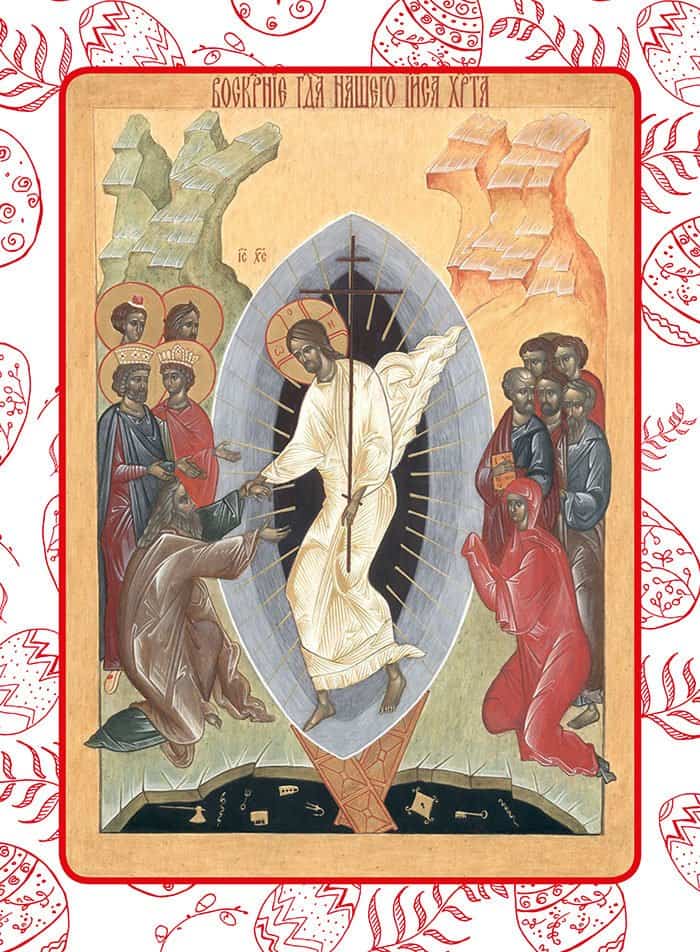
В ночь с субботы на воскресенье, то есть накануне иудейской Пасхи, Мария Магдалина и другие женщины пришли к пещере, чтобы омыть и умастить благовониями тело казненного Христа. Этих женщин в Церкви принято называть Женами-мироносицами.
Преданные Господу ученицы обнаружили, что камень, закрывавший вход в пещеру, отвален, а сам гроб пуст. Им явились два Ангела и возвестили Воскресение Христа: «Когда же недоумевали они о сем, вдруг предстали перед ними два мужа в одеждах блистающих. И когда они были в страхе и наклонили лица свои к земле, сказали им: что вы ищете живого между мертвыми?» (Лк 24:4-5).
Воскресение Христово — это смысловой центр всего христианства. Апостол Павел писал в Первом послании коринфянам: «Если нет воскресения мертвых, то и Христос не воскрес; а если Христос не воскрес, то и проповедь наша тщетна, тщетна и вера ваша» (1 Кор 15:13-14).
Что значит слово «Пасха»
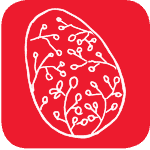
Слово «Пасха» буквально переводится как «прохождение мимо, прехождение, избавление». На иврите Пасха:פסח (Pesaḥ). На греческом: πάσχα. На латыни: Pascha.
Праздник Воскресения Христова получил название «Пасха» от еврейского праздника Пасхи. Песах у иудеев посвящен Исходу израильтян из Египта и освобождению их от рабства. Эти события описаны в Ветхом Завете.
Почему христиане взяли название иудейского праздника? Дело в том, что события Страстной седмицы — предательство Иуды, арест Христа, Страсти Христовы и распятие — произошли накануне еврейской Пасхи. А Воскресение Христово — в ночь на Пасху.
Как рассчитывается дата Пасхи

Существует специальный термин — «пасхалия». Это система расчета даты православной Пасхи.
По поводу даты Пасхи есть постановление Первого Вселенского собора, которые был проведен Церковью в 325 г. в городе Никее. Оно гласит: православная Пасха празднуется в первое воскресенье после весеннего полнолуния, которое наступает после или в день весеннего равноденствия.
Правило действует только в случае, если это воскресенье приходится на день ПОСЛЕ дня празднования еврейской Пасхи. Если воскресенье приходится на день ДО еврейской Пасхи, православную Пасху отмечают в первый воскресный день после дня еврейской Пасхи.
Получается, что дата празднования Пасхи лежит в пределах от 4 апреля до 8 мая по новому стилю.
Даты Пасхи до 2030 года
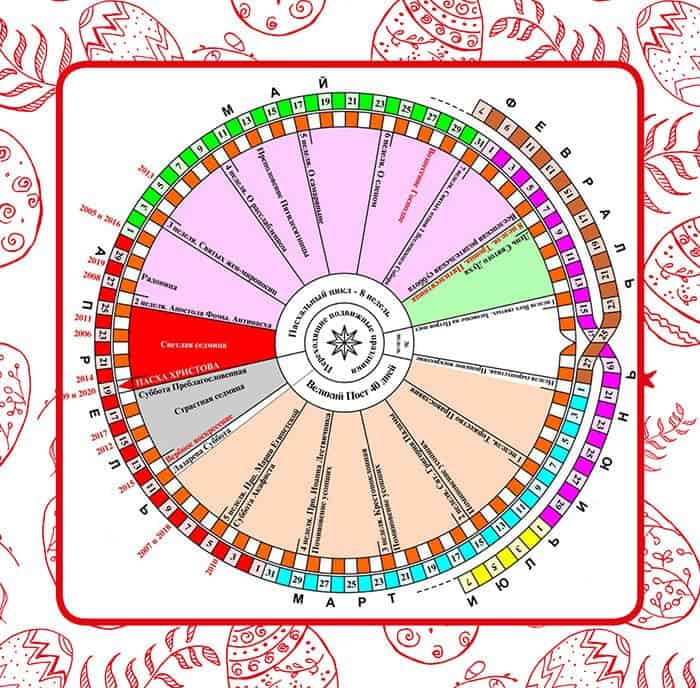
- 2022 — 24 апреля
- 2023 — 16 апреля
- 2024 — 5 мая
- 2025 — 20 апреля
- 2026 — 12 апреля
- 2027 — 2 мая
- 2028 — 16 апреля
- 2029 — 8 апреля
- 2030 — 28 апреля
Пасхальное приветствие — христосование
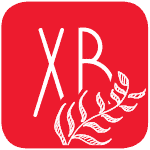
Пасхальное приветствие — христосование — обычай, который пошел еще от Апостолов. «Приветствуйте друг друга с целованием святым», — писал Апостол Павел в своем послании к римлянам (Рим 16:16).
Христосоваться — значит приветствовать друг друга словами: «Христос воскресе!» — «Воистину воскресе!», при этом троекратно целуя друг друга в щеки.
Верующие здороваются таким образом начиная с пасхальной ночи и еще сорок дней — до отдания праздника Пасхи, праздника Вознесения Господня. В пасхальную ночь христосование происходит в конце пасхальной утрени.
Сначала с Воскресением Христовым поздравляют друг друга священнослужители в алтаре. Потом они выходят из алтаря с крестом, Евангелием и иконами, становятся перед царскими вратами, лицом к молящимся в храме. Прихожане целуют Евангелие, крест и иконы и христосуются между собой.
Это приветствие — выражение ликования, радости от вести о том, что Спаситель воскрес.
«Христос воскресе!» на иностранных языках
- украинский: Христос воскрес!
- белорусский: Хрыстос уваскрос!
- греческий: Χριστος Aνεστη!
- грузинский: ქრისტე აღსდგა!
- сербский: Христос Васкрсе!
- болгарский: Христос возкресе!
- хорватский: Hristos voskrese!
- польский: Chrystus Zmartwychwstał!
- румынский: Hristos a înviat!
- эстонский: Kristus on surnuist ülestõusnud!
- литовский: Kristus prisikėlė!
- латышский: Kristus Augšāmcēlies!
- английский: Christ is Risen!
- ирландский: Tá Críost éirithe!
- французский: Le Christ est ressuscité!
- испанский: ¡Cristo ha resucitado!
- португальский: Cristo ressuscitou!
- итальянский: Cristo è risorto!
- немецкий: Christus ist auferstanden!
- голландский: Christus is opgestaan!
- датский: Kristus er opstanden!
- норвежский: Kristus er oppstanden!
- шведский: Kristus är uppstånden!
- финский: Kristus nousi kuolleista!
- словенский: Kristus je vstal!
- македонский: Христос воскресна!
- венгерский: Krisztus feltámadt!
- чешский: Kristus vstal z mrtvých!
- словацкий: Christos vstal z mŕtvych!
- албанский: Krishti u ngjall!
- арабский: Al-Masih-Qam!
- корейский: Kristo Gesso!
История празднования Пасхи
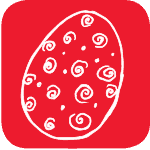
После Пятидесятницы, то есть сошествия Святого Духа на Апостолов, которое произошло в пятидесятый день после Пасхи, последователи Христа впервые начали проводить особую службу — Литургию. На Литургии совершалось Таинство Причастия, которое установил сам Христос на Тайной Вечере. Литургии совершались как раз по примеру Тайной Вечери.
В первые века христианства Пасха отмечалась каждую неделю. В пятницу христиане постились и вспоминали страдания Спасителя на кресте. В воскресенье — радовались и славили Христа воскресшего. Весной, в период иудейской Пасхи, Пасха была особенно торжественной, потому что именно на иудейскую Пасху произошли распятие и Воскресение Христовы.

Во II веке праздник становится во всех Церквях ежегодным. Сначала было как бы две Пасхи: «Пасха крестная» и «Пасха воскресная». Страдания и смерть Христа отмечались особым постом и назывались «Пасха крестная». Она совпадала с иудейской Пасхой, а постились до ночи с субботы на воскресенье. В воскресенье отмечалась Пасха радости, или «Пасха воскресная», то есть Воскресение Христово.
Вопрос единого для всех христиан дня Пасхи поднял император Константин Великий. В 325 г. он созвал епископов в город Никея в Малой Азии. Мы теперь называем это Первым Вселенским собором. Епископы решили согласовывать день празднования Пасхи между христианскими общинами разных стран. Воскресение Христово постановили отмечать строго после иудейской Пасхи и всегда в воскресенье. Днем христианской Пасхи выбрали ближайшее воскресенье после первого весеннего полнолуния.
Сначала восточные Церкви и Рим праздновали Пасху в один день, определяя вместе ее дату. Потом сообщение между ними прервалось, Восток и Рим начали праздновать Пасху каждый по своим вычислениям, часто в разные дни.
Само слово «Пасха» стало общепринятым для обозначения праздника Воскресения Христова в V веке. Постепенно Пасха приобрела самое большое значение среди других христианских праздников, ее стали называть «праздников праздник».
Особенности богослужения Пасхи

Пасхальное богослужение — самое торжественное в году. Начинается оно за некоторое время до полуночи. Служба до 12 часов ночи носит название Полунощница. На ней священник и диакон выходят к Плащанице — большому плату из ткани, на котором вышита или написана икона, изображающая Спасителя во гробе. С пением молитв они совершают каждение вокруг Плащаницы, поднимают ее и уносят в алтарь. Там — кладут на святой Престол, где Плащаница остается до праздника Вознесения Господня, которое происходит через 40 дней после Воскресения.
Перед самой полночью начинается Пасхальная заутреня (или утреня). Из-за закрытых царских врат начинает звучать стихира (вид церковногло гимнографического текста): «Воскресение Твое, Христе Спасе, ангели поют на небесех, и нас на земли сподоби чистым сердцем Тебе славити».
Потом царские врата открываются, и священнослужители в светлых облачениях вместе с прихожанами выходят из храма и обходят его крестным ходом. Впереди несут крест, Евангелие, иконы, хоругви (укрепленные на древке полотнища с изображением Христа или святых). У каждого верующего в руках — свеча или лампадка. Все поют: «Воскресение Твое, Христе Спасе, Ангели поют на небесех, и нас на земли сподоби чистым сердцем Тебе славити». Крестный ход сопровождается особым пасхальным колокольным звоном.
Обойдя храм, шествие останавливается у затворенных западных врат храма. Эти врата символизируют двери гроба Господня. Колокола затихают, и священник первым провозглашает радостную весть: «Христос воскресе из мертвых, смертию смерть поправ и сущим во гробех живот даровав». Эта песнь священнослужители и все верующие повторяют три раза. Потом священник поет стихи пророчества Царя Давида: «Да воскреснет Бог и расточатся врази Его…». Люди вторят на каждый стих: «Христос воскресе из мертвых…»
Двери открывают, и верующие входят в ярко освещенный храм, как когда-то Жены-мироносицы вошли в гроб Господень и увидели, что Спасителя там нет, что Он воскрес из мертвых.
Дальнейшая Пасхальная заутреня — это пение канона святого Иоанна Дамаскина. Во время пения канона священнослужители обходят храм, кадят и возглашают: «Христос воскресе!» На что прихожане вторят: «Воистину воскресе!»
Утреня заканчивается словами: «Друг друга объимем, рцем: братие! и ненавидящим нас простим вся воскресением». И все, сначала священнослужители в алтаре, потом верующие в храме, начинают христосоваться, то есть троекратно целовать и приветствовать друг друга радостными словами «Христос воскресе!» — «Воистину воскресе!»
Потом в храме читают огласительное слово на Пасху святителя Иоанна Златоуста. В нем есть слова, которые в полной мере выражают победу Христа над смертью: «Где твое, смерте, жало? Где твоя, аде, победа? Воскресе Христос, и ты низверглся еси. Воскресе Христос, и падоша демони. Воскресе Христос, и радуются ангели. Воскресе Христос, и жизнь жительствует».
После утрени совершаются Часы и Литургия, причем при открытых царских вратах. Они будут открыты всю Светлую седмицу в знак того, что Христос навсегда открыл всем христианам врата Царствия Небесного.
Часы Святой Пасхи — это молитвы, которыми в Пасхальную седмицу заменяутся обычные молитвословия перед Литургией.
Крестный ход на Пасху

Пасхальный крестный ход — радостное шествие вокруг храма, которое совершает в ночь с Великой Субботы на Воскресение Христово.
Пасхальная заутреня начинается прямо перед полуночью. Из-за закрытых царских врат звучит стихира (вид церковногло гимнографического текста): «Воскресение Твое, Христе Спасе, ангели поют на небесех, и нас на земли сподоби чистым сердцем Тебе славити».
Потом царские врата открываются, и священнослужители вместе с прихожанами выходят из храма и обходят его крестным ходом. Впереди несут большой запрестольный крест, запрестольный образ Богородицы, Евангелие, другие иконы, хоругви (укрепленные на древке полотнища с изображением Христа или святых). У каждого верующего в руках — свеча или лампадка. Все поют: «Воскресение Твое, Христе Спасе, Ангели поют на небесех, и нас на земли сподоби чистым сердцем Тебе славити». Крестный ход сопровождается особым пасхальным колокольным звоном.
Шествие останавливается у затворенных западных врат храма. Эти врата символизируют двери гроба Господня. Колокола умолкают, и священник провозглашает: «Христос воскресе из мертвых, смертию смерть поправ и сущим во гробех живот даровав». Эта песнь священнослужители и все верующие повторяют три раза. Потом священник поет стихи пророчества Царя Давида: «Да воскреснет Бог и расточатся врази Его…». Люди вторят на каждый стих: «Христос воскресе из мертвых…»
Двери храма открывают, и верующие входят в ярко освещенный храм, как когда-то Жены-мироносицы вошли в гроб Господень и увидели, что Спасителя там нет, что Он воскрес из мертвых.
Пасхальный колокольный звон
Колокольный звон на Пасху — торжественный, радостный. С дневних веков звонари вкладывали в него все мастерство и всю душу. Пасхальный звон имеет особое название — «трезвон». Это наиболее сложный из видов звона, он назван так, потому что состоит из трех частей с небольшой паузой между ними.
Светлая седмица — неделя после Пасхи — называется также Звонильной неделей, потому что все желающие могут в эти семь дней подняться на колокольню и попробовать себя в звонарном искусстве.
Тропарь Пасхи
Тропарь — это краткое песнопение, которое выражает смысл православного праздника.
Тропарь Пасхи по-церковнославянски:
Христо́с воскре́се из ме́ртвых, сме́ртию смерть попра́в, и су́щим во гробе́х живо́т дарова́в.
В переводе на русский:
Христос воскрес из мертвых, поразив (Своею) смертию смерть и даровав жизнь находящимся в гробах.
Огласительное слово святителя Иоанна Златоуста

Огласительное слово святителя Иоанна Златоуста звучит во всех православных храмах на пасхальной заутрене после того, как верующие целуют друг друга, поздравляя со Светлым праздником Пасхи — Воскресением Христовым.
«Огласительное» исторически значит предназначенное для наставления в вере желающих принять Крещение. Дело в том, что в древности в Церкви крестили людей в Великую субботу — то есть перед самым праздником Воскресения Христова. Традиционно в огласительном слове священнослужители кратко излагали основы христианского вероучения — догматы Церкви. Слово святителя Иоанна Златоуста — самое известное из пасхальных огласительных слов.
Текст огласительного слова:
Аще кто благочестив и боголюбив, да насладится сего добраго и светлаго торжества.
Аще кто раб благоразумный, да внидет, радуяся, в радость Господа своего.
Аще кто потрудися постяся, да восприимет ныне динарий.
Аще кто от перваго часа делал есть, да приимет днесь праведный долг.
Аще кто по третием часе прииде, благодаря да празднует.
Аще кто по шестом часе достиже, ничтоже да сумнится; ибо ничим отщетевается.
Аще кто лишися и девятаго часа, да приступит, ничтоже сумняся, ничтоже бояся.
Аще кто точию достиже и во единонадесятый час, да не устрашится замедления: любочестив бо Сый Владыка, приемлет последняго, якоже и перваго: упокоевает в единонадесятый час пришедшаго, якоже делавшаго от перваго часа; и последняго милует, и первому угождает, и оному дает, и сему дарствует; и дела приемлет, и намерение целует; и деяние почитает, и предложение хвалит.
Темже убо внидите вси в радость Господа своего: и первии, и втории, мзду приимите.
Богатии и убозии, друг со другом ликуйте.
Воздержницы и ленивии, день почтите.
Постившийся и не постившийся, возвеселитеся днесь.
Трапеза исполнена, насладитеся вси.
Телец упитанный, никтоже да изыдет алчай; вси насладитеся пира веры; вси восприимите богатство благости.
Никтоже да рыдает убожества: явися бо общее Царство.
Никтоже да плачет прегрешений, прощение бо от гроба возсия.
Никтоже да убоится смерти, свободи бо нас Спасова смерть.
Угаси ю, Иже от нея держимый.
Плени ада, Сошедый во ад.
Огорчи ада, вкусивша плоти его.
И сие предприемый Исаиа возопи: ад, глаголет, огорчися, срет Тя доле.
Огорчися, ибо упразднися, огорчися, ибо поруган бысть.
Огорчися, ибо умертвися.
Огорчися, ибо низложися.
Огорчися, ибо связася.
Прият тело, и Богу приразися.
Прият землю и срете небо.
Прият, еже видяше, и впаде во еже не видяше.
Где твое, смерте, жало?
Где твоя, аде, победа?
Воскресе Христос, и ты низверглся еси.
Воскресе Христос, и падоша демони.
Воскресе Христос, и радуются Ангели.
Воскресе Христос, и жизнь жительствует.
Воскресе Христос, и мертвый ни един во гробе.
Христос бо, востав от мертвых, Начаток усопших бысть.
Тому слава и держава во веки веков. Аминь.
Пасхальный канон преподобного Иоанна Дамаскина

Пасхальный канон написал преподобный Иоанн Дамаскин, один из Отцов Церкви, богослов, философ и гимнограф, который творил в VIII веке. Его Пасхальный канон сейчас — часть пасхальной утрени.
Песнь 1
Воскресения день, просветимся людие: Пасха, Господня Пасха! От смерти бо к жизни и от земли к небеси, Христос Бог нас преведе, победную поющия.
Припев: Христос воскресе из мертвых.
Очистим чувствия, и узрим неприступным светом воскресения Христа блистающася, и радуйтеся, рекуща ясно да услышим, победную поюще.
Христос воскресе из мертвых.
Небеса убо достойно да веселятся, земля же да радуется: да празднует же мир, видимый же весь и невидимый, Христос бо воста, веселие вечное.
Богородичны
Слава: Умерщвления предел сломила еси, вечную жизнь рождшая Христа, из гроба возсиявшаго днесь, Дево Всенепорочная, и мир просветившаго.
И ныне: Воскресшаго видевши Сына Твоего и Бога, радуйся со апостолы Богоблагодатная чистая: и еже радуйся первее, яко всех радости вина, восприяла еси, Богомати Всенепорочная.
Песнь 3
Приидите пиво пием новое, не от камене неплодна чудодеемое, но нетления источник, из гроба одождивша Христа, в Немже утверждаемся.
Ныне вся исполнишася света, небо же и земля и преисподняя: да празднует убо вся тварь востание Христово, в немже утверждается.
Вчера спогребохся Тебе, Христе, совостаю днесь воскресшу Тебе, сраспинахся Тебе вчера, Сам мя спрослави, Спасе, во Царствии Твоем.
Слава: На нетленную жизнь прихожду днесь благостию рождшагося из Тебе, Чистая, и всем концем свет облиставшаго.
И ныне: Бога, Егоже родила еси плотию, из мертвых, якоже рече, воставша видевши, Чистая, ликуй, и Сего яко Бога Пречистая возвеличай.
Ипакои, глас 4-й
Предварившия утро яже о Марии, и обретшия камень отвален от гроба, слышаху от ангела: во свете присносущнем Сущаго, с мертвыми что ищете яко человека? Видите гробныя пелены. Тецыте и миру проповедите, яко воста Господь умертвивый смерть, яко есть Сын Бога, спасающаго род человеческий.
Песнь 4
На божественней стражи, богоглаголивый Аввакум да станет с нами и покажет светоносна ангела, ясно глаголюща: днесь спасение миру, яко воскресе Христос, яко Всесилен.
Мужеский убо пол, яко разверзый девственную утробу, явися Христос: яко человек же, агнец наречеся: непорочен же, яко невкусен скверны, наша Пасха, и яко Бог истинен, совершен речеся.
Яко единолетный агнец, благословенный нам венец Христос, волею за всех заклан бысть, Пасха чистительная, и паки из гроба красное правды нам возсия солнце.
Богоотец убо Давид пред сенным ковчегом скакаше играя, людие же Божии святии, образов сбытие зряще, веселимся Божественне, яко воскресе Христос, яко Всесилен.
Слава: Создавый Адама, Твоего праотца, Чистая, зиждется от Тебе, и смертное жилище разори Своею смертию днесь, и озари вся божественными блистаньми воскресения.
И ныне: Егоже родила еси Христа, прекрасно из мертвых возсиявша, Чистая зрящи, добрая и непорочная в женах и красная, днесь во спасение всех, со апостолы радующися, Того прославляй.
Песнь 5
Утренюем утреннюю глубоку, и вместо мира песнь принесем Владыце, и Христа узрим правды солнце, всем жизнь возсияюща.
Безмерное Твое благоутробие адовыми узами содержимии зряще, к свету идяху Христе, веселыми ногами, Пасху хваляще вечную.
Приступим свещеноснии исходящу Христу из гроба яко Жениху, и спразднуим любопразднственными чинми Пасху Божию спасительную.
Слава: Просвещается божественными лучами и живоносными воскресения Сына Твоего, Богомати Пречистая, и радости исполняется благочестивых собрание.
И ныне: Не разверзл еси врата девства в воплощении, гроба не разрушил еси печатей, Царю создания: отонудуже воскресшаго Тя зрящи Мати, радовашеся.
Песнь 6
Снизшел еси в преисподняя земли и сокрушил еси вереи вечныя, содержащия связанныя Христе, и тридневен, яко от кита Иона, воскресл еси от гроба.
Сохранив цела знамения, Христе, воскресл еси от гроба, ключи Девы не вредивый в рождестве Твоем, и отверзл еси нам райские двери.
Спасе мой, живое же и нежертвенное заколение, яко Бог Сам Себе волею привед Отцу, совоскресил еси всероднаго Адама, воскрес от гроба.
Слава: Возведеся древле держимое смертию и тлением, воплотившимся от Твоего пречистаго чрева, к нетленней и присносущней жизни, Богородице Дево.
И ныне: Сниде в преисподняя земли, в ложесна Твоя, Чистая, сшедый, и вселивыйся и воплотивыйся паче ума, и воздвиже с Собою Адама, воскрес от гроба.
Кондак, глас 8-й
Аще и во гроб снизшел еси, Безсмертне, но адову разрушил еси силу, и воскресл еси яко победитель, Христе Боже, женам мироносицам вещавый: радуйтеся, и Твоим апостолом мир даруяй, падшим подаяй воскресение.
Икос
Еже прежде солнца Солнце зашедшее иногда во гроб, предвариша ко утру, ищущия яко дне мироносицы девы, и друга ко друзей вопияху: О другини! приидите, вонями помажем Тело живоносное и погребенное, плоть Воскресившаго падшаго Адама, лежащую во гробе. Идем, потщимся якоже волсви, и поклонимся, и принесем мира яко дары, не в пеленах, но в плащанице Обвитому, и плачим и возопиим: О Владыко, востани, падшим подаяй воскресение.
Воскресение Христово видевше, поклонимся Святому Господу Иисусу, Единому Безгрешному, Кресту Твоему покланяемся, Христе, и святое воскресение Твое поем и славим: Ты бо еси Бог наш, разве Тебе иного не знаем, имя Твое именуем. Приидите, вси вернии, поклонимся святому Христову воскресению: се бо прииде Крестом радость всему миру. Всегда благословяще Господа, поем воскресение Его: распятие бо претерпев, смертию смерть разруши. (Трижды)
Воскрес Иисус от гроба, якоже прорече, даде нам живот вечный и велию милость. (Трижды)
Песнь 7
Отроки от пещи избавивый, быв человек, страждет яко смертен, и страстию смертное в нетления облачит благолепие, Един благословен отцев Бог и препрославлен.
Жены с миры богомудрыя вслед Тебе течаху: Егоже яко мертва со слезами искаху, поклонишася радующияся живому Богу, и Пасху тайную Твоим, Христе, учеником благовестиша.
Смерти празднуем умерщвление, адово разрушение, иного жития вечнаго начало, и играюще поем Виновнаго, Единаго Благословеннаго отцев Бога и препрославленнаго.
Яко воистинну священная, и всепразднственная сия спасительная нощь, и светозарная, светоноснаго дне востания сущи провозвестница: в нейже безлетный Свет из гроба плотски всем возсия.
Слава: Умертвив Сын Твой смерть, Всенепорочная, днесь всем смертным пребывающий живот во веки веков дарова, един благословенный отцев Бог и препрославленный.
И ныне: Всем царствуяй созданием, быв человек, вселися в Твою, Богоблагодатная, утробу, и распятие претерпев и смерть, воскресе боголепно, совозставив нас яко всесилен.
Песнь 8
Сей нареченный и святый день, един суббот царь и господь, праздников праздник, и торжество есть торжеств: воньже благословим Христа во веки.
Приидите новаго винограда рождения, божественнаго веселия, в нарочитом дни воскресения, Царствия Христова приобщимся, поюще Его яко Бога во веки.
Возведи окрест очи твои, Сионе, и виждь: се приидоша к тебе яко богосветлая светила, от запада, и севера, и моря, и востока чада твоя, в тебе благословящия Христа во веки.
Пресвятая Троице, Боже наш, слава Тебе.
Отче Вседержителю, и Слове, и Душе, треми соединяемое во ипостасех естество, пресущественне и пребожественне, в Тя крестихомся и Тя благословим во вся веки.
Слава: Прииде Тобою в мир Господь, Дево Богородице, и чрево адово расторг, смертным нам воскресение дарова: Темже благословим Его во веки.
И ныне: Всю низложив смерти державу Сын Твой, Дево, Своим воскресением, яко Бог крепкий совознесе нас и обожи: темже воспеваем Его во веки.
Песнь 9
Припев: Величит душа моя воскресшаго тридневно от гроба Христа Жизнодавца.
Ирмос: Светися, светися новый Иерусалиме, слава бо Господня на тебе возсия. Ликуй ныне и веселися, Сионе. Ты же, Чистая, красуйся. Богородице, о востании Рождества Твоего.
Припев: Христос новая Пасха, жертва живая, Агнец Божий, вземляй грехи мира.
О божественнаго, о любезнаго, о сладчайшаго Твоего гласа! С нами бо неложно обещался еси быти до скончания века Христе, Егоже вернии, утверждение надежды имуще, радуемся.
Припев: Ангел вопияше Благодатней: Чистая Дево, радуйся, и паки реку: радуйся! Твой Сын воскресе тридневен от гроба, и мертвыя воздвигнувый, людие, веселитеся.
О Пасха велия и священнейшая, Христе! О мудросте, и Слове Божий, и сило! Подавай нам истее Тебе причащатися, в невечернем дни Царствия Твоего.
Ексапостиларий
Плотию уснув, яко мертв, Царю и Господи, тридневен воскресл еси, Адама воздвиг от тли, и упразднив смерть: Пасха нетления, мира спасение.
Стихиры Пасхи
Стих: Да воскреснет Бог, и расточатся врази Его.
Пасха священная нам днесь показася: Пасха нова святая, Пасха таинственная, Пасха всечестная, Пасха Христос Избавитель, Пасха непорочная, Пасха великая, Пасха верных, Пасха двери райския нам отверзающая, Пасха всех освящающая верных.
Стих: Яко исчезает дым, да исчезнут.
Приидите от видения жены благовестницы, и Сиону рцыте: приими от нас радости благовещения воскресения Христова; красуйся, ликуй и радуйся, Иерусалиме, Царя Христа узрев из гроба яко жениха, происходяща.
Стих: Тако да погибнут грешницы от лица Божия, а праведницы да возвеселятся.
Мироносицы жены, утру глубоку, представша гробу Живодавца, обретоша ангела, на камени седяща, и той провещав им сице глаголаше: что ищете Живаго с мертвыми? Что плачете Нетленнаго во тли? Шедше проповедите учеником Его.
Стих: Сей день, егоже сотвори Господь, возрадуемся и возвеселимся в онь.
Пасха красная, Пасха, Господня Пасха! Пасха всечестная нам возсия! Пасха! Радостию друг друга обымем. О Пасха!
Избавление скорби, ибо из гроба днесь яко от чертога возсияв Христос, жены радости исполни глаголя: проповедите апостолом.
Слава, и ныне: Воскресения день, и просветимся торжеством, и друг друга обымем. Рцем, братие, и ненавидящим нас, простим вся воскресением, и тако возопиим: Христос воскресе из мертвых, смертию смерть поправ и сущим во гробех живот даровав.
Благодатный огонь

Чудо схождения Благодатного огня, или Святого Света, как его еще называют, происходит каждый год в Великую субботу, накануне православной Пасхи. Первые письменные свидетельства очевидцев о появлении Святого Света относятся к IX веку.
Чудо совершается в Иерусалиме в храме Воскресения. По преданию, он был построен на месте горы Голгофы, где был распят Спаситель, и гроба Господня — пещеры, в которой Он был погребен и где Ангелы явились Женам-мироносицам, чтобы возвестить, что Христос воскрес. Построили храм в IV веке император Константин и его мать, царица Елена.
Благодатный огонь выносят на особом богослужении из Кувуклии. Это часовня внутри храма Воскресения, в которой находится Гроб Господень.
В церемонии схождения Благодатного огня участвуют представители нескольких поместных православных Церквей: Иерусалимской православной церкви (Греко-православный патриархат Иерусалима), Иерусалимского патриархата Армянской апостольской церкви, Коптской и Сирийской церквей. Греческий Патриарх молится на Гробе Господнем о чуде, иногда его молитва продолжается очень долго. Именно он передает сошедший огонь другим патриархам, а затем огонь разносят по храму.
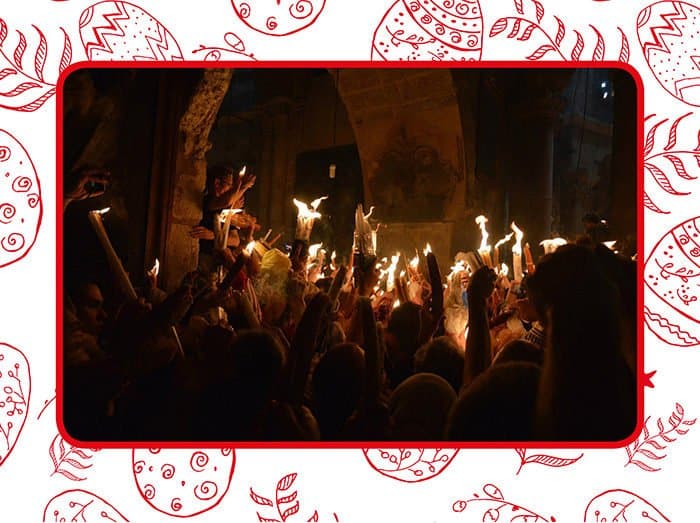
Православные христиане приезжают на службу со всего мира, с замиранием сердца ждут: свершится ли чудо в этот год? В руках люди держат связанные снопы свечей — 33 свечи, по числу земных лет Спасителя. Когда огонь выносят, так называемые «скороходы» быстро распространяют его по всему храму — от свечи к свече. Очевидцы схождения Благодатного огня говорят, что первые минуты после чуда он не жжется, некоторые верующие умывают им лицо в знак радости о предстоящей Пасхе.
В храм Воскресения ежегодно приезжают до 15 тысяч верующих. Не всем хватает места внутри храма, и многие ждут чуда около его стен. Служба транслируется в прямом эфире на телеканалах многих стран, в том числе и России.
Существует традиция приносить Благодатный огонь из Иерусалима в разные страны. В 1992 года впервые после почти 80-летнего перерыва его доставили на русскую землю. С тех пор каждый год его везут на самолете из Израиля в Москву, а затем передают в российские города.
Что такое артос

В православных церквях на Пасху освящается особый квасной хлеб — артос, или просфора всецелая. Исторически те, кто не мог причаститься в храме в день Христова Воскресения, могли ощутить единство с общиной, вкусив этот хлеб. На артосе изображают крест, на котором есть только терновый венец, но нет Распятого Спасителя. Это знамение победы Христовой над смертью.
В современные дни артос раздают верующим в субботу Светлой седмицы, чтобы те хранили его дома в течение всего года. В особых случаях его можно использовать в качестве антидора. Дословно с греческого языка это слово переводится как «вместо Причастия». Артос вкушают натощак при болезнях.
Пасха в других странах
В Сербии, как и в России, был распространен обычай «христования» — приветствия на Пасху, когда люди трижды целовали друг друга говорили: «Христос воскресе!» «Воистину воскресе!». Дети устраивали катание яиц по дорожке — у кого яйцо дальше укатится.
В католических странах Европы и в США сохранился обычай утром на Пасху прятать пасхальные яйца, чтобы дети, как проснутся, начинали их искать. После долгих поисков в доме и во дворе малышня находила «гнездо» пасхального кролика (Easter Bunny), в нем были спрятаны разноцветные пасхальные яйца.
Пасхальный кролик, или заяц, стал символом Пасхи в Германии с XVI века. Потом традиция разлетелась по всему миру. В виде кроликов делают игрушки, сладости и сувениры.
Задолго перед Пасхой на площадях европейских городов открываются Пасхальные ярмарки. Мосты и фонтаны украшаются зеленью и разноцветными яйцами. Во многих двориках можно увидеть кусты и деревья, украшенные яйцами и пасхальными кроликами.
Оформление материала: Мария Иванова.
Загрузка…
Дата события уникальна для каждого года. В 2023 году эта дата — 16 апреля
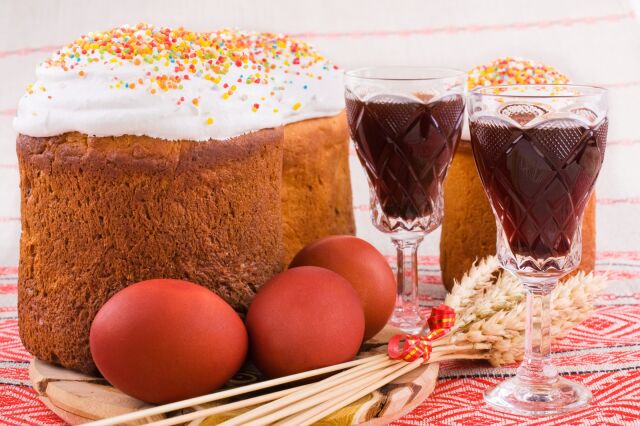
Светлый праздник воскресения Христа — Пасха — пришел из Византии вместе с крещением Руси в конце 9 века. С тех пор по всей России широко и торжественно отмечают этот христианский праздник.
Вообще в христианской традиции Пасха занимает особое место — место Праздника праздников. Подготовка к этому светлому событию предполагает последовательное соблюдение ряда религиозных предписаний. Упорядочивая социальную действительность, религиозные обряды регламентируют жизнь верующего человека.
Кроме этого, через выполнение определенных ритуалов, человек соотносит себя с той или иной религиозной традицией и тем самым осуществляет процесс идентификации с тем или иным вероисповеданием. Но существует и иная, «народная», традиция отношения к Пасхе, в рамках которой множество примет, суеверий и обычаев сосуществуют, а порой и переплетаются, с элементами церковной традиции, и вместе с тем создают свою сеть значений.
Прежде всего, следует отметить, что Пасха является для россиян одним из самых популярных праздников.
Накануне Пасхи во всех храмах проходят всенощные бдения и крестный ход вокруг церкви. Также накануне хозяйки пекут традиционную праздничную выпечку — куличи, которые символизируют собой тело Христа. А ещё к воскресенью Пасхи уже готовы крашеные яйца, которыми верующие «христосуются» — дарят их друг другу, приговаривая при этом: «Христос воскрес!» — «Воистину воскрес!», обнимаясь и целуясь.
В России широко и торжественно отмечают этот христианский праздник (Фото: Oleg Golovnev, Shutterstock)
Также на Руси Пасха — это день обильного угощения. После Великого Поста на стол выставляются всякие вкусности, и среди них первое место занимают ритуальные кушанья — пасхи, куличи и крашеные яйца. Яйцо, которое традиционно красилось в красные цвета и его оттенки, стало обязательным атрибутом и символом христианской Пасхи с 12 века. А кулич всегда выпекали из сдобного теста, высоким и круглым.
Раньше, по традиции, в эти дни было принято дарить подарки, особенно бедным родственникам, и заниматься благотворительностью. Особое внимание уделялось нищим странникам — ведь в народе говорили, что «от Пасхи до Вознесения странствует по земле Христос с апостолами, испытывая милосердие и доброту каждого».
Многие традиции празднования Пасхи в России соблюдаются и сегодня, ведь для большинства людей Пасха — светлый праздник, символизирующий возрождение и обновление.
Праздник праздников и Торжество торжеств, Светлое Христово Воскресенье — Святая Пасха Христова
Пасха в 2023 году — 16 апреля!
Воскресение Христово (Пасха) — это самый главный христианский праздник, установленный в воспоминание Воскресения Исуса Христа из мертвых. От даты Пасхи зависит и Устав церковной службы (с этого дня начинается отсчет «столпов» осмогласия), и окончание самого длинного и строгого Великого поста (разговенье) и многие другие православные праздники. Даже для людей, далеких от религии, святая Пасха ассоциируется с ночной торжественной службой, крестным ходом и куличами, крашеными яйцами и колокольным звоном. А в чем же духовный смысл праздника Пасхи и каковы его традиции? — Об этом в статье ниже.
Содержание
- Пасха Христова. Сколько дней празднуется?
- Событие праздника Пасхи: отрывок из Евангелия
- Празднование Пасхи в истории. Почему воскресенье называется воскресеньем?
- Какого числа Пасха у православных?
- Как рассчитать дату Пасхи?
- Православная пасхальная служба
- Традиции празднования Пасхи у старообрядцев
- Воскресение Христово. Иконы
- Храмы Воскресения Христова
- Старообрядческие храмы Воскресения Христова
- Христианская Пасха и Песах у иудеев (Еврейская Пасха) в 2021 году
- Новопасхалисты и их учение
Пасха Христова. Сколько дней празднуется?
Пасха — самый главный и торжественный христианский праздник. Он совершается каждый год в разное время и относится к подвижным праздникам. От дня Пасхи зависят и прочие подвижные праздники, такие как: Вербное воскресенье, Вознесение Господне, Праздник святой Троицы (Пятидесятница) и другие. Празднование Пасхи — самое продолжительное: 40 дней верующие приветствуют друг друга словами «Христос воскресе!» — «Воистину воскресе!». День Светлого Христова Воскресения для христиан — это время особого торжества и духовной радости, когда верующие собираются на службы славословить воскресшего Христа, а вся Пасхальная седмица празднуется «как един день». Церковная служба всю неделю почти полностью повторяет ночное пасхальное богослужение.
Событие праздника Пасхи: отрывок из Евангелия
Христианский праздник Пасхи — это торжественное воспоминание Воскресения Господа на третий день после Его страданий и смерти. Сам момент Воскресения не описан в Евангелии, ведь никто не видел, как это произошло. Снятие со Креста и погребение Господа было совершено вечером в пятницу. Поскольку суббота была у иудеев днем покоя, женщины, сопровождавшие Господа и учеников из Галилеи, бывшие свидетелями Его страданий и смерти, пришли ко Гробу Господню только через день, на рассвете того дня, который мы теперь называем воскресным. Они несли благовония, которые по обычаю того времени возливали на тело умершего человека.
По прошествии же субботы, на рассвете первого дня недели, пришла Мария Магдалина и другая Мария посмотреть гроб. И вот, сделалось великое землетрясение, ибо Ангел Господень, сошедший с небес, приступив, отвалил камень от двери гроба и сидел на нем; вид его был, как молния, и одежда его бела, как снег; устрашившись его, стерегущие пришли в трепет и стали, как мертвые; Ангел же, обратив речь к женщинам, сказал: не бойтесь, ибо знаю, что вы ищете Исуса распятого; Его нет здесь — Он воскрес, как сказал. Подойдите, посмотрите место, где лежал Господь, и пойдите скорее, скажите ученикам Его, что Он воскрес из мертвых и предваряет вас в Галилее; там Его увидите. Вот, я сказал вам.
И, выйдя поспешно из гроба, они со страхом и радостью великою побежали возвестить ученикам Его. Когда же шли они возвестить ученикам Его, и се Исус встретил их и сказал: радуйтесь! И они, приступив, ухватились за ноги Его и поклонились Ему. Тогда говорит им Исус: не бойтесь; пойдите, возвестите братьям Моим, чтобы шли в Галилею, и там они увидят Меня» (Мф. 28, 1–10).
Библиотека Русской веры
Описание Исуса Христа историком I века Иосифом Флавием. Лицевой летописный свод (Всемирная история, книга 5) →
Читать онлайн
Празднование Пасхи в истории. Почему воскресенье называется воскресеньем?
От христианского праздника Пасхи происходит и современное название дня недели — воскресенье. Каждое воскресенье недели на протяжении всего года христиане особенно отмечают молитвой и торжественной службой в храме. Воскресенье еще называют «малой Пасхой». Воскресенье называется воскресеньем в честь воскресшего в третий день после распятия Исуса Христа. И хотя Воскресение Господне христиане вспоминают еженедельно, но особенно торжественно отмечается это событие один раз в году — на праздник Пасхи.
В первые века христианства существовало разделение на Пасху крестную и Пасху воскресную. Упоминания об этом содержатся в творениях ранних отцов Церкви: послании святителя Иринея Лионского (ок. 130–202) к римскому епископу Виктору, «Слове о Пасхе» святителя Мелитона Сардийского (нач. II в. — ок. 190), творениях святителя Климента Александрийского (ок. 150 — ок. 215) и Ипполита Папы Римского (ок. 170 — ок. 235). Пасха крестная — воспоминания страданий и смерти Спасителя отмечалась особым постом и совпадала с иудейской Пасхой в память о том, что Господь был распят во время этого ветхозаветного праздника. Первые христиане молились и строго постились до самой Пасхи воскресной — радостного воспоминания Воскресения Христова.
В настоящее время нет деления на Пасху крестную и воскресную, хотя содержание сохранилось в богослужебном Уставе: строгие и скорбные службы Великих Четвертка, Пятка и Субботы завершаются радостным и ликующим Пасхальным богослужением. Собственно и сама Пасхальная ночная служба начинается скорбной полунощницей, на которой читается канон Великой Субботы. В это время посреди храма еще стоит аналой с Плащаницей — шитой или писанной иконой, изображающей положение Господа во гроб.
Какого числа Пасха у православных?
Общины первых христиан праздновали Пасху в разное время. Одни вместе с иудеями, как пишет блаженный Иероним, другие — в первое воскресенье после иудеев, поскольку Христос был распят в день Песаха и воскрес наутро после субботы. Постепенно различие пасхальных традиций поместных Церквей становилось все более заметным, возник так называемый «пасхальный спор» между восточными и западными христианскими общинами, возникла угроза единству Церкви. На Первом Вселенском Соборе, созванном императором Константином в 325 году в Никее, рассматривался вопрос о едином для всех праздновании Пасхи. По словам церковного историка Евсевия Кесарийского, все епископы не только приняли Символ Веры, но и условились праздновать Пасху всем в один день:
Для согласного исповедания Веры спасительное празднование Пасхи надлежало совершать всем в одно и то же время. Поэтому сделано было общее постановление и утверждено подписью каждого из присутствовавших. Окончив эти дела, василевс (Константин Великий) сказал, что он одержал теперь вторую победу над врагом Церкви, и потому совершил победное посвященное празднество Богу.
С того времени все поместные Церкви стали праздновать Пасху в первое воскресенье после первого полнолуния, наступившего после весеннего равноденствия. Если же в это воскресенье выпадает Пасха иудейская, то христиане переносят празднование на следующее воскресенье, поскольку еще в правилах святых Апостолов, согласно 7-му правилу, запрещено христианам праздновать Пасху вместе с иудеями.
Как рассчитать дату Пасхи?
Для расчета Пасхи нужно знать не только солнечный (равноденствие), но и лунный календарь (полнолуние). Поскольку лучшие знатоки лунного и солнечного календаря жили в то время в Египте, честь вычисления православной пасхалии была предоставлена Александрийскому епископу. Он должен был ежегодно извещать все поместные Церкви о дне Пасхи. Со временем была создана Пасхалия на 532 года. Она основана на периодичности юлианского календаря, в котором календарные показатели расчета Пасхи — круг Солнца (28 лет) и круг Луны (19 лет) — повторяются через 532 года. Этот период называется «великим индиктионом». Начало первого «великого индиктиона» совпадает с началом эры «от сотворения мира». Текущий, 15 великий индиктион, начался в 1941 году. На Руси пасхальные таблицы включали в состав богослужебных книг, например, Следованную Псалтырь. Известно также несколько рукописей XVII–XVII вв. под названием «Великий миротворный круг». В них содержатся не только Пасхалия на 532 года, но и таблицы для расчета даты Пасхи по руке, так называемая Пятиперстная Пасхалия или «рука Дамаскина».
Стоит отметить, что в старообрядчестве до настоящего времени сохранились знания, как рассчитать по руке дату Пасхи, любого подвижного праздника, умение определить, в какой день недели приходится тот или иной праздник, продолжительности Петрова поста и другие важные сведения, необходимые для совершения богослужения.
Православная пасхальная служба
Всю Страстную седмицу, предшествующую Пасхе, каждый из дней которой называется Великим, православные христиане совершают службы и вспоминают Страсти Христовы, последние дни земной жизни Спасителя, Его страдания, распятие, смерть на Кресте, погребение, схождение во ад и Воскресение. Для христиан это особо почитаемая неделя, время особо строгого поста, подготовки к встрече главного христианского праздника.
Перед началом праздничной службы в храме читаются Деяния апостолов. Пасхальная служба, как и в древности, совершается ночью. Богослужение начинается за два часа до полуночи Воскресной полунощницей, во время которой читают канон Великой субботы «Волною морскою». На 9-й песни канона, когда поется ирмос «Не рыдай Мене, Мати», после каждения, Плащаница уносится в алтарь. У старообрядцев-безпоповцев после третьей песни канона и седальна читается слово Епифания Кипрского «Что се безмолвие».
После полунощницы начинается подготовка к Крестному ходу. Священнослужители в блестящих ризах, с крестом, Евангелием и иконами выходят из храма, за ними следуют молящиеся с горящими свечами; трижды обходят храм посолонь (по солнцу, по часовой стрелке) с пением стихеры: «Воскресение Твое, Христе Спасе, Ангели поют на небеси, и нас на земли сподоби чистыми сердцы Тебе славити». Этот крестный ход напоминает шествие мироносиц глубоким утром ко гробу, чтобы помазать Тело Исуса Христа. Крестный ход останавливается у западных дверей, которые бывают затворены: это напоминает снова мироносиц, получивших первую весть о воскресении Господа у дверей гроба. «Кто отвалит нам камень от гроба?» — недоумевают они.
Священник, покадив иконы и присутствующих, начинает светлую утреню возгласом: «Слава Святей, и Единосущней, и Животворящей, и Неразделимей Троице». Храм освещается множеством светильников. Священно- и церковнослужители поют трижды тропарь празднику:
Хrт0съ воскрeсе и3зъ мeртвыхъ смeртію на смeрть наступи2 и3 грHбнымъ жив0тъ даровA.
После этого тропарь многократно повторяют певчие при возглашении священником стихов: «Да воскреснет Бог» и прочих. Затем священнослужитель с крестом в руках, изображая Ангела, отвалившего камень от дверей гроба, открывает затворенные двери храма и все верующие входят в храм. Далее, после великой ектении, поется торжественным и ликующим напевом пасхальный канон: «Воскресения день», составленный св. Иоанном Дамаскиным. Тропари пасхального канона не читаются, а поются с припевом: «Христос воскресе из мертвых». Во время пения канона священник, держа в руках крест, на каждой песни кадит святые иконы и народ, приветствуя его радостным восклицанием: «Христос воскресе». Народ отвечает: «Воистину воскресе». Многократный выход священника с каждением и приветствием «Христос воскресе» изображает многократные явления Господа своим ученикам и радость их при виде Его. После каждой песни канона произносится малая ектения. По окончании канона поется следующий утренний светилен:
Пл0тію ўснyвъ ћкw мeртвъ, цRь и3 гDь, триднeвенъ воскRсе, и3 ґдaма воздви1гъ и3з8 тли2, и3 ўпраздни1въ смeрть. пaсха нетлёніz, ми1ру спасeніе.
(Перевод: Царь и Господь! Уснув плотью, как мертвец, Ты воскрес тридневный, воздвигнув от погибели Адама и уничтожив смерть; Ты — пасха безсмертия, спасение мира).
Затем читаются хвалитные псалмы и поются стихеры на хвалитех. К ним присоединяются стихеры Пасхи с припевом: «Да воскреснет Бог и разыдутся врази Его». После этого, при пении тропаря «Христос воскресе», верующие дают друг другу братское лобзание, т.е. «христосуются», с радостным приветствием: «Христос воскресе» — «Воистину воскресе». После пения пасхальных стихер бывает чтение слова св. Иоанна Златоустого: «Аще кто благочестив и боголюбив». Затем произносятся ектении и следует отпуст утрени, который священник совершает с крестом в руке, возглашая: «Христос воскресе». Далее поются пасхальные часы, которые состоят из пасхальных песнопений. По окончании пасхальных часов совершается пасхальная литургия. Вместо Трисвятого на пасхальной литургии поется «Елицы во Христа крестистеся, во Христа облекостеся. Аллилуиа». Апостол читается из Деяний св. апостолов (Деян. 1, 1-8), Евангелие читается от Иоанна (1, 1-17), в котором говорится о воплощении Сына Божия Исуса Христа, называемого в Евангелии «Словом». В некоторых приходах староверов-поповцев есть интересный обычай — на пасхальной Литургии читать Евангелие одновременно несколькими священнослужителями и даже на нескольких языках (повторяя каждый стих Евангелия несколько раз). Так, в некоторых липованских приходах читают на церковно-славянском и румынском, в России — на церковно-славянском и греческом. Некоторые прихожане Покровского собора на Рогожском вспоминают, что владыка Геронтий (Лакомкин) на Пасху читал Евангелие по-гречески.
Отличительная особенность пасхальной службы: она вся поется. Храмы в это время ярко освещены свечами, которые молящиеся держат в руках и ставят перед иконами. Благословением после литургии «брашен», т.е. сыра, мяса и яиц, дается верующим разрешение от поста.
Вечером совершается пасхальная вечерня. Особенность ее следующая. Настоятель облачается во все священные одежды и после вечернего входа с Евангелием читает на престоле Евангелие, повествующее о явлении Господа Исуса Христа Апостолам вечером в день Своего воскресения из мертвых (Ин. XX, 19-23). Богослужение первого дня св. Пасхи повторяется в течение всей пасхальной недели, за исключением чтения Евангелия на вечерни. В течение 40 дней, до праздника Вознесения Господня, поются за богослужением пасхальные тропари, стихеры и каноны. Молитва Св. Духу: «Царю Небесный» не читается и не поется до праздника Св. Троицы.
Кондак празднику:
Ѓще и3 в0 гроб сни1де без8смeртне, но ѓдову разруши1въ си1лу, и3 воскрeсе ћкw побэди1тель хrтE б9е. женaмъ мmрwн0сицамъ рaдость провэщaвъ, и3 свои1мъ ґпcлwмъ ми1ръ даровA, и4же пaдшимъ подаS воскrніе.
(Перевод: Хотя Ты, Бессмертный, и во гроб сошел, но уничтожил могущество ада и, как Победитель, воскрес, Христе Боже, женам-мироносицам сказав: «Радуйтесь». апостолам своим преподал мир, падшим подаешь воскресение).
В приходных и исходных поклонах вместо «Досто́йно есть» (вплоть до отдания Пасхи) читается ирмос девятой песни пасхального канона:
Свэти1сz свэти1сz н0выи їєrли1ме, слaва бо гDнz на тебЁ восіS. ликyй нн7э и3 весели1сz сіHне, тh же чcтаz красyйсz бцdе, њ востaніи ржcтвA твоегw2 (поклон земной).
(Перевод: Осветись, осветись (paдостью) новый Иерусалим; ибо слава Господня возсияла над тобою; торжествуй ныне и веселись Сион: и Ты, Богородица, радуйся о воскресении Рожденного Тобою).
К сожалению, сегодня не всякий человек может попасть в старообрядческий храм на Пасхальную службу. Во многих регионах нет старообрядческих храмов, в других они настолько удалены, что добраться до них чрезвычайно сложно. Поэтому в разделе Библиотека размещено последование Пасхального Богослужения по двум Уставам. Пасхальное Богослужение по сокращенному Уставу включает в себя последовательно Светлую Утреню, Канон Пасхи, Пасхальные часы, Обедницу (гражданским шрифтом). Также предлагаем подробное последование службы на Святую Пасху мирским чином (на церковнославянском языке в формате pdf), которое широко используется в безпоповских общинах за отсутствием священства.
Библиотека Русской веры
Богослужение на святую Пасху →
Читать онлайн
Традиции празднования Пасхи у старообрядцев
У старообрядцев всех согласий — и поповцев, и безпоповцев традиции празднования Светлого Христова Воскресения во многом общие. Разговение на Святую Пасху староверы начинают за трапезой в кругу семьи после храмового богослужения. Во многих общинах есть и общая церковная трапеза, за которой собирается много верующих. В день Воскресения Христова на стол ставят особые блюда, которые готовят только раз в году: пасхальный кулич, творожную пасху, крашеные яйца. Кроме особенных пасхальных блюд готовят множество традиционных лакомств русской кухни. В начале Пасхальной трапезы принято вкушать освященную в храме пищу, затем уже все остальные блюда.
На Пасху принято христосоваться — поздравлять друг друга с великим праздником и обмениваться крашеными яйцами, как символом жизни, трижды целуя друг друга. Подробнее о пасхальном целовании можно прочитать в комментарии о. Ивана Курбацкого «Как правильно христосоваться: целовать нужно друг друга один раз или трижды?»
Окрашенное в красный цвет луковой шелухой яйцо раньше называли крашенка, расписное — писанка, а деревянные пасхальные яйца — яйчата. Яйцо красного цвета знаменует для людей возрождение кровью Христовой.
Другие цвета и узоры, которыми расписывают яйца, — это нововведение, которое во многих безпоповских общинах не приветствуется, как и термонаклейки с изображением лика Христа, Богородицы, изображениями храмов и надписями. Вся эта «полиграфия» обычно широко представлена на прилавках магазинов в предпасхальные недели, однако мало кто задумывается о дальнейшей судьбе такой термонаклейки — после того, как ее счистят с пасхального яйца, она вместе с изображением Исуса Христа или Богородицы отправляется прямиком в мусорное ведро.
Внутри безпоповских согласий существует ряд отличий празднования Пасхи. Так, в некоторых безпоповских общинах Сибири куличи вообще не пекут и, соответственно, не освящают, считая это еврейским обычаем. В других общинах нет переодевания, смены темных одежд и платков на светлые, прихожане остаются в той же христианской одежде, что и пришли на богослужение. Общим в пасхальных традициях староверов всех согласий является, безусловно, отношение к работе во время Светлой седмицы. В канун праздника или воскресения христиане работают только до половины дня, предшествующего празднику, а во всю Пасхальную седмицу работать для староверов большой грех. Это время духовной радости, время торжественной молитвы и прославления воскресшего Христа. В отличие от старообрядцев-поповцев, в некоторых безпоповских согласиях нет обычая обхода наставником домов прихожан с Христославлением, однако каждый прихожанин, по желанию, безусловно, может пригласить наставника для пения пасхальных стихер и праздничной трапезы.
Праздник Светлой Пасхи — самый любимый Праздник еще с детства, он всегда радостный, особенно теплый и торжественный! Особенно много радости он приносит детям, а каждый верующий старается подать пасхальное яйцо, кулич или сладости, в первую очередь именно ребенку.
На Светлой неделе в некоторых безпоповских общинах до сих пор сохранилась древняя забава для малышей, к которой с нескрываемой радостью присоединяются и взрослые — катание крашеных (неосвященных) яиц. Суть игры такова: каждый игрок катит своё яйцо по специальной деревянной дорожке — желобу, и если укатившееся яйцо попадет в чье-то другое яйцо, то игрок забирает его себе как приз. Недалеко от желоба обычно раскладывают еще и подарки-сувениры. В старину такие соревнования могли длиться по несколько часов! А «счастливчики» возвращались домой с богатым «урожаем» яиц.
Для всех староверов, независимо от согласия, Пасха — это Праздник праздников и Торжество торжеств, это победа добра над злом, света над тьмой, это великое торжество, ангелов и архангелов вечный праздник, жизнь безсмертная для всего мира, нетленное небесное блаженство для людей. Искупительная жертва Господа Бога и Спаса нашего Исуса Христа, пролитая Им на Честном Кресте кровь избавила человека от страшной власти греха и смерти. Да будет «Пасха нова святая, Пасха таинственная», прославляемая в праздничных песнопениях, продолжаться в наших сердцах во все дни нашей жизни!
Библиотека Русской веры
Поучение св. Иоанна Златоустаго на святую Пасху →
Читать онлайн
Воскресение Христово. Иконы
В старообрядческой иконографии нет отдельной иконы Воскресения Христова, потому что момент воскресения Исуса не видели не только люди, но даже ангелы. Этим подчёркивается непостижимость тайны Христа. Знакомое нам изображение Христа, в белоснежных ризах исходящего из гроба со знаменем в руке, — это позднейшая католическая версия, лишь в послепетровское время появившаяся в храмах РПЦ.
В православной иконографии на иконе Воскресения Христова, как правило, изображается момент схождения Спасителя в ад и изведения из ада душ ветхозаветных праведников. Также иногда изображается воскресший Христос в сиянии, ангел, благовествующий Женам-мироносицам, и другие сюжеты, связанные с Воскресением. Сюжет «Воскресение Христово — Сошествие во ад» является одним из наиболее распространенных иконографических сюжетов.
Общая идея пасхального изображения Христа в аду созвучна теме Исхода народа Израильского из Египта. Как некогда Моисей освободил евреев от рабства, так и Христос исходит в преисподнюю и освобождает томящиеся там души. И не просто освобождает, а переводит их в царство Правды и Света.
Храмы Воскресения Христова
Самым известным храмом Воскресения Христова является Храм Гроба Господня (Иерусалимский храм Воскресения Христова).
Храмы Воскресения Христова на Руси строились во имя Воскресения Словущего, или Обновления, то есть освящения после восстановления Храма Гроба Господня, совершенного в 355 году при святом равноапостольном Константине Великом.
В Москве сохранились несколько храмов в честь этого праздника, один из них — храм Воскресения Словущего на Успенском Вражке. Первое упоминание о храме датируется 1548 годом. Это была деревянная церковь, которая сгорела в большой московский пожар 10 апреля 1629 года. На её месте к 1634 году был построен существующий каменный храм. Почти два века храм простоял без изменений, в 1816—1820 годах были перестроены трапезная и колокольня.
Один из древнейших храмов в г. Коломне освящен в честь Воскресения Словущего. 18 января 1366 года в этом храме венчались святой благоверный князь Дмитрий Донской и святая княгиня Евдокия (в иночестве Евфросиния) Московская. Храм неоднократно перестраивался. В 1990-х гг. он возвращен приходу Успенского собора РПЦ.
Во времена Золотой Орды в Коломенском посаде был воздвигнут храм во имя Николы «Мокрого», упомянутый в писцовых книгах 1577—1578 годах. В начале ХVIII века на его месте построен храм с главным престолом в честь Воскресения Словущего и придельным храмом во имя святителя Николы. В начале 1990-х годов этот один из старейших и красивейших храмов города Коломны администрация передала общине Русской Православной старообрядческой Церкви. Главный храмовой праздник теперь отмечается 19 декабря, в честь св. Николы «зимнего», а в народе этот храм до сих пор многие знают как храм Воскресения Христова.
Старообрядческие храмы Воскресения Христова
Знаменитая рогожская колокольня была освящена 18 августа 1913 года во имя Воскресения Христова, после того как на средства благотворителей этот храм был возведен в честь дарования старообрядцам свободы вероисповедания. После того, как во время гонений безбожников храм был осквернен, его нужно было переосвятить. В 1949 году он был освящен во имя Успения Пресвятой Богородицы, поскольку старый антимис во имя Воскресения Христова исчез, однако на Рогожском хранился антимис, освященный во имя Успения Божией Матери. В таком положении храм пребывал до 31 января 2014 года. В конце 1990-х годов стали изучать предложения вернуть храму его историческое имя. После реконструкции и капитального ремонта храма в 2012 году его необходимо было переосвятить. Инициатива переосвятить храм с его историческим наименованием была поддержана предстоятелем Русской Православной старообрядческой Церкви митрополитом Корнилием (Титовым) на Освященном соборе 2014 года. 1 февраля 2015 года в Рогожской слободе состоялось освящение храма-колокольни Рогожского кладбища во имя Воскресения Христова. Таким образом ему было возвращено историческое имя.
Древлеправославной Поморской Церкви принадлежит действующий храм Воскресения Христова и Покрова Богородицы в Токмаковом переулке (г. Москва). Это первая старообрядческая церковь поморской общины (2-й Московской общины поморского брачного согласия), возведённая после манифеста о веротерпимости 1905 года в Москве. История у этого храма очень многострадальная. Сейчас продолжается реставрация храма на средства членов общины, при этом проходят службы.
Также в Литве в г. Висагинасе действует храм Воскресения Христова Древлеправославной Поморской Церкви.
Христианская Пасха и Песах у иудеев (Еврейская Пасха)
В 2021 году православные празднуют Пасху 2 мая, а иудейский праздник Песах (Еврейская Пасха) в этом году прилучается на 27 марта–4 апреля. Таким образом, многие внимательные христиане задаются вопросом: «Почему в 2017 году православные празднут Пасху вместе с иудеями?». Такой вопрос исходит из 7-го правила святых апостол, которое дословно звучит так:
Если кто, епископ, или пресвитер, или диакон святой день Пасхи прежде весеннего равноденствия с иудеями праздновать будет: да будет извержен от священного чина.
Получается, что якобы в этом году все православные будут нарушать 7-е апостольское правило? В сознании некоторых христиан получается целый «экуменический клубок», когда в 2017 году православные, католики и иудеи празднуют Пасху в один день. Как же быть?
Для разрешения этого вопроса следует знать, что споры о вычислении дня Пасхи в Православной церкви, по сути, закончились с утверждением православной Пасхалии на Первом Вселенском соборе. Таблицы Пасхалии позволяют вычислять день Пасхи календарно, то есть не глядя на небо, а с помощью календарных таблиц, циклически повторяющихся каждые 532 года. Эти таблицы были составлены так, чтобы Пасха удовлетворяла двум апостольским правилам о Пасхе:
- Праздновать Пасху после первого весеннего полнолуния (то есть после первого полнолуния, наступившего после дня весеннего равноденствия);
- не сопраздновать Пасху с иудеями.
Поскольку эти два правила не определяют день Пасхи однозначно, к ним были добавлены еще два вспомогательных правила, которые совместно с апостольскими (главными) правилами позволили определить Пасху однозначно и составить календарные таблицы православной Пасхалии. Вспомогательные правила не так важны, как апостольские, и к тому же одно из них со временем начало нарушаться, поскольку календарный способ вычисления первого весеннего полнолуния, заложенный в Пасхалию, давал небольшую ошибку — 1 сутки за 300 лет. Это было замечено и подробно обсуждалось, например, в Собрании святоотеческих правил Матфея Властаря. Однако поскольку данная ошибка не затрагивала соблюдения апостольских правил, а лишь усиливала их, сдвигая день празднования Пасхи немного вперед по датам календаря, в Православной церкви было принято решение не менять Пасхалию, утвержденную отцами Вселенского собора. В Католической же церкви Пасхалия была изменена в 1582 году таким образом, что потерявшее силу вспомогательное правило стало вновь выполняться, зато апостольское правило о несопраздновании с иудеями начало нарушаться. В итоге Православная и Католическая Пасхи разошлись во времени, хотя иногда они могут совпадать.
Если посмотреть на два апостольских правила, приведенных выше, бросается в глаза, что одно из них — о несопраздновании с иудеями — изложено не совсем строго и требует толкования. Дело в том, что празднование иудейской Пасхи продолжается 7 дней. Православная Пасха, по сути, тоже празднуется 7 дней, в течение всей Светлой седмицы. Возникает вопрос: что значит «не сопраздновать с иудеями»? Не допускать совпадения Светлого воскресения с первым днем иудейской Пасхи? Или же подойти более строго и не допускать наложения Светлого воскресения ни на один из 7 дней иудейского праздника?
На самом деле, внимательно изучая Пасхалию, можно заподозрить, что ранее Первого Вселенского собора христиане пользовались как первым (слабым), так и вторым (сильным) толкованием апостольского правила. Однако отцы Первого Вселенского собора при составлении Пасхалии совершенно определенно остановились именно на первом толковании: Светлое воскресение не должно совпадать лишь с первым, основным днем иудейской Пасхи, а с последующими 6-ю днями иудейского праздника оно совпадать может. Таково было ясно выраженное в Пасхалии мнение Первого Вселенского собора, которому до сих пор следует Православная Церковь. Таким образом, в 2017 году православные не нарушают 7-е правило святых апостол о праздновании Пасхи с иудеями, потому как христианская Пасха не совпадает с первым днем еврейской Пасхи, а в остальные дни такие «наложения» не возбраняются, тем более, что подобные случаи были и ранее.
Новопасхалисты и их учение
В наше время, в 2010 году, несколько членов Русской Православной старообрядческой Церкви усомнились в святоотеческом толковании апостольского правила о Пасхе и решили пересмотреть этот вопрос. Собственно, пересмотром занимался один только А. Ю. Рябцев, а остальные ему просто поверили на слово. А.Ю. Рябцев, в частности, писал (мы цитируем его слова частично, опуская явные домыслы):
… Нередко наша Пасха совпадает с последними днями еврейской пасхи, которая празднуется семь дней, и первое главное правило вычисления Пасхи нарушается… В современной практике мы иногда попадаем на последние дни еврейской пасхи.
А. Ю. Рябцев предложил запретить совпадение Светлого воскресения со всеми 7-ю днями иудейского праздника Пасхи и праздновать Православную Пасху по новым, им самим предложенным правилам. Сторонников этого учения стали называть «новопасхалисты» или «новопасхальники». 1 мая 2011 года они впервые отметили Пасху по новым правилам в древнем пещерном храме на горе Тепе-Кермен в Крыму. После собора РПсЦ 2011 года, осудившего празднование Пасхи по новым вычислениям, новопасхалисты выделились в отдельную религиозную группу, существующую и поныне. В нее входит всего несколько человек. По-видимому, существует некая связь между этой группой и Г. Стерлиговым, также высказывавшим мысль об изменении дня празднования Православной Пасхи.

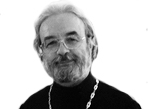
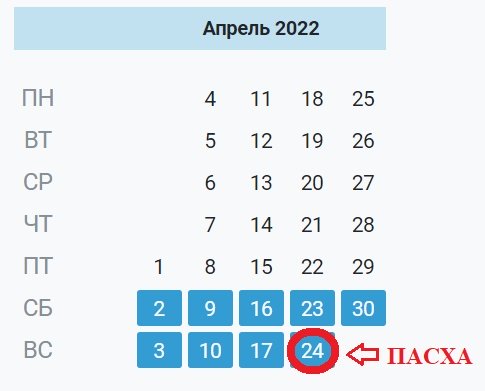




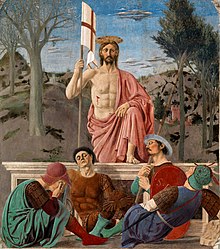


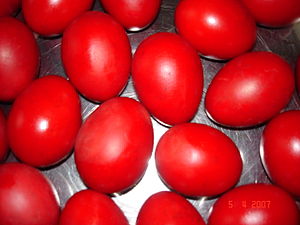


![Easter eggs, a symbol of the empty tomb, are a popular cultural symbol of Easter.[24]](https://upload.wikimedia.org/wikipedia/commons/thumb/1/10/Easter_eggs_-_straw_decoration.jpg/267px-Easter_eggs_-_straw_decoration.jpg)


